

My route.
After my first ride through Latin America , I tried 2 times to repeat the ride without success. First time it was an incompetent shipping agent in Los Angeles who couldn't arrange for "vehicle inspection" even though I planned everything with him several months before. Second time, I got Covid and couldn't fly into Chile where I had bike waiting for me.
Finally, stars have come into a perfect alignment. A friend in Colombia kindly offered me to ride his bike. I simply couldn't turn down such a kind offer.
During the first ride, I had to "check off" the names one most often hears - Machu Picchu, Canyon del Pato, PanAmerican highway, etc. This time, I was more interested in riding tertiary roads and visiting smaller towns and villages, staying high up in the Andes and going deeper into the Amazon basin.
My ride for the 5 months - 1993 Suzuki DR650 with 173,000km on the clock when I started, was getting a new cylinder and piston when I arrived in Colombia. By the time I was done with the ride, this puppy had over 200,000 km.

At this point, I was questioning my plan to ride this bike all around South America.
Retaining clip had fallen out and the pin holding piston attached to the rod damaged the cylinder.

Damaged cylinder, to be replaced.

Testing new cylinder and piston with the mechanic who fixed the bike on local jungle roads.

I brought with me cleaned oiler that I was using in Southern Africa a year earlier. I installed it to continue testing it.
While test riding bike to places of interest in Eje Cafetero (coffee growing area of Colombia), I enjoyed good company, local food and fruits.
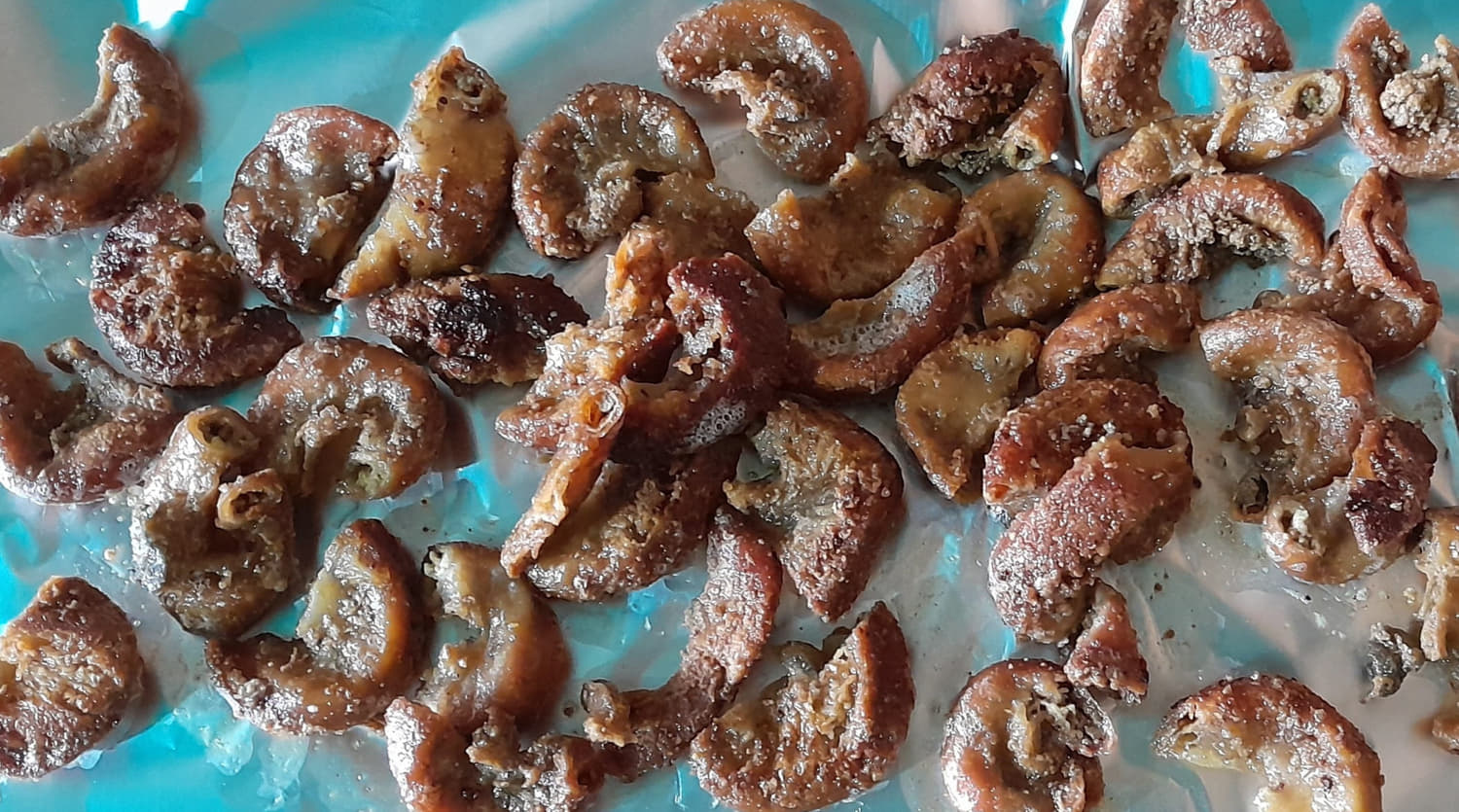
Chuncullo - fried pig intestines, a true delicacy.

My friend likes this dish - trout fillets and vegetables in coconut sauce.
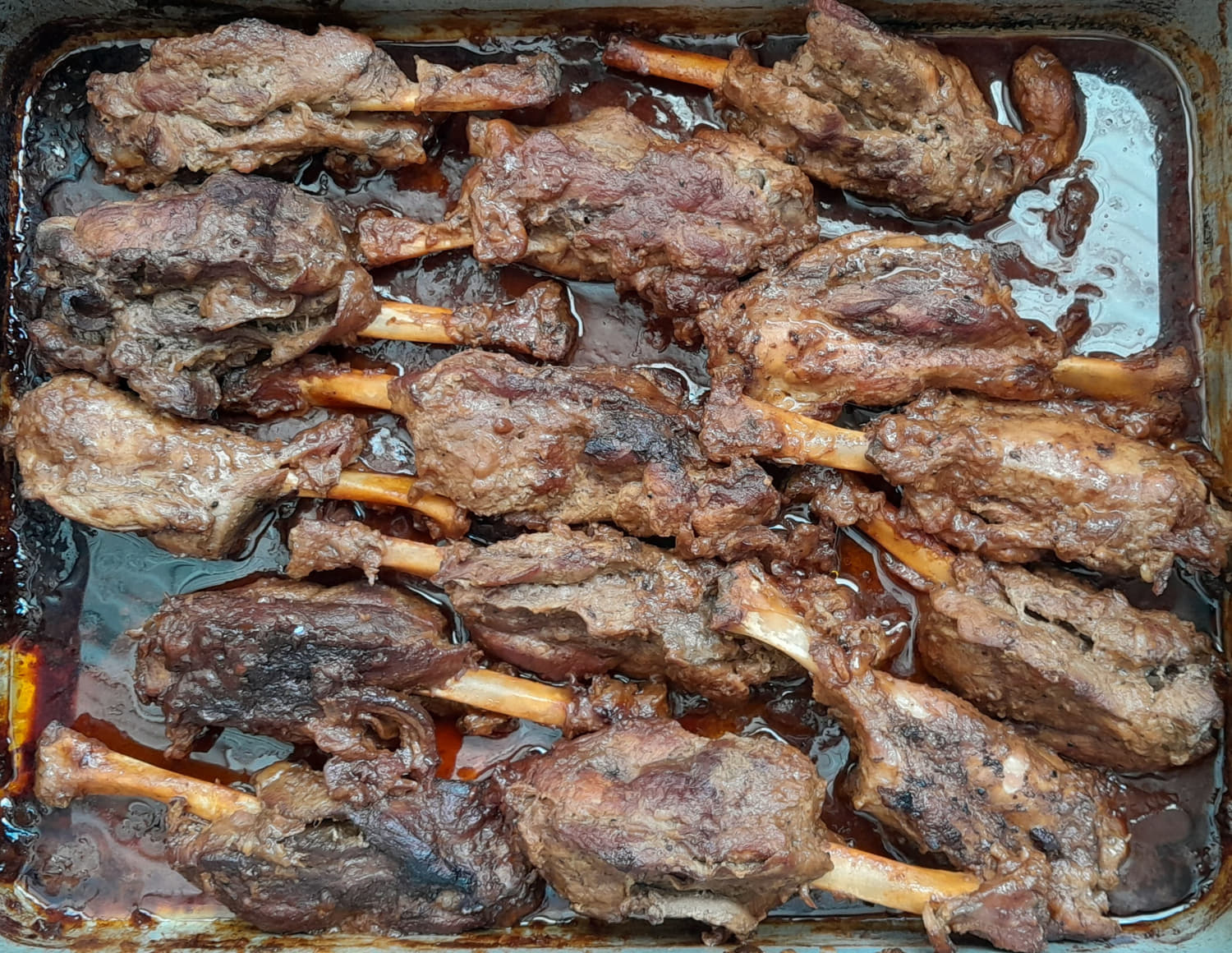
This was my favorite dish - sauteed and then baked pork legs.

The meet goes well with steamed veggies.
While I had good food, it's the amazing variety of fruits and juices that appeal to me the most in Colombia. Maracuya and Lulo are my favorite for juices. When cut in pieces and mixed with condensed milk, they are called Maracuyazo and Lulada.
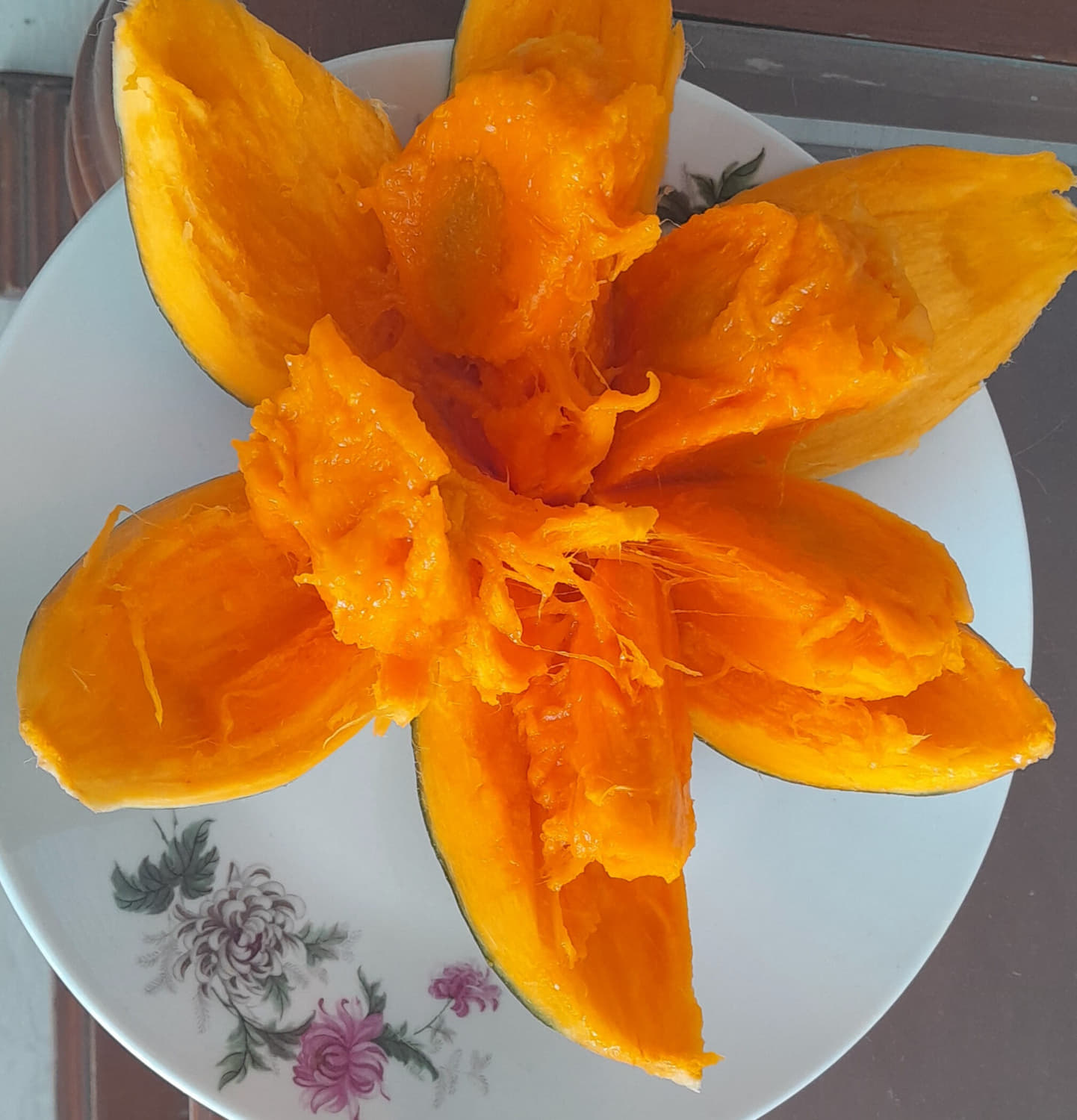
Zapote was in season.

Maracuyazo and Lulada.

Lulo, cut up and ready for blending.

My friend has these gian parots. They are not particularly friendly and have giant and very sharp beaks, so I kept my distance.
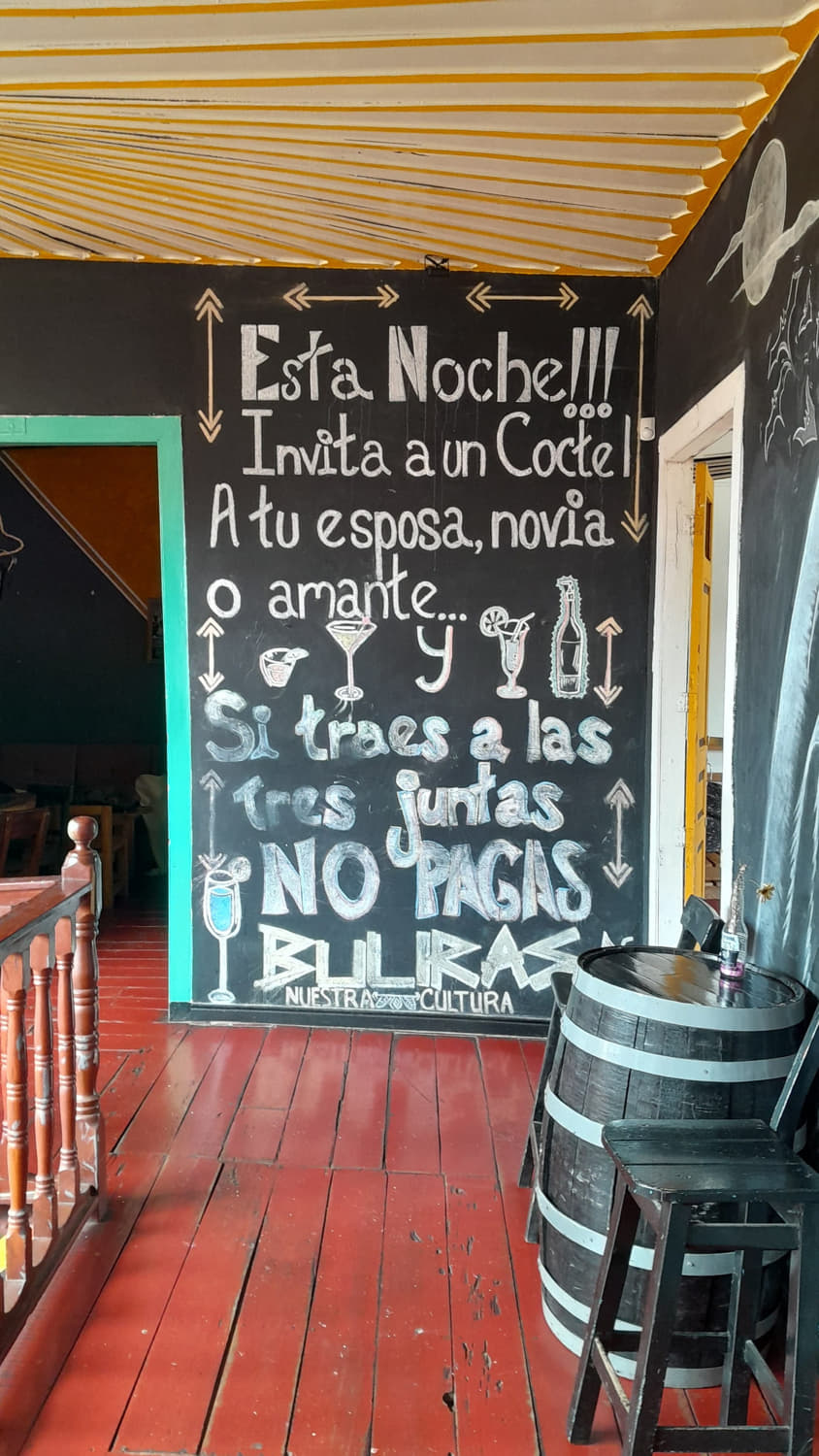
You can bring your wife, girlfriend and mistress. If you bring all 3 of them together, drinks are free - a cozy cafe in Sevilla.

Pre-departure gathering.
Finally, it was time to head south to the border with Ecuador. I had tested new piston and cylinder for almost 1000km, but still didin't have full confidence in it. So I took it easy and spent three days getting to Ipiales.

Popayan, the white city, was the first stop.

Popayan has a number of churches.
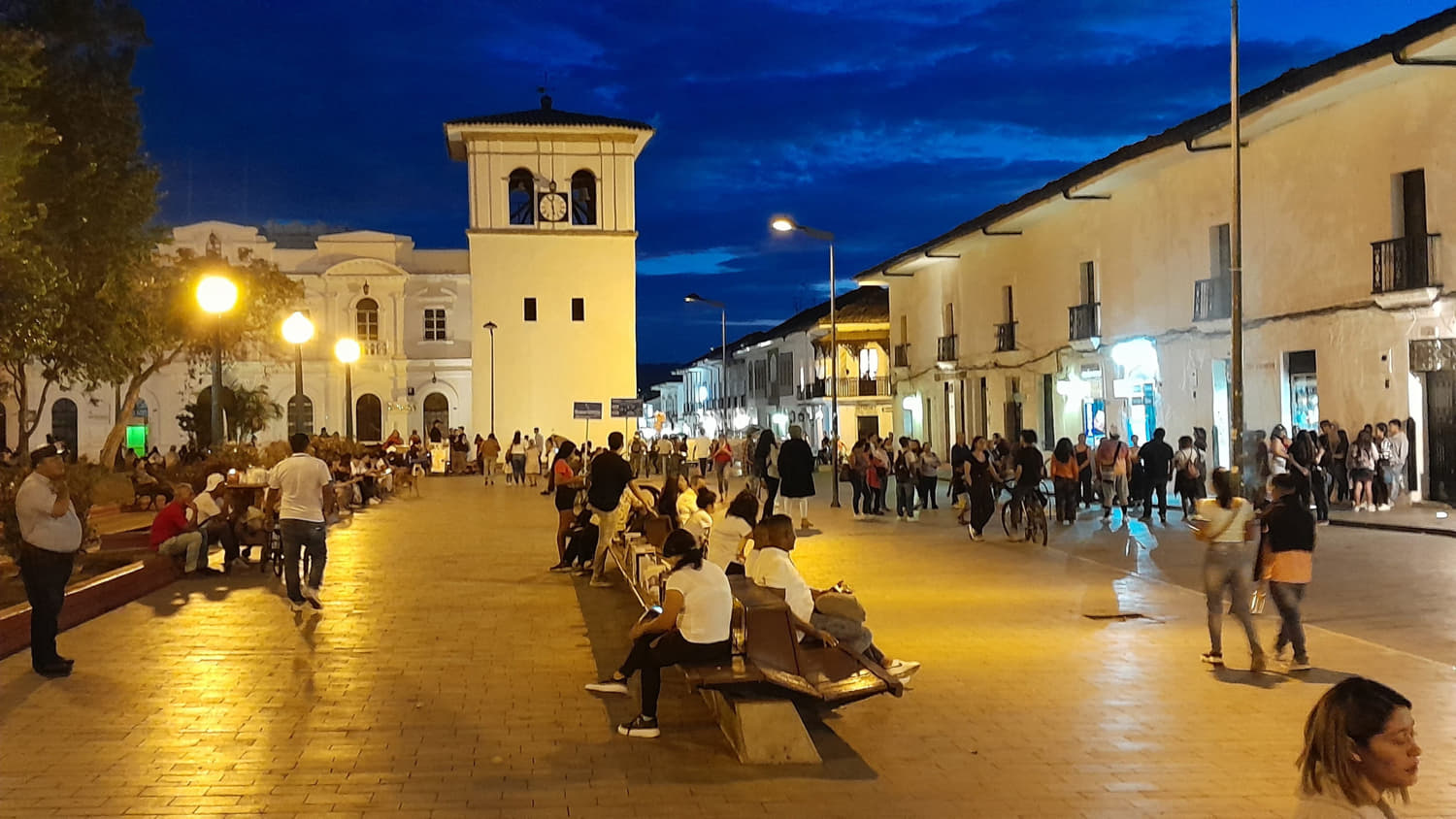
Central plaza is the place to be in the evening.

First two weeks: about 4,000km around Ecuador.
What was supposed to be a routine border crossing turned out to be a rather frustrating experience. When I visited Ecuador last time, seven years earlier, I exited the country at an obscure border post, on river Napo. They didn't have computers there and unbeknownst to me, my exit from the country was never entered into their computer system. So, for the immigration officials, I was still in Ecuador!
I had to wait for two days at the border for the boss to show up and clear my case. He had to call that remote border post, ask them to dig out 7-year old books and find my exit data. Amazingly, they DID! A 3rd world solution to 3rd world mistake.

Farms at over 3000m near the border.
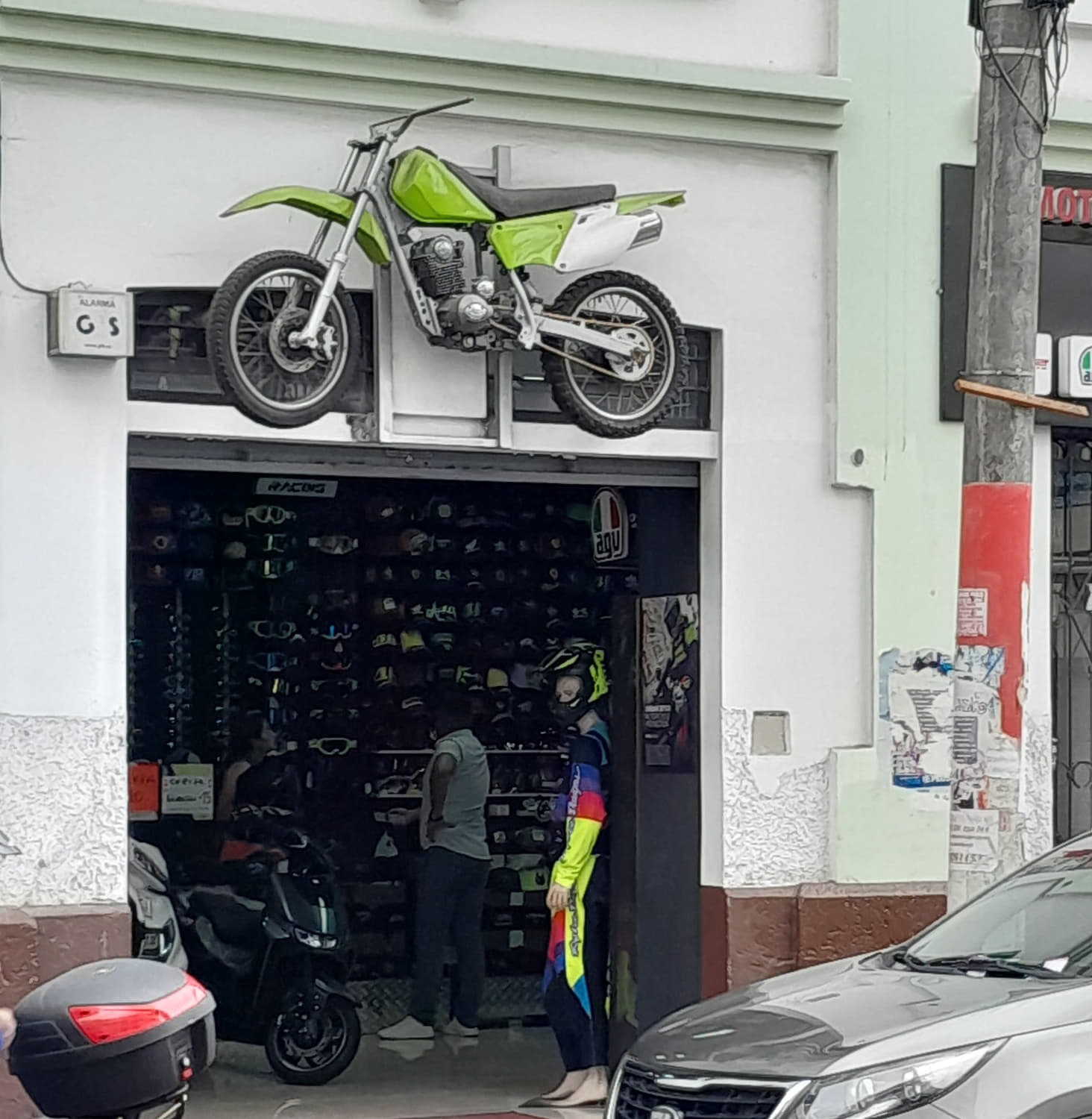
Motorcycle art in Ibarra.
After finally getting into the country, I made my way to Ibarra and spent a night there. I wanted to ride a road going east along the border and the weather seemed better on the east (Amazon) side than to the west. So, I left Ibarra early in the morning and backtracked 80 km.
First 20 km were paved and in perfect condition. After that I continued on a dirt road for about 120km along the border with Colombia. The scenery was wild and beautiful and thankfully, there was almost no traffic.
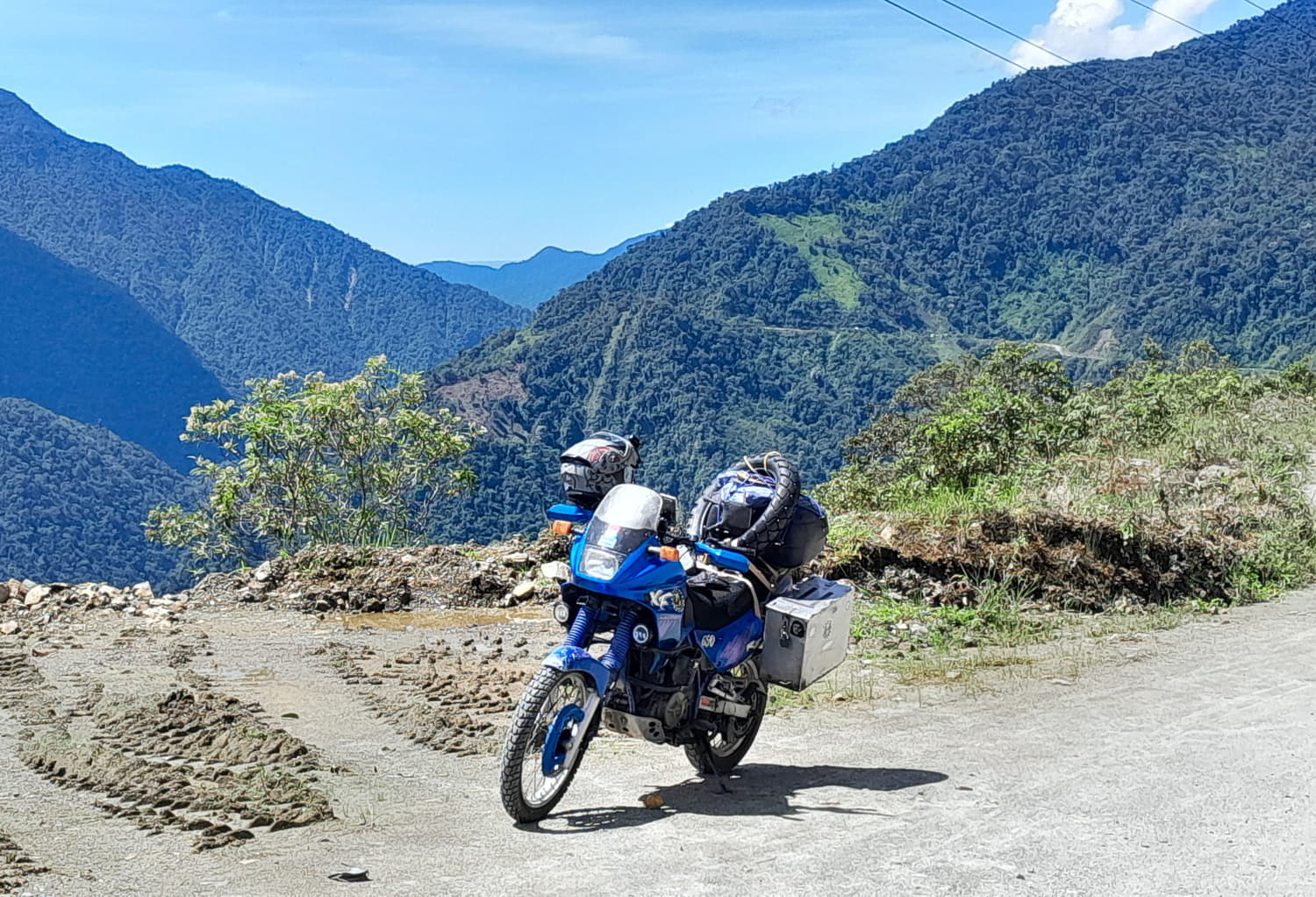
Jungle-covered steep mountain sides and the river below marking the border between Colombia and Ecuador.

One of numerous waterfalls along the road.

Jungle at the foothills of the Andes.

View of the vast Amazon basin.

Finally a real jungle experience. Next to my motorcycle were dozens of butterflies, like the one below.
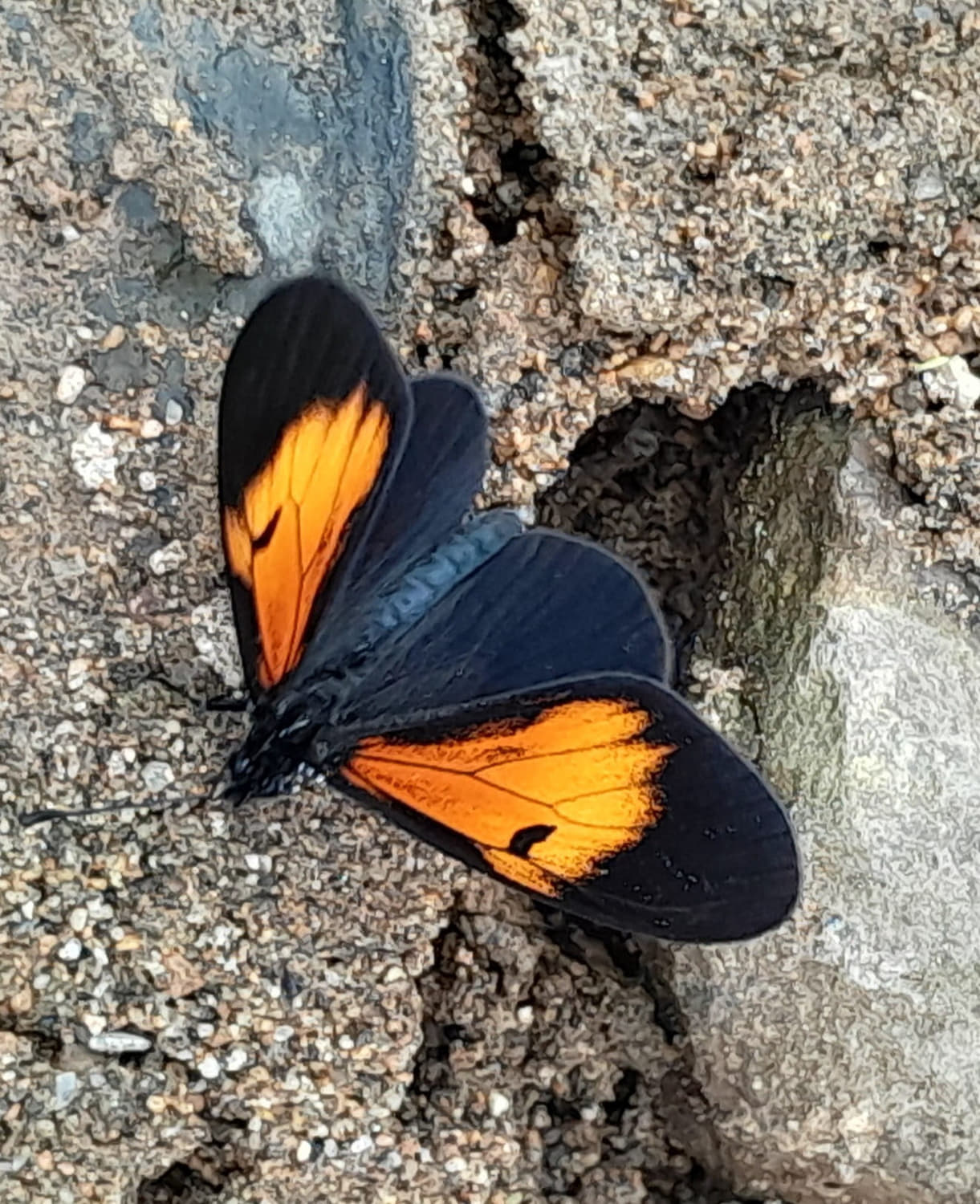
Butterflies in the Amazon region.

Suspension bridges, like this one, are quite popular.

After seven years, on river Napo again, not far from the border with Peru where officials did not enter exit/entry data into the computer system.
I rode a dead end road far east from Lago Agrio, deep into the Amazon basin. When I stopped, I noticed my boot covered in oil and oil leaking from the engine. Did I damage my friend's bike on that dirt road? I topped up oil and rode back to town.
Next day, I stopped at a road-side motorcycle repair shop and asked about the problem. The guy immediately replied that it was the gasket. He quoted me price, but he didn't seem particularly eager to start working on the bike. So, I rode off hoping to find a more decent shop in a bigger town.
After checking into a hotel in next town, I rode around and found one motorcycle shop. They said they could fix it. Getting a gasket in some small town in the USA or Europe would take several days if not weeks. 3rd world solution is much faster and cheaper. Even small towns have shops where they simply cut asbestos paper in the shape of the engine part. Next day, by 10AM, my bike was ready with a new gasket.

What can possibly go wrong with a 30-year old bike with 170,000km on the clock?

Troncal Amazonica .
Troncal Amazonica turns west at the south end and climbs up into the mountains. It's amazing how quickly temperatures drop when climbing Andean mountains.
I spent only one night on the Pacific coast. I remember not being impressed by the Ecuadorian coast when I rode bike 14 years ago. Roads are dirty, trash everywhere, towns unappealing and dangerous, or so was I told.

Clouds from the Pacific pushed against high Andes.

Chimborazo volcano, 6300m.
I climbed back up into the cold mountains and spent a night in Riobamba. Next morning, I started riding early and made a loop around Chimborazo volcano before clouds moved in. By 9 am, the whole mountain was obscured by clouds.
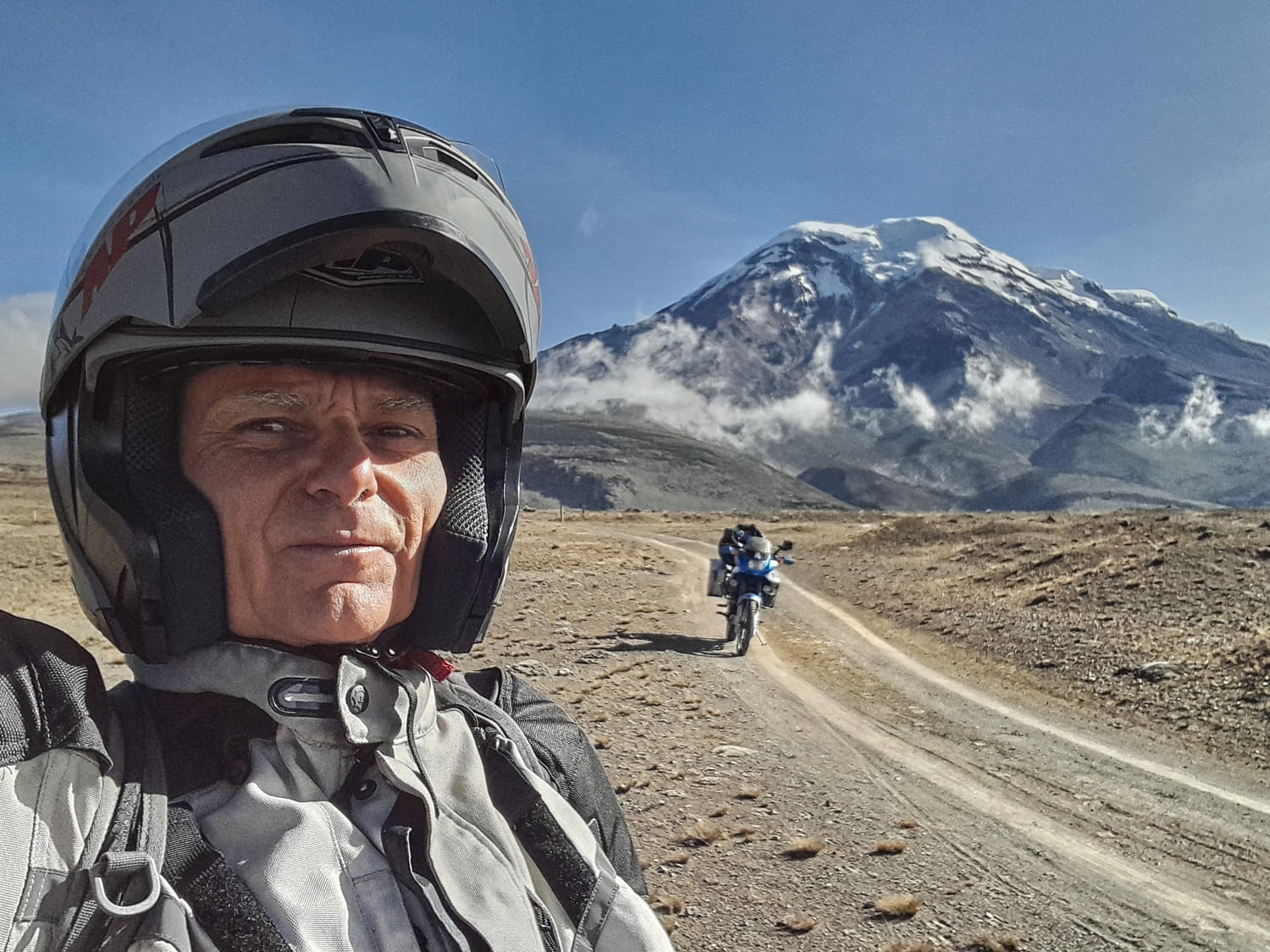
Chimborazo, 6300m volcano. Elevation at the point where this photo was taken was about 4300m, slightly lower than Mt. Whitney, the highest peak in the lower 48.
A half day ride from Riobamba is Quito and Papallacta hot springs. There, I met friends who rode from Cartagena. We spent next few days riding together.

Misahualli - tiny town, but probably my favorite in Ecuador.

Pleasant guesthouse on river Napo.

Resident monkey in Misahualli's park.
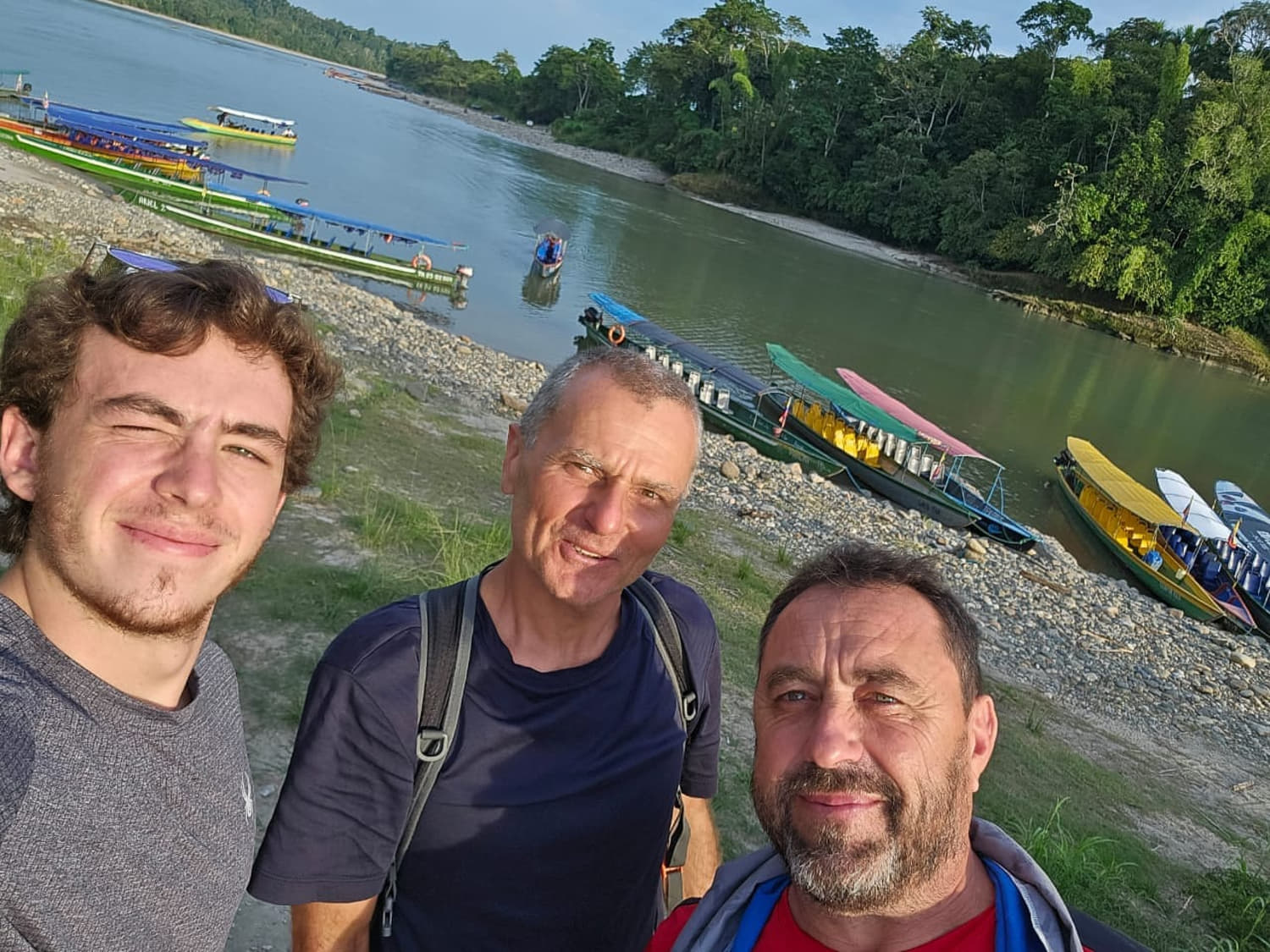
With friends by river Napo.
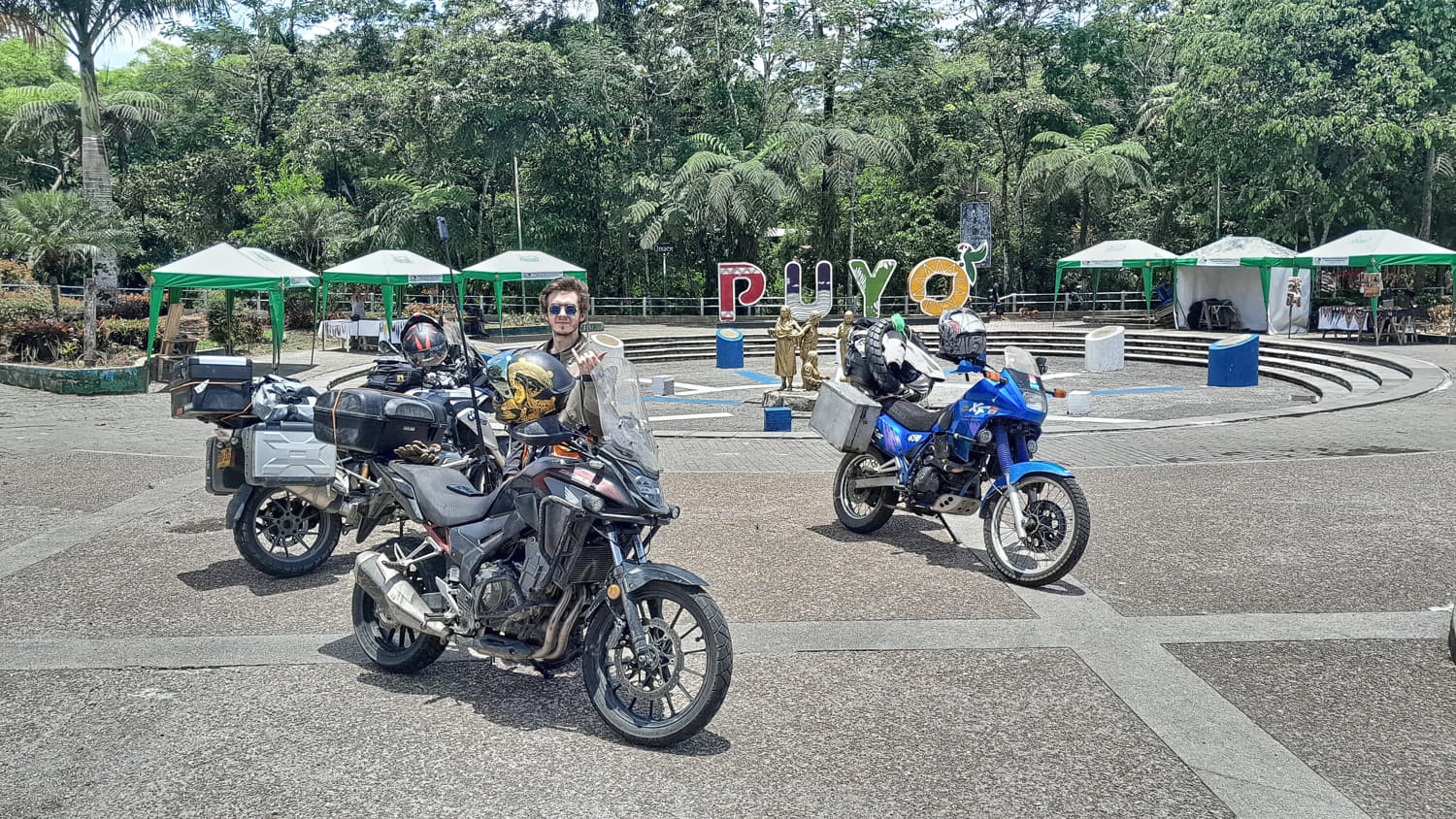
Lunch break in Puyo, a major town along Troncal Amazonica.

I had to re-position and replace oiler dispenser as the first one was damaged by flying rocks.

Ecuadorian roads are generally in excellent shape, especially considering how unstable the Andean slopes are.
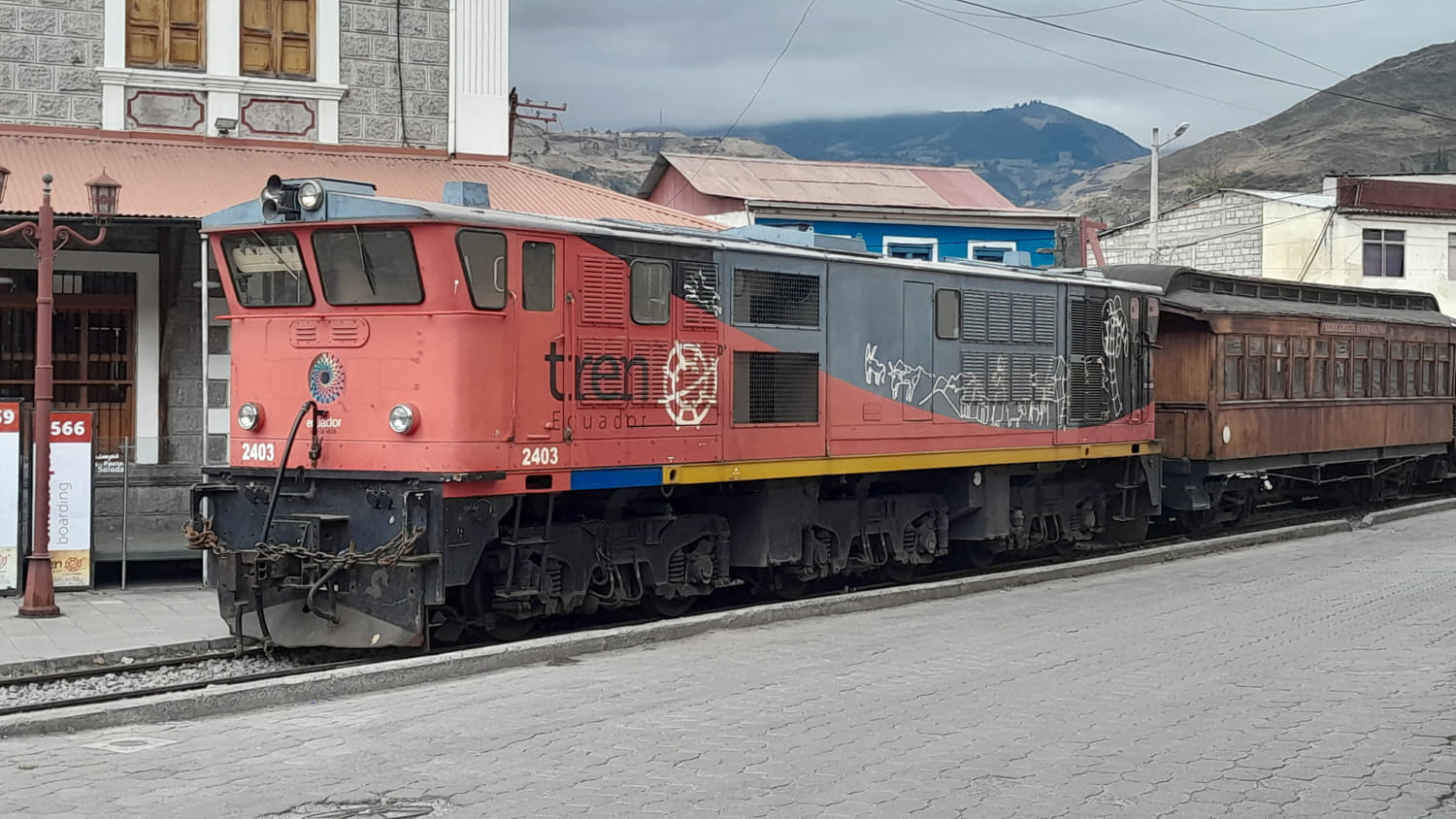
Famous train that traverses Nariz del Diablo. Not in operation, much like when I was in Ecuador last time.

Ingapirca, a major Inca site in Ecuador.

Incas are famous for building tightly-fitting stone walls.
Cuenca, a UNESCO heritage city and an expat enclave was next to visit. Even though I liked it a bit more than the first time I was there, it was still too cold for me. So, I rode back down east for some tropical heat.
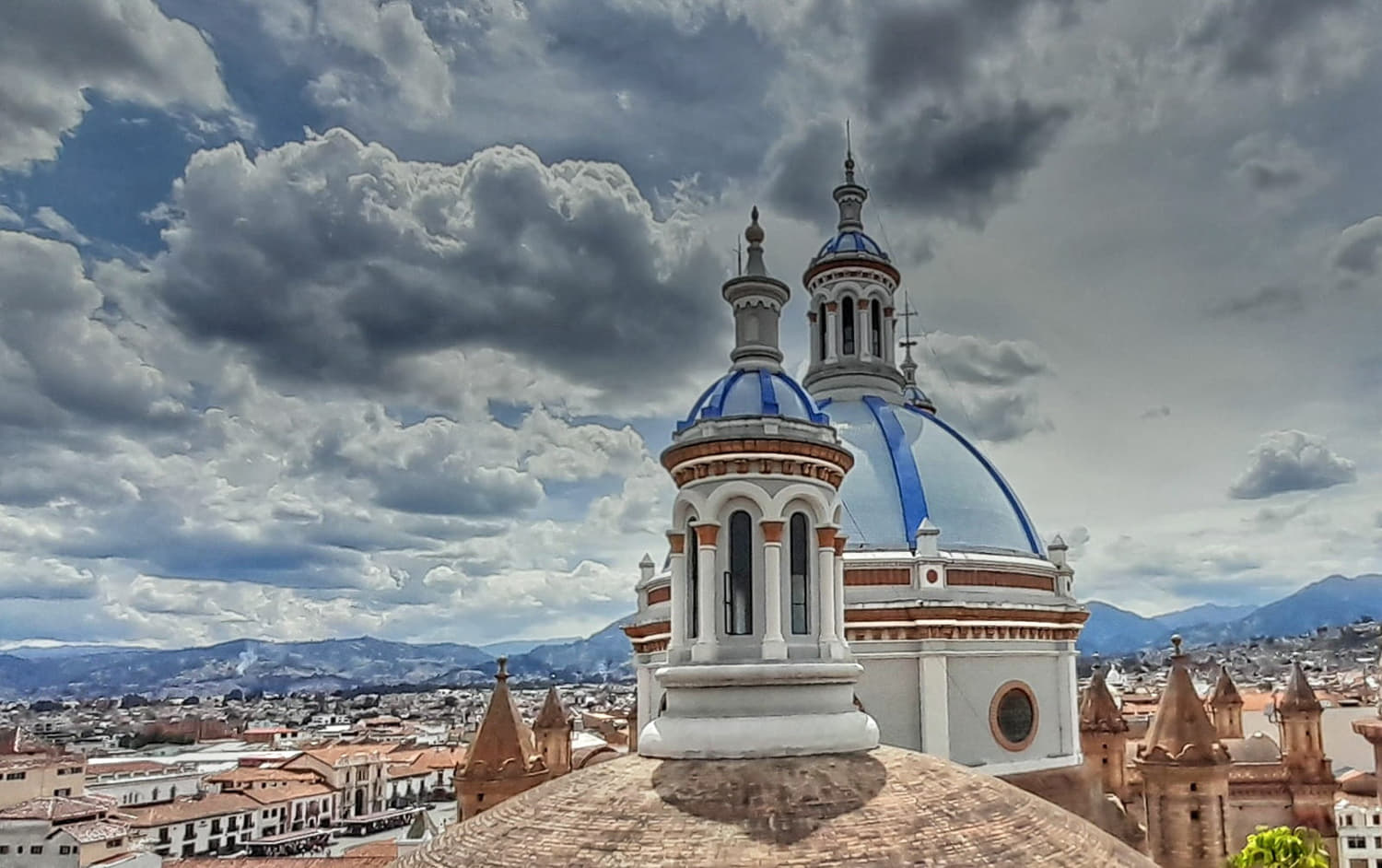
Domes of Cuenca's cathedral.
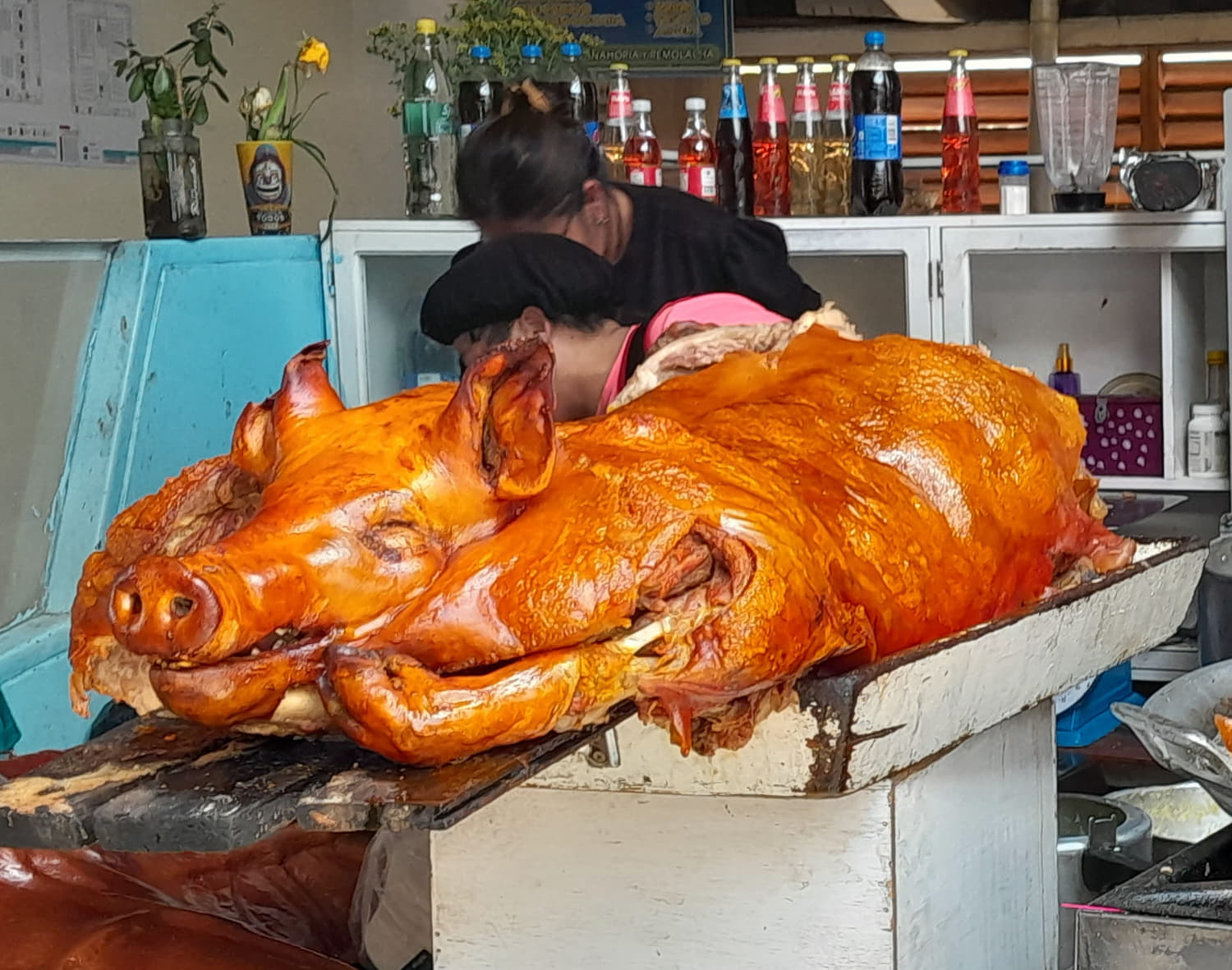
I saw pigs being roasted while riding, but didn't bother stopping. In a Cuenca market, I managed to try it. It was excellent.

This is how they serve the pork.

Local market with fresh fruits and vegetables.
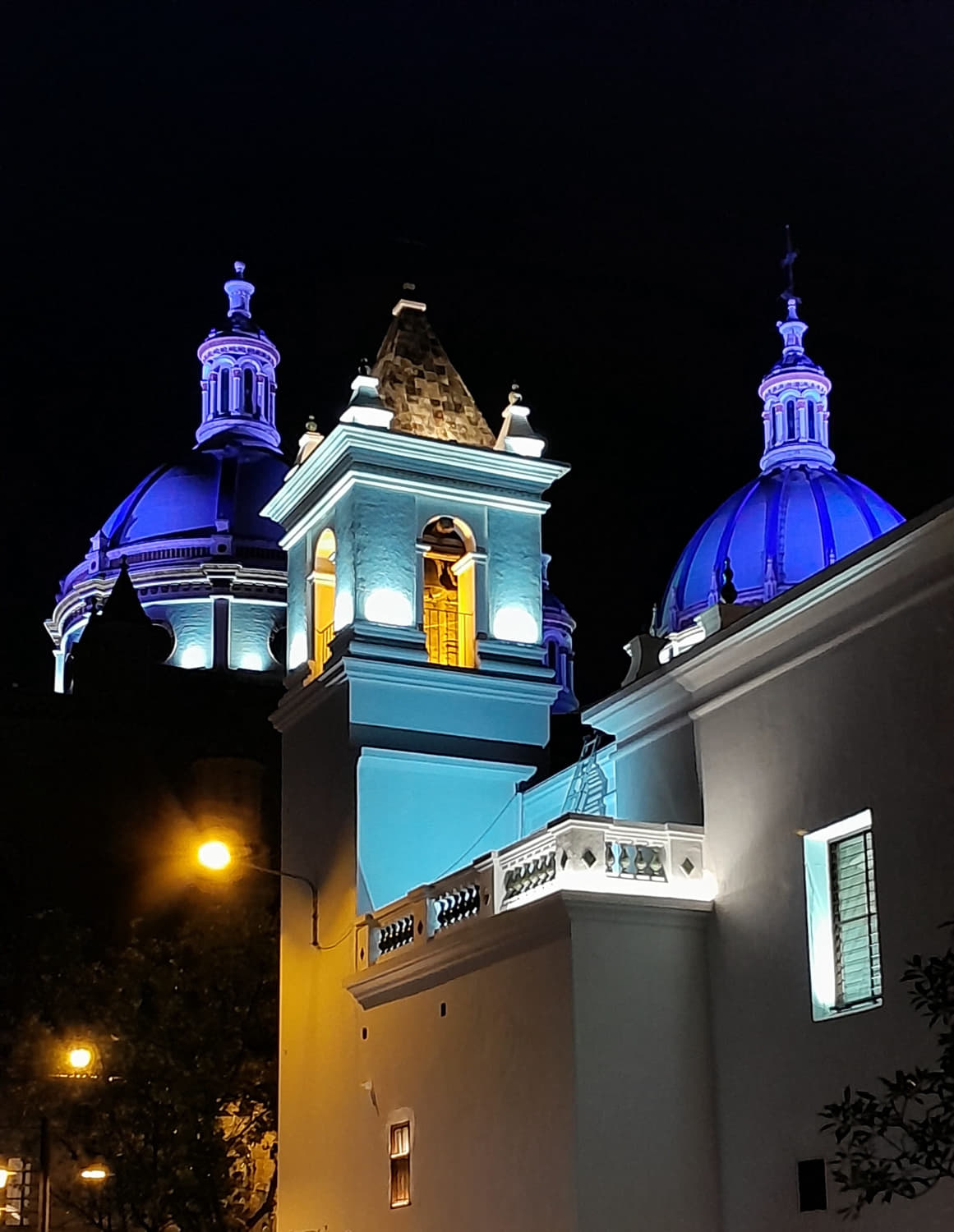
Cuenca at dusk.

Central park in Cuenca.
A week earlier, I got rained on crossing Andes from Zamora to Loja. This time, the weather forecast called for clear skies, so I decided to ride the same road in good conditions, what a difference!

Dirt road hugs steep mountain slope as the clouds advance from the Amazon.

Below cloud base, but still long way to the bottom.

The road climbs up from Zamora.

Waterfall between Zamora and Loja.

An old bridge on the way to Loja.
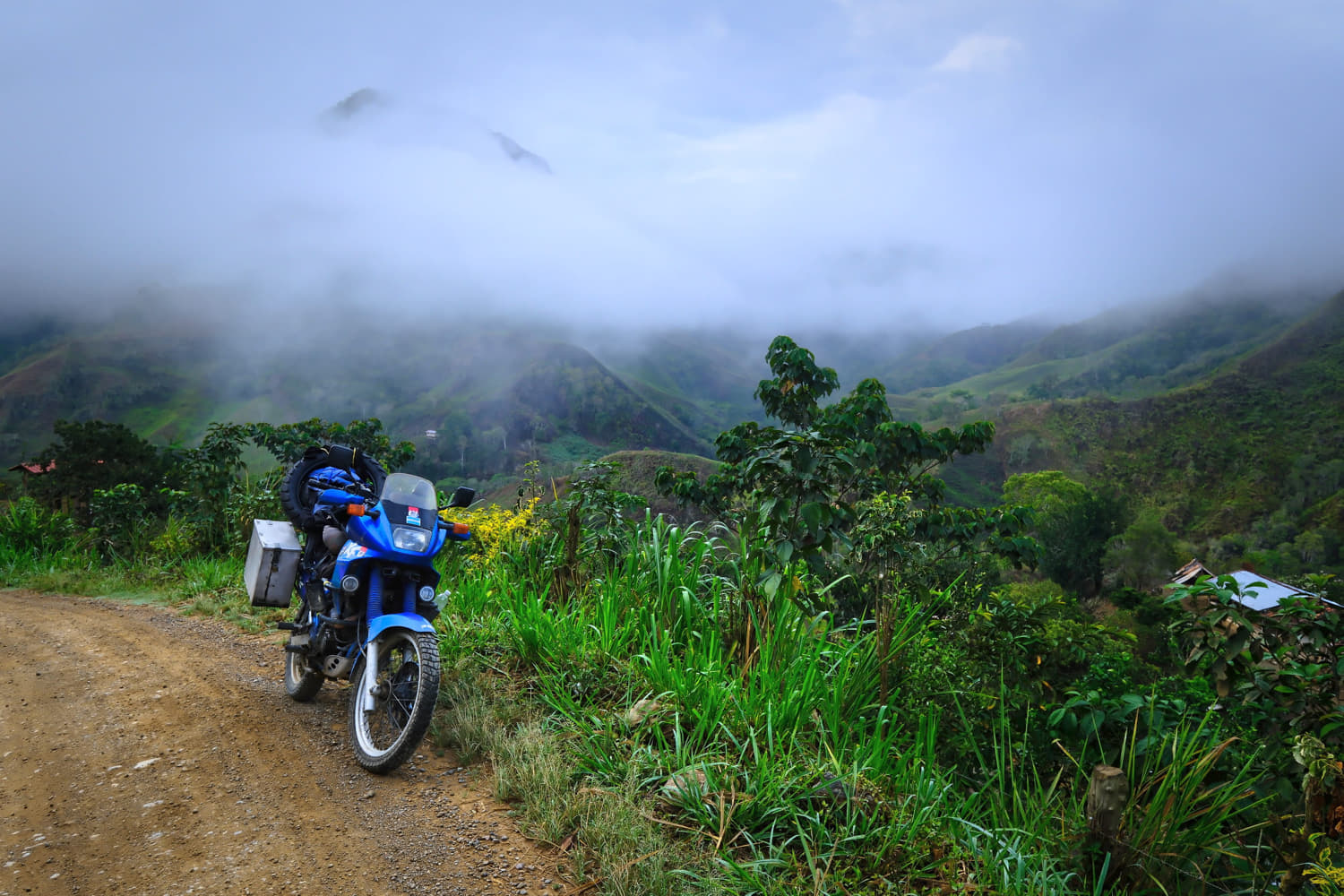
The last 80km to the border with Peru were a simple dirt track.

One month and 6,000km in Peru.
I crossed from Ecuador into Peru at a sleepy border post of La Balza. As reported by many other travelers, Ecuadorian side took more than an hour due to the lack of computers and bad phone connection. Peruvian side was a lot more organized - new offices, immigration and customs officials in clean uniforms.

Rice fields just south of Jaen.
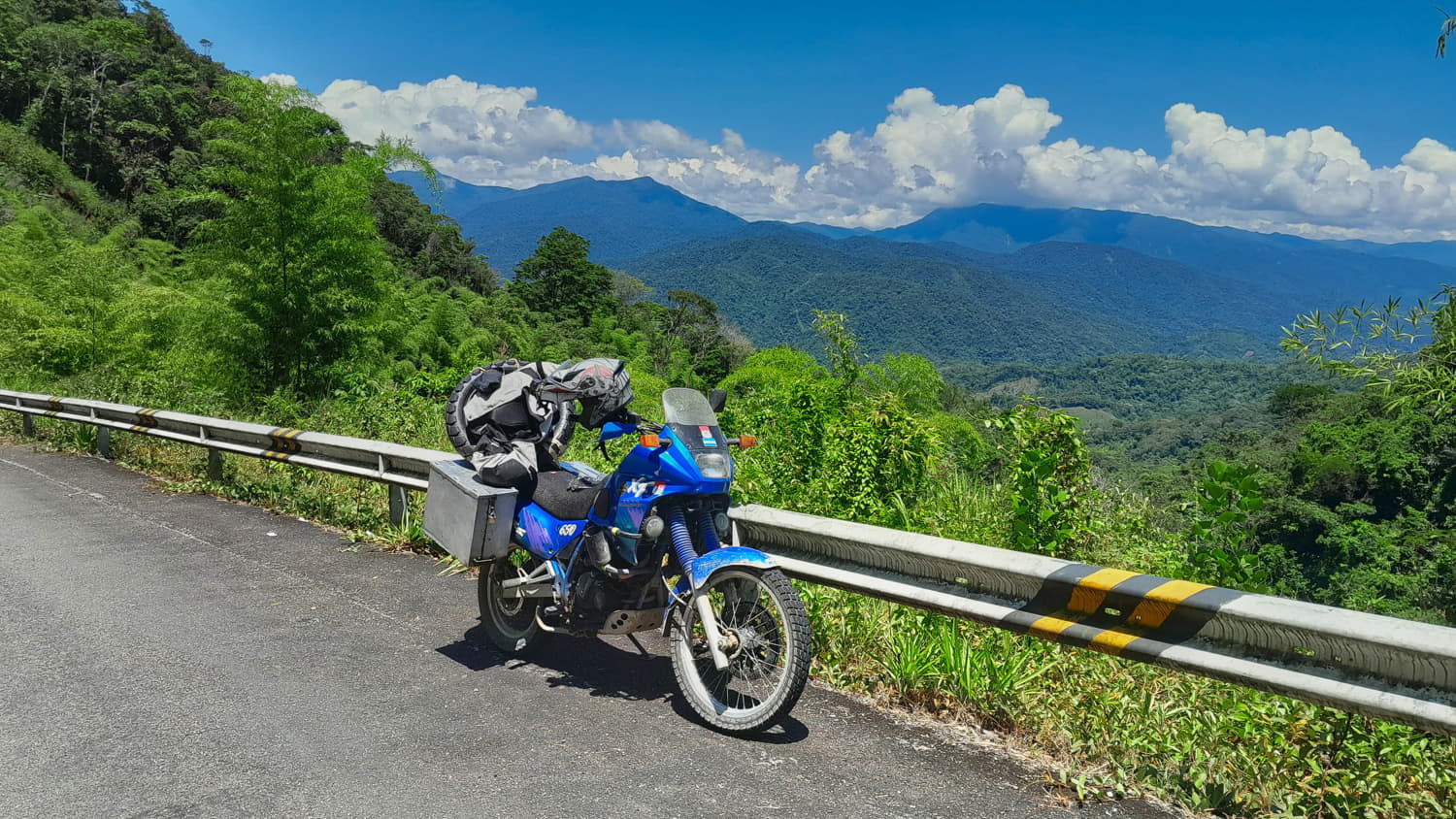
Ride through lush jungle-covered hills NE of Jaen.
A beautiful, new road took me past San Ignacio to Jaen. After a night of good sleep, I headed north-east into the Amazon basin. First 50 or so kilometers the pavement was in good shape. For the remaining 150+km, I could barely see any remnants of the asphalt. Actually, a gravel road would be much smoother than broken pavement.

Vegetation is so lush in the Amazon basin.
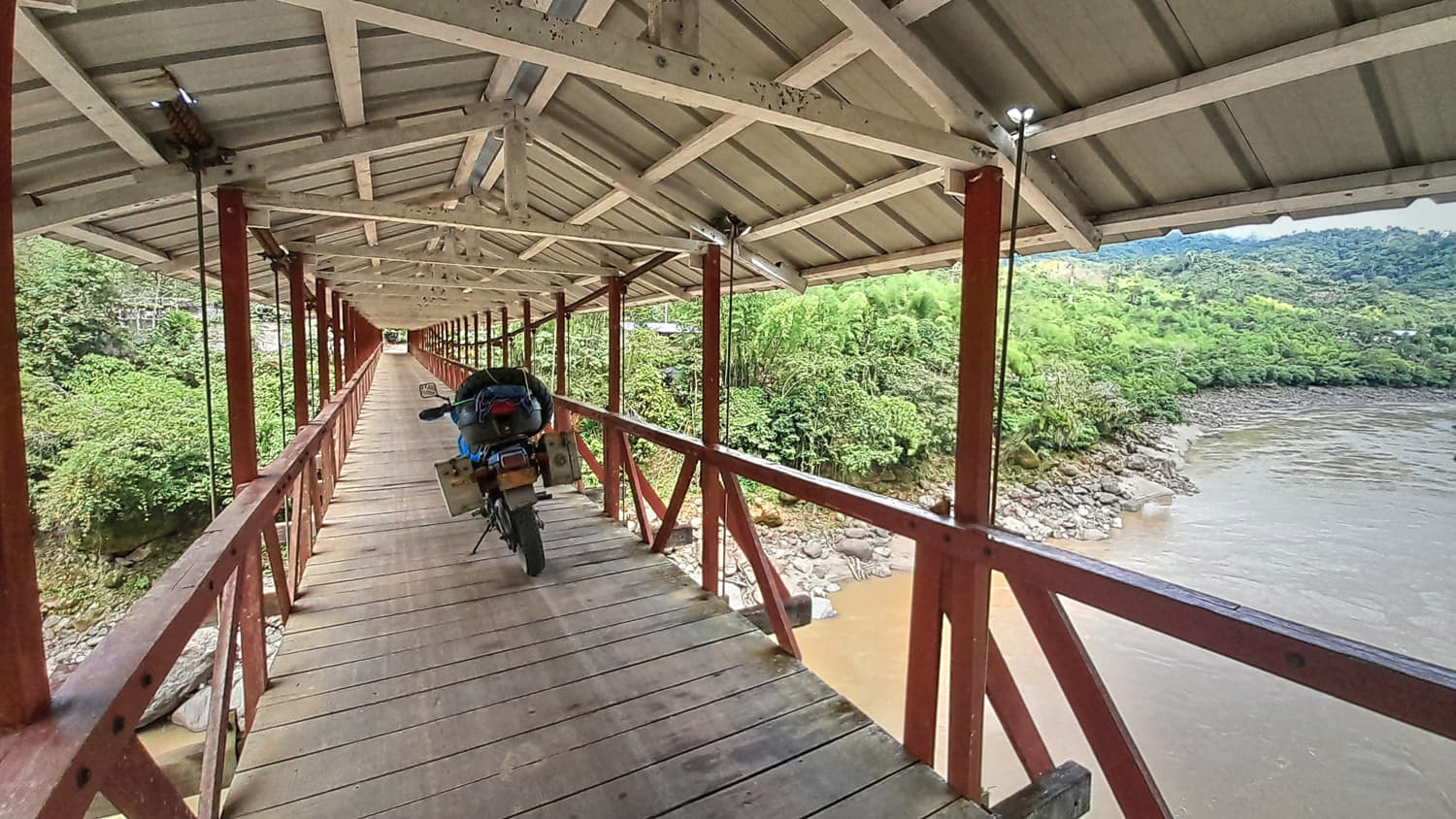
A covered suspension bridge over Rio Marañon.
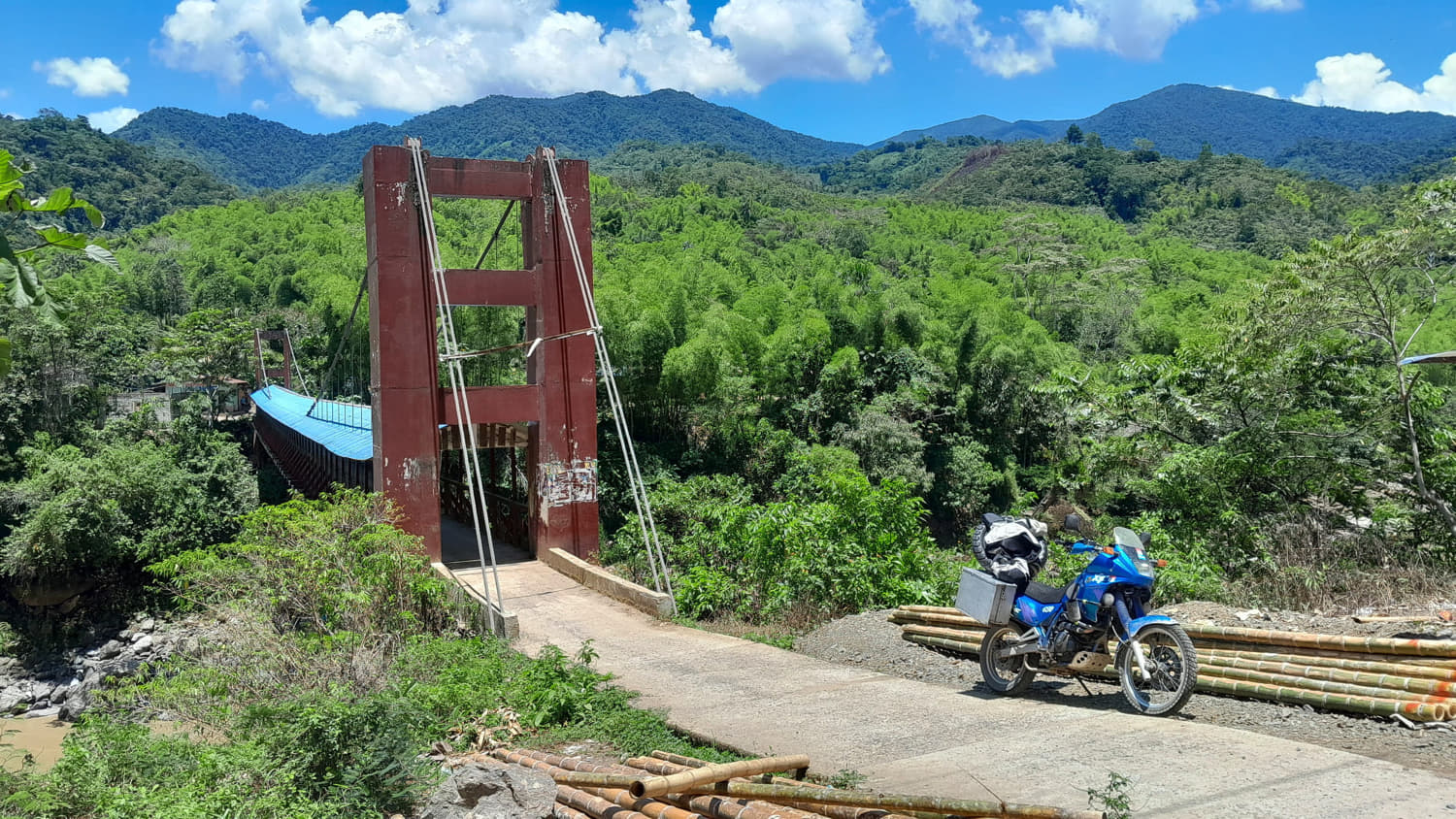
Suspension bridge over Rio Marañon.

A beautiful waterfall in thick jungle.
Eventually I made it to Santa Maria de Nieva on the banks of Rio Marañon, the baby Amazon. It was significantly bigger here, some 200km downstream from where I first crossed it just south of Jaen, but still nothing compared to the monster it eventually becomes. Ride through the virgin jungle was a pure pleasure, despite bad surface as there were very few other vehicles.

The road winds in and out of bamboo groves.
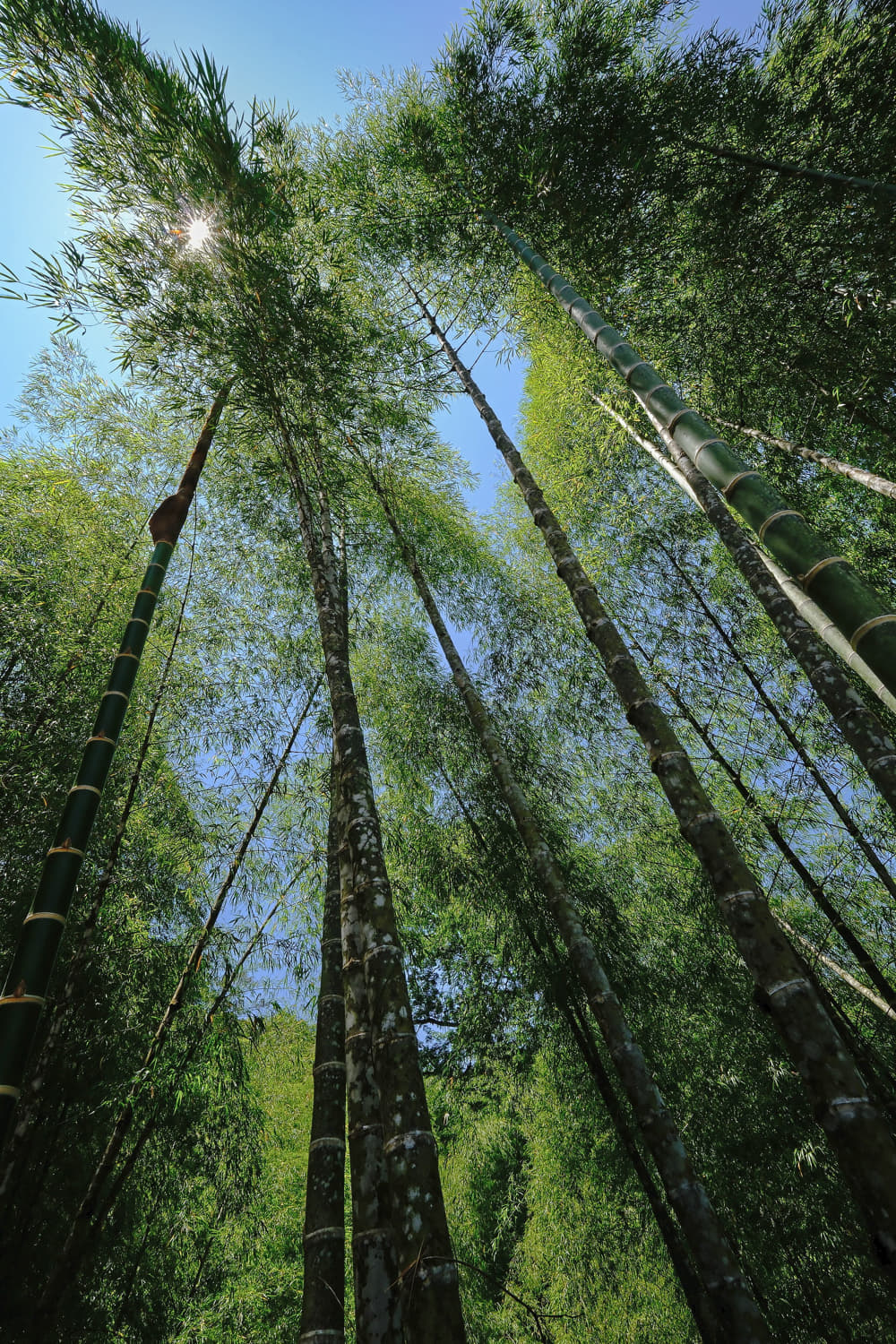
I am always fascinated by bamboo groves.
Next day I rode back on a parallel road which was in equally bad shape. Still, riding through some villages and jungle in beautiful weather was a pure joy.
By the time I got to the main road, it was early afternoon. I looked for a few hotel options and did not like them. I decided to push on towards Chachapoyas, a major tourist center. Afternoon rain showers prevented me from reaching Chachapoyas and I spent a night in a small town. That's when I discovered that my brake pads were completely gone at the back and 95% gone in front. I couldn't continue on Peruvian mountain roads without brakes.

Brakes a for sissies, real riders need only a disc.
Next day, I carefully rode to Chachapoyas trying to use brakes as little as possible. Needless to say, they didn't have pads for my bike there. Locals do not worry about unavailable vehicle parts. Your neighborhood "Frenocito" can vulcanize brake pads. My friend told me that he had done it on one of his bikes and braking material fell off soon after. So, I was not too keen to ride with braking material glued to the metal, but I had no other option.
Frenocito master scavenges material off some other pads (in my case from round, drum breaks), puts glue on it, presses it against my shaved metal part of the pads and bakes for 45 minutes.

When you need new brake pads, Frenocito is your friend.

New brake pads in 4 easy steps - spread the glue, press new brake pad material, bake it and let it cool.
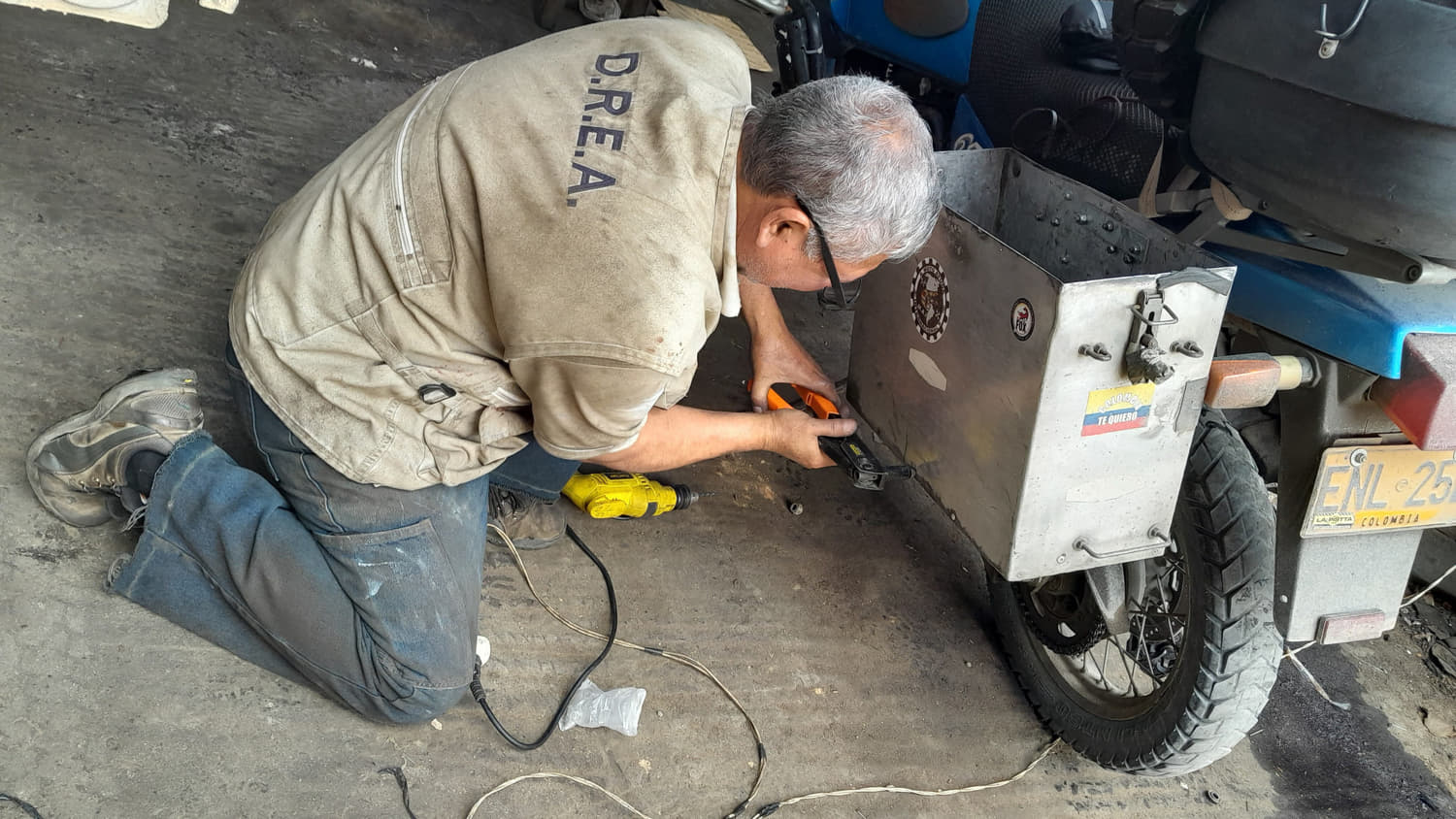
While waiting for the brakes to cool down, another guy strengthened my panniers with new rivets - $0.50 per rivet.

A guy passed by seeling cerviches. I was hesitant to eat raw fish in Peru, especially from a street vendor, but it looked clean and so tempting, so I took my chance.
I was worried how long glued braking material would last. I tested brakes around the town and next day on some steep hills and they held. Once again, 3rd world solutions to 3rd world problems.
Since I lost a day on bike maintenance, I decided to have rear tire changed as well. I had been lugging a new rear tire since Colombia (over 5,000km) and I was getting tired of it.

5 minute tire change can leave you with brake like this.
Tire shop guy charged me $3 for the change, but he rushed both taking the wheel off and putting it on. Despite me being around and trying to catch his mistakes, he managed to install rear brake caliper incorrectly. Luckily, brake line wasn't damaged before I noticed the problem. I also noticed that my chain is excessively stretched and that I need a new one urgently. I did not even bother asking for a chain in Chachapoyas as I knew they wouldn't have it. My best hope was Cajamarca, the next city on my route.
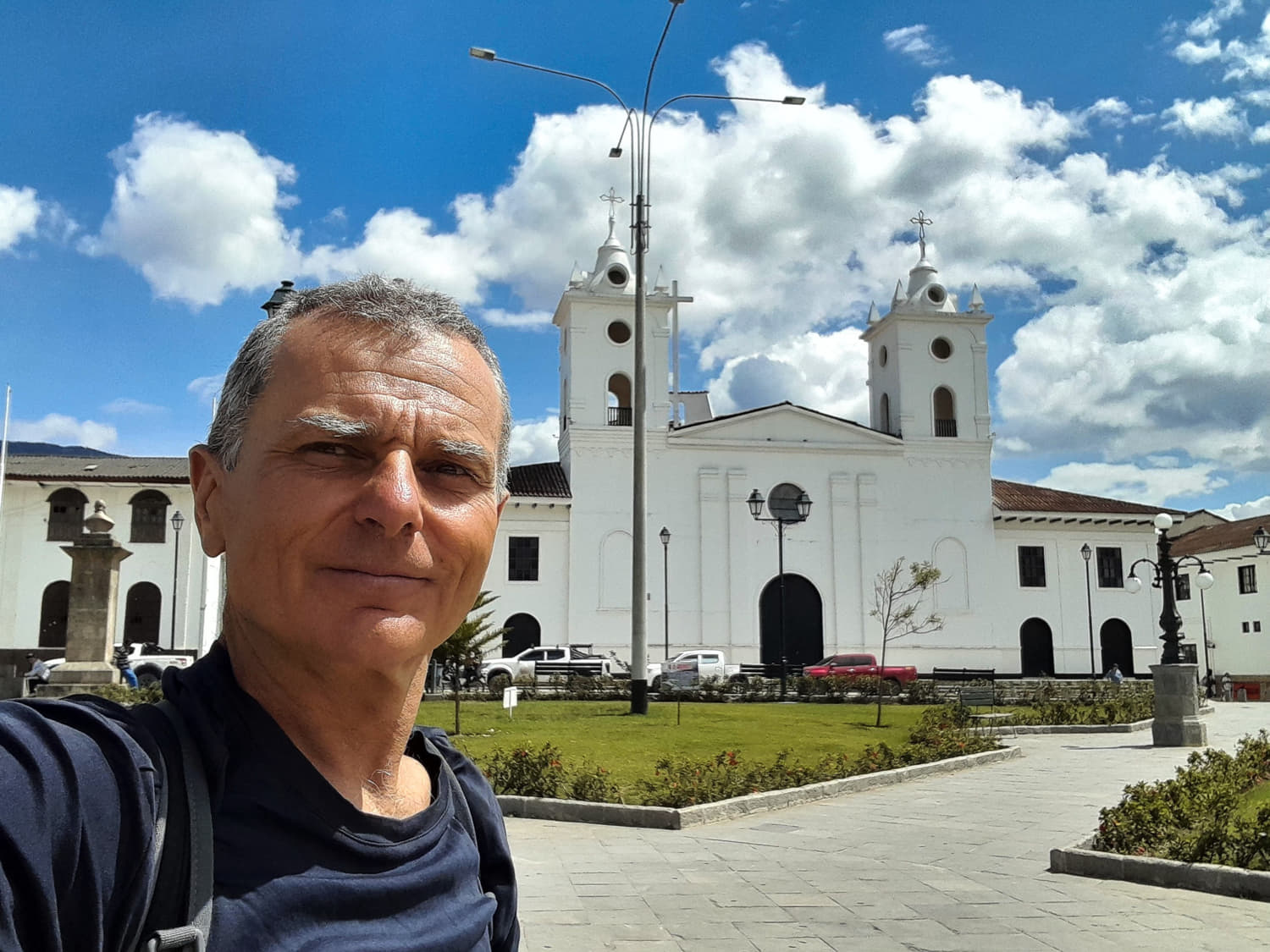
After tire and brake changes, I got to walk around Chachapoyas downtown.

Chachapoyas' pedestrian street at dusk.
Rain delayed me one more day and after 3 days in Chachapoyas, I was eager to move on. I followed a minor road over high passes to Cajamarca. 4300m (13,000ft) passes are quite normal in Peru, while many go as high as 4800m (15750ft), higher than Mt Whitney, the highest peak in lower 48.
Atop Calla Calla pass, which is normally in clouds and rain, I met Jose Carlos, a local rider from Cajamarca. I asked him about a good motorcycle shop in Cajamarca where they might have chain for my bike and he recommended me one.
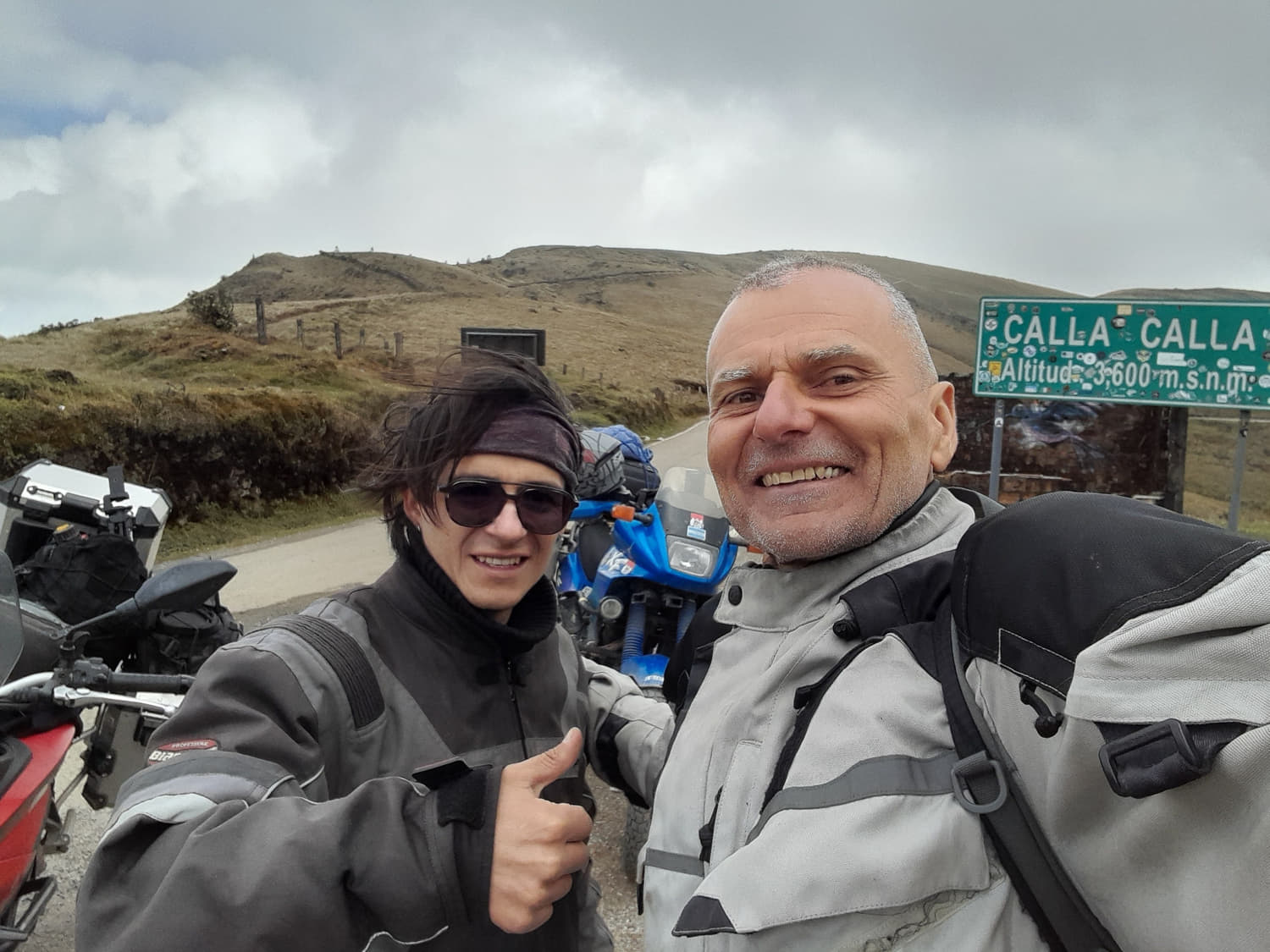
Atop Calla Calla pass I met Jose Carlos, a local rider from Cajamarca.

Long descent from Calla Calla down to Balsas.

Calla Calla pass is on the horizon, already covered in clouds and in rain, most likely.
Next day, Jose Carlos met me in a cafe near the bike shop and accompanied me to the shop. He also helped me get some rubber seals for the oil filter cover and took me around Cajamarca downtown to show me points of interest in his city. I meet a lot of riders, but they are mostly from USA or Europe. It was good to meet a local rider and hear his stories.

Getting a new chain in Cajamarca at Biker Planet shop.

Cuarto del Rescate is where Inca's king Atahualpa was held captive and promised to fill the rooms with gold and silver up to above his head in exchange for his freedom. After getting their gold, Spaniards killed Atahualpa.
After two days in Cajamarca, I was ready to move on. I left Cajamarca early in the morning and was freezing while riding over a 4200m pass.
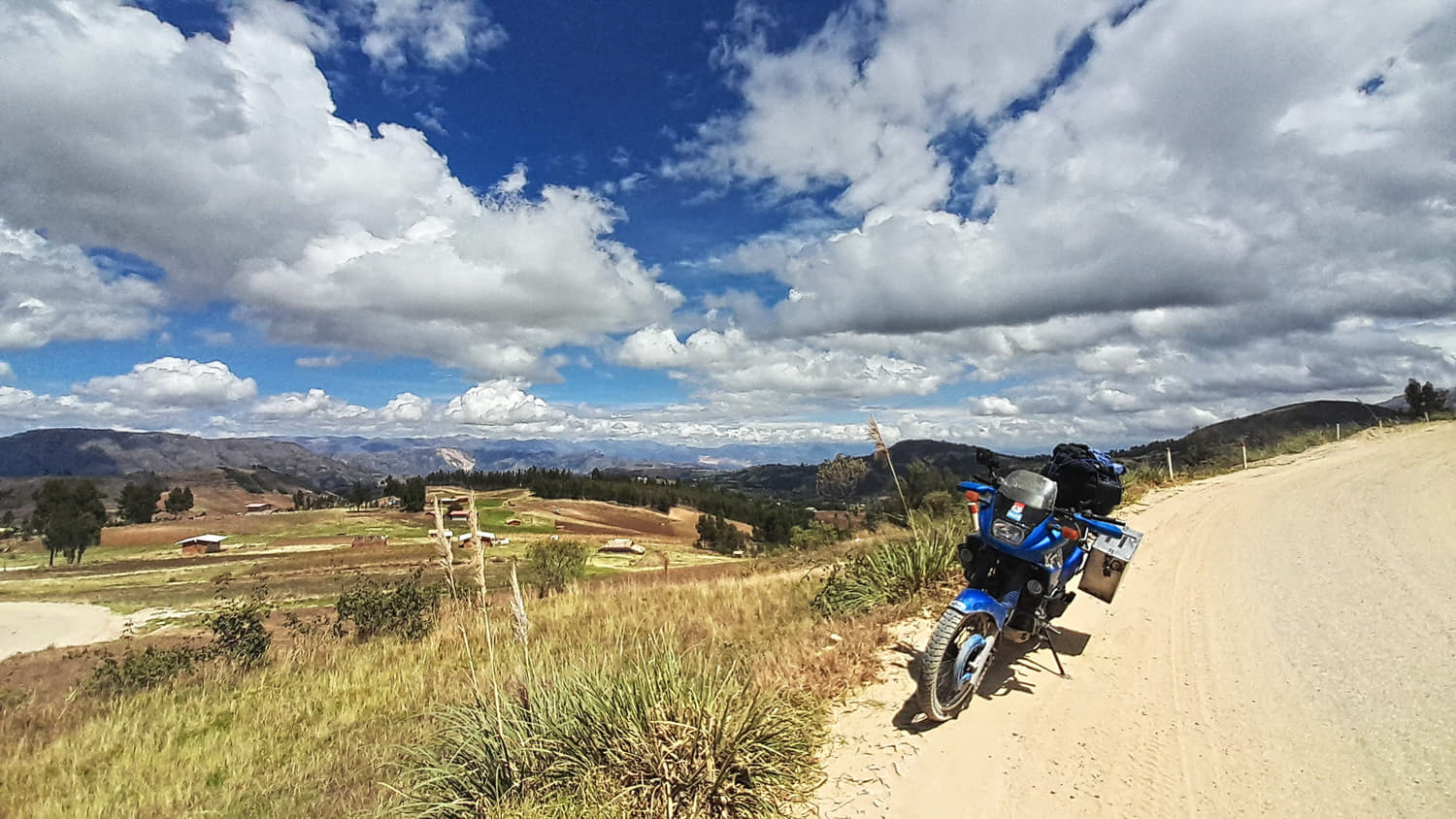
Beautiful early morning ride between Cajamarca and Huamachuco.
Before I got to the town of Huamachuco, I noticed a slight oil leak from under the oil filter cover. In Huamachuco, I stopped by one motorcycle shop and the guy quickly removed cover and smothered edges with silicone and put it back assuring me that the problem was solved.
Well 20m from his shop, I hear a loud explosion and notice a high pressure stream of oil squirting out of a gap under the oil filter cover. I had never seen or heard anything like this. The rubber seal was pushed out through the gap. I never knew that the oil was so pressurized inside the engine.
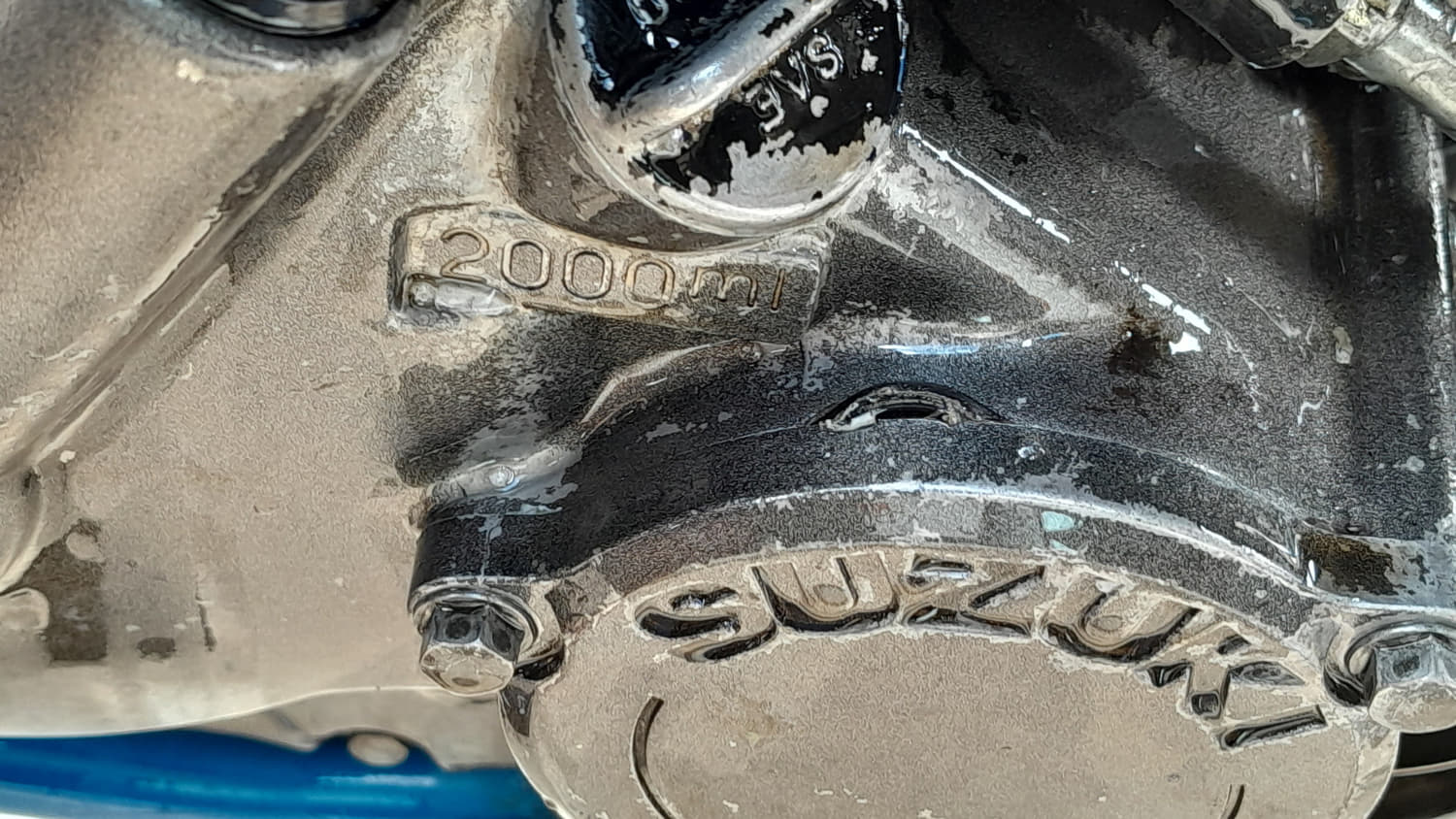
Pressurized oil pushed rubber seal out and squirted all over my leg, parked car and sidewalk.

Oil traces on sidewalk and even building. A white car that was parked next to the shop was sprayed with oil too.
I rolled bike back and the mechanic showed me a stronger glue with smile on his face. I wasn't too excited about using glue over a rubber seal, but I didn't have any options. This time, I let bike sit for an hour for the glue to set.
I took the bike for a test ride. It seemed to hold. Well, it held only long enough to get me far away from the shop before exploding again. The oil spewed all over my flip-flops making me lose all the traction. Now I felt as if I was trying to push the bike on ice. There was even an uphill section I had to push the bike over. After an hour of slipping and sliding, I got bike back to the shop.
The mechanic took the filter cover off and then exclaimed "oh, filter was put in the wrong way!" I didn't even see when he took the filter out the first time. It's hard to put it in the wrong way, but he managed. Well, at least he noticed the problem he had created.
By now, I was paranoid about it happening again, especially in the middle of nowhere. There is no way I could ride bike once it starts squirting oil as the stream is quite strong and it would empty all the oil in less than a minute. So, I tested bike for 10-15km around the town and it seemed to hold. I never had problems with it again, but next few days, I was quite nervous about the possibility of it happening again.

Early morning climb over a high pass above Huamachuco.

After about 100km, I continued on a deserted dirt road.
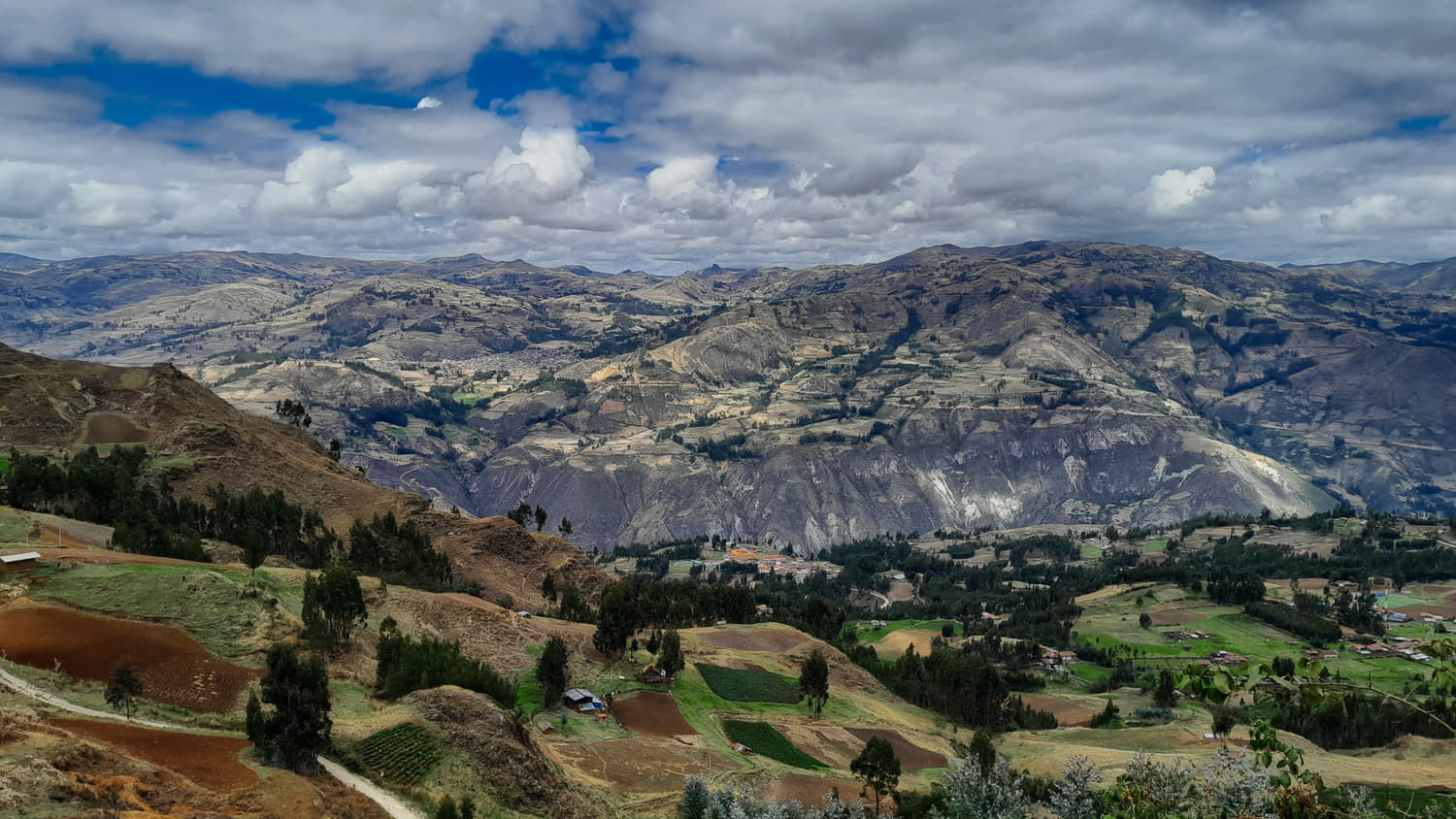
Scattered farm fields in high mountains (around 4000m).
Next two days, I took some quite remote, yet spectacular, roads through remote areas of Peruvian Andes towards Cordillera Blanca. The roads were mostly unpaved, with countless tight curves and switchbacks, going up and down steep mountain slopes. Even though temperatures at the bottom of deep canyons were pretty high, most villages were high up in the mountains (above 3000m) and cold. Surprisingly, I was able to find decent accommodation even in the most remote of the villages and they all had hot water.

Switchbacks between Moyebamba and Pallasca.
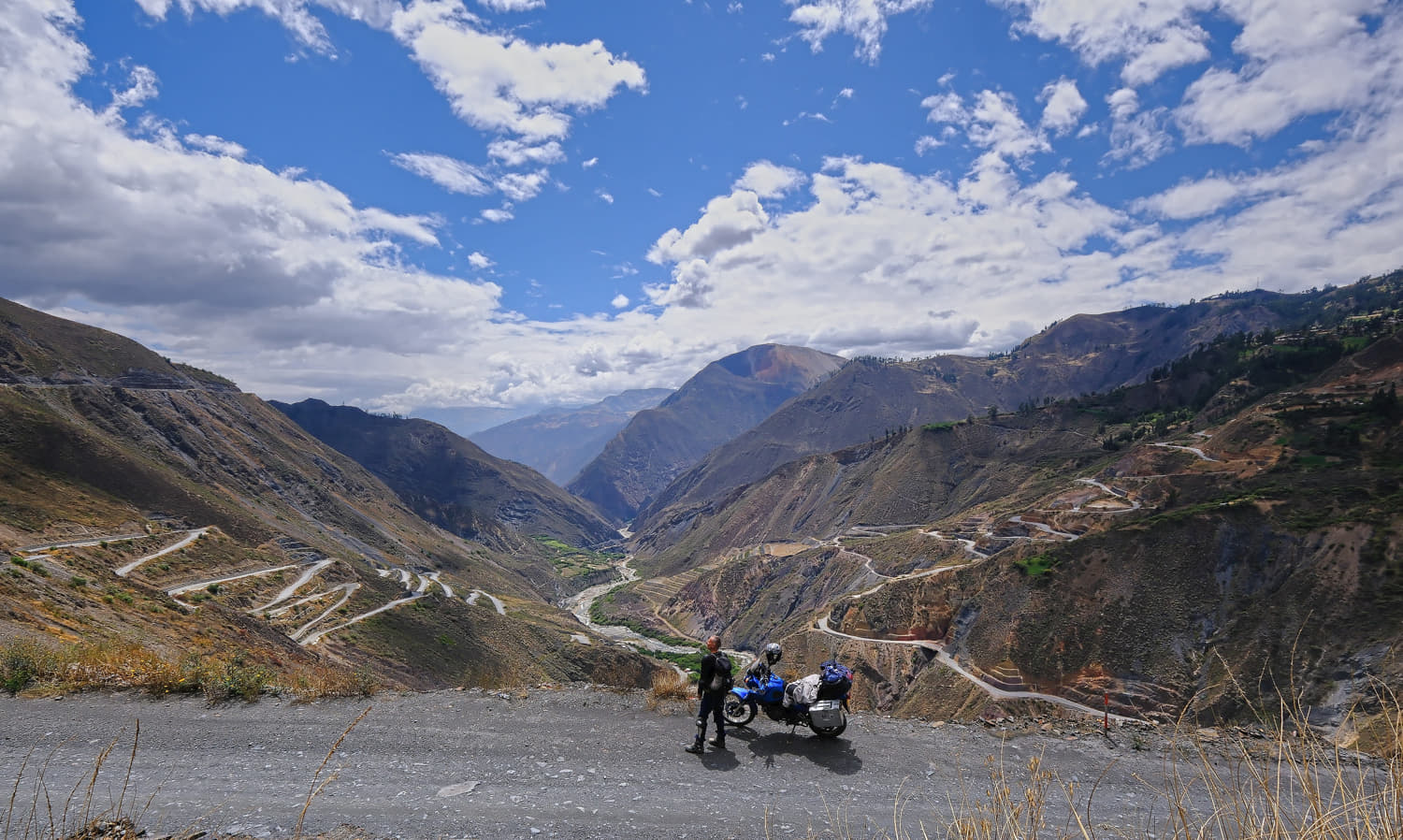
Another view of the amazing switchbacks down and up a canyon near Pallasca.

Screencaptures of some of the insane switchbacks I rode in Peru.
Going is very slow in these areas. Not only because of the road surface but mostly because of the tight, blind curves on one-lane roads. There is very little traffic, but higher speed would make a head-on collision very likely. Normally, I could cover only 200-250km in 10-12 hours of riding.

Roads are single-lane with countless blind corners and steep drop-offs.

After a cold night in Pallasca, I rode down into a deep canyon only to climb back out again.

Colorful hills near Ancos.
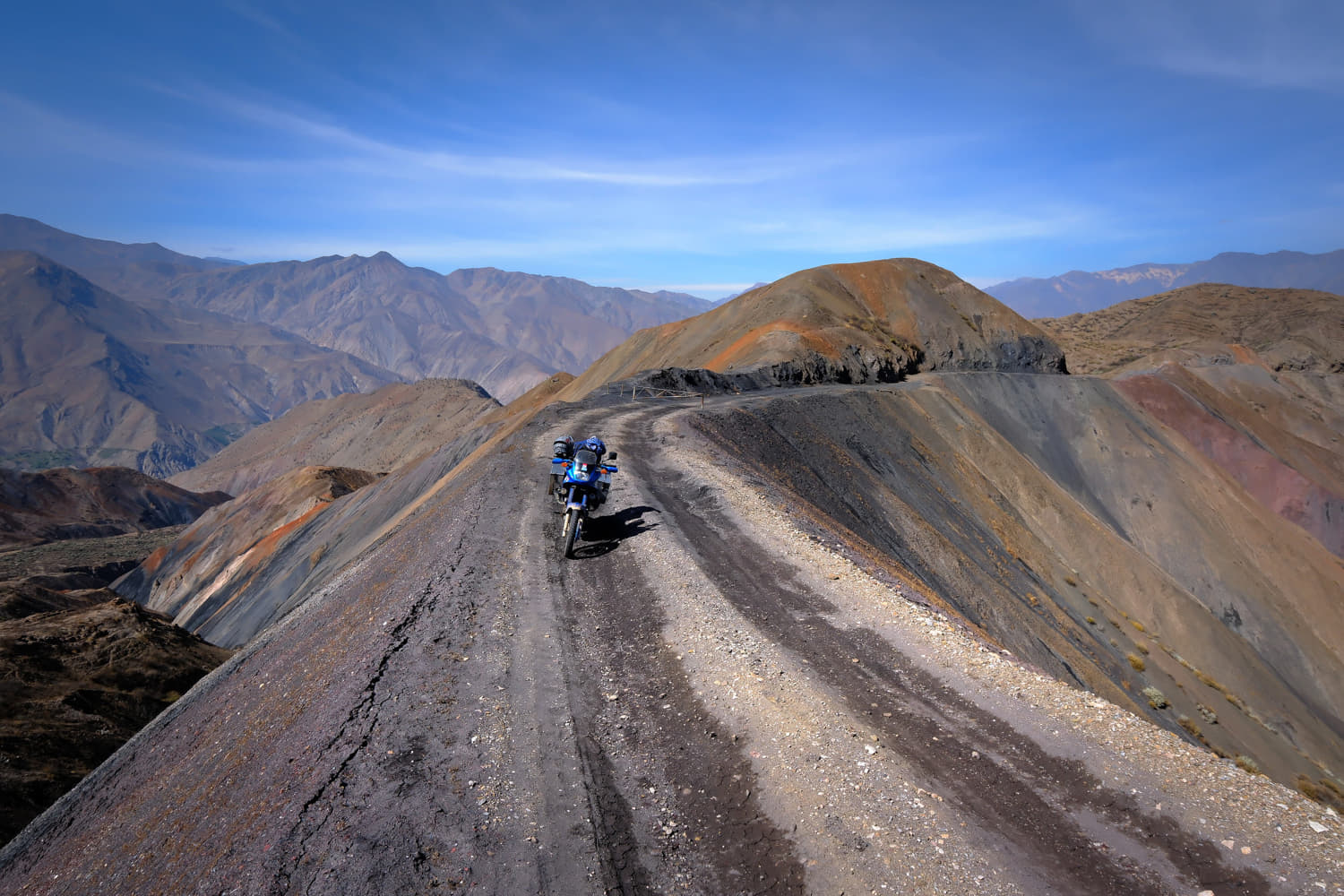
Ridgetop road.
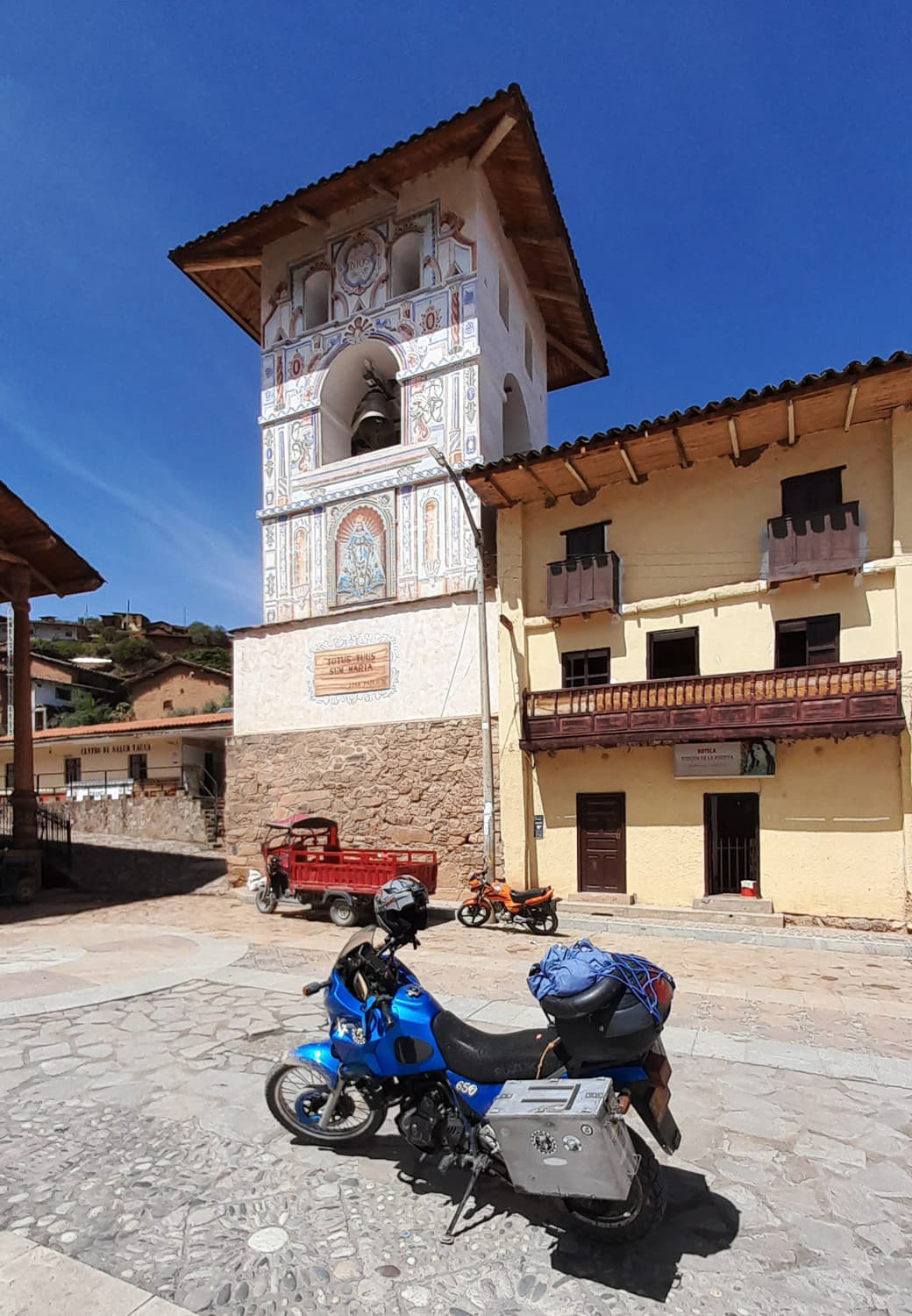
Despite being in the middle of nowhere, Tauca has a nice Plaza de Armas.
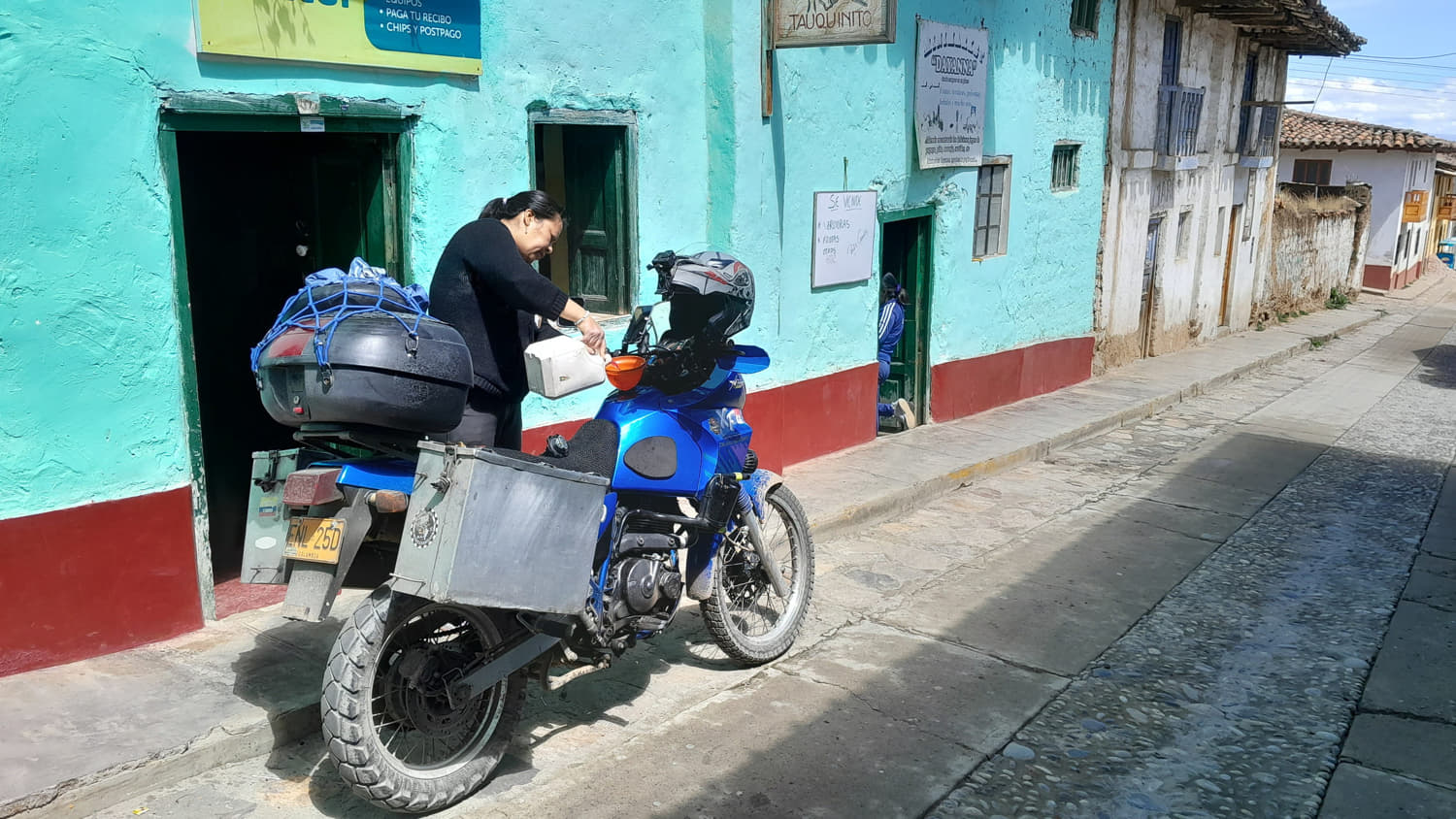
Filling gas from a bucket - an unavoidable part of travel through remote Peru.
The road from Yupan to La Pampa was particularly slow despite being paved. The views from the road were nothing short of spectacular though.
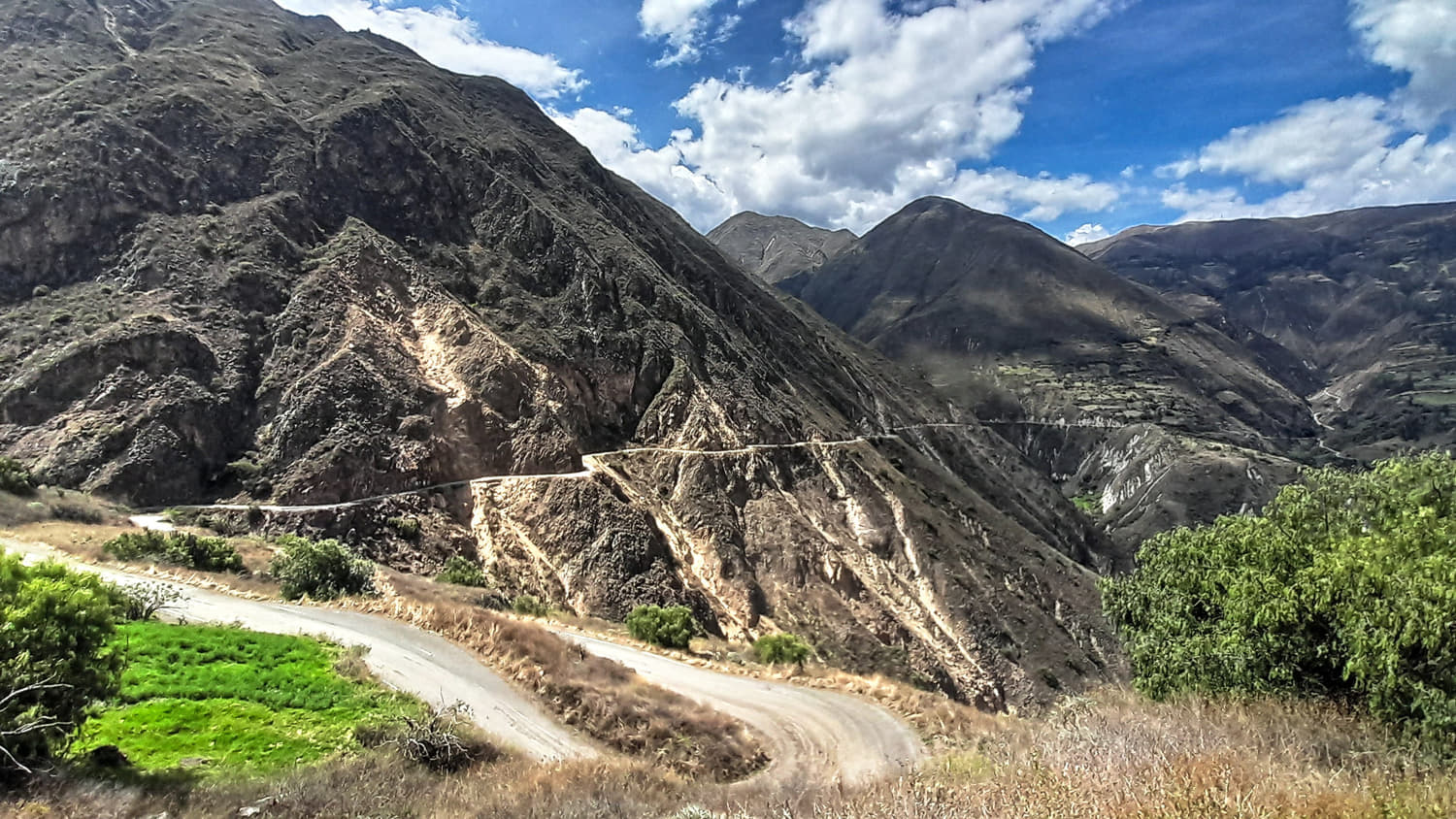
These roads barely see a few vehicles per day. As far as dirt roads go, they are in excellent condition.

The first glimpse of the Cordillera Blanca from the pass above La Pampa. It took me 3-4 hours to get to the road on the other side of the canyon.

"Paved" road descending towards the main Chimbote-Caraz highway. I can see why Andean governments have such a hard time maintaining roads - mountains slopes are steep and very loose.
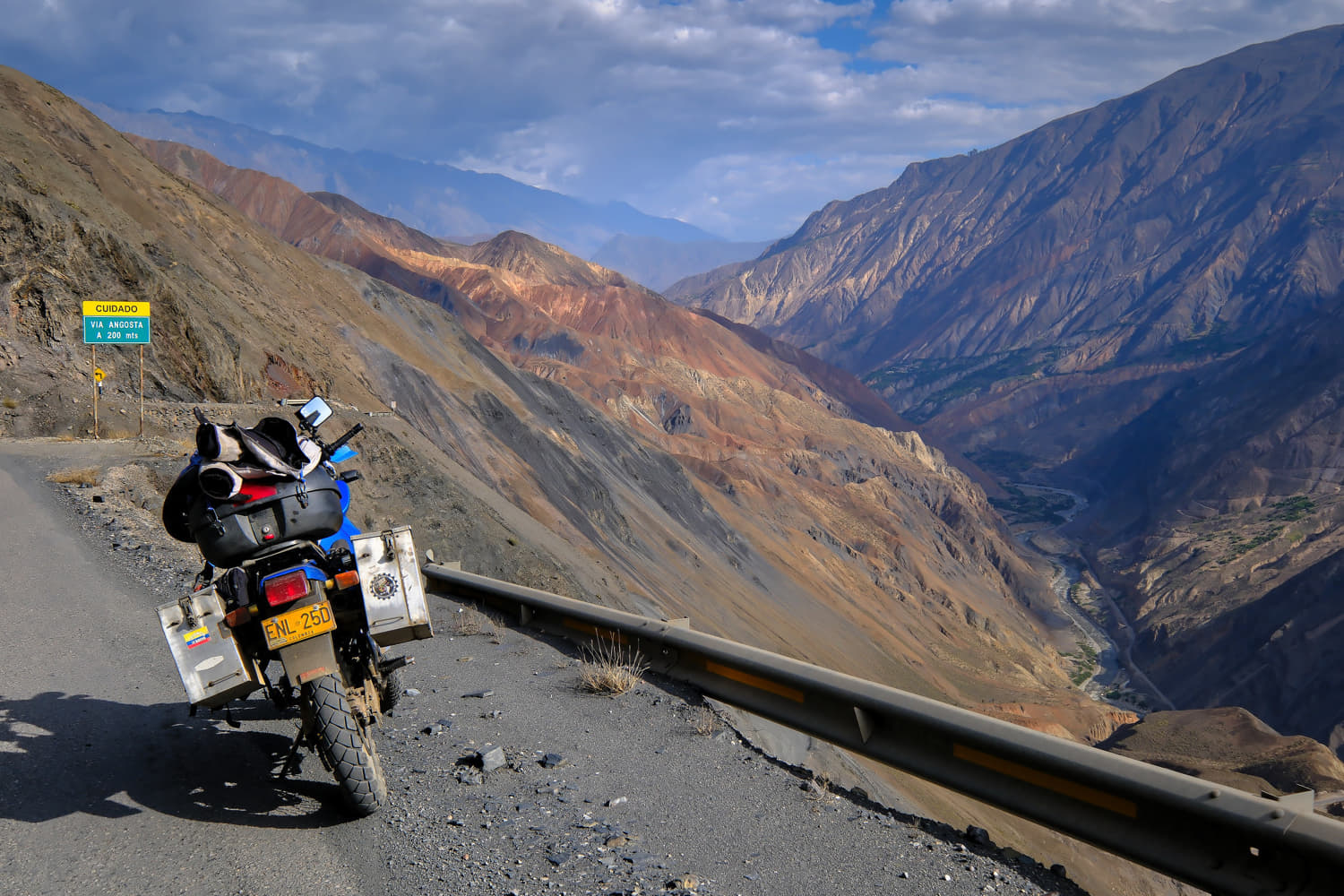
Storm brewing over Canyon del Pato in the distance.
Eventually I reached the paved road through Canyon del Pato. Just as I thought I was home free, bike started acting up. The main fuse was blown and I couldn't start the bike. I replaced the fuse and it blew immediately. That meant I had an intermittent short somewhere. It was getting dark and I couldn't see wires well. I fumbled with wires, put in the last spare fuse in and when the bike fired up, I rode it straight to a hotel in Caraz without stopping. The fuse was blown again by the time I reached hotel, but I I didn't care as I had a place to sleep already.

One of numerous tunnels through Canyon del Pato. This is where my main fuse kept on blowing.

There are several waterfalls in Canyon del Pato, but this one is probably the most beautiful.
Next day I slept it, I needed a good rest from the 14 hours of riding and all the stress regarding blown fuses. I read about possible causes of shorts on this type of bikes and the consensus was that it's either wires behind the steering head or at the back, going to stop light. After I took off the plastic around the headlight, in bright daylight, I could easily see the offending wire with chewed up insulation. I wrapped it up with electrical tape and bike never had shorts again. I spent the rest of the day doing chores, exploring local market and just relaxing.

Hunting for the intermittent short.

In daylight, it was easy to spot the damaged wire.

Caraz plaza de Armas.
With bike fully functional again, I rode up to Laguna Paron. Things have changed quite a bit since I visited this place last time, 14 years ago. Locals have installed a toll gate and they close it when nobody is there to collect the entrance fee. They are supposed to open it at 8am, which was more than an hour from the time I arrived at the gate. I doubt they are punctual and it was very likely nobody would show up till 9 or 10 am. Since the weather was crappy and the other side of the valley looked better, that's where I rode.

I headed to the "other" where the sun was shining.
I remember vicious dogs chasing me on my bike when I rode to Laguna Paron last time. There were plenty of them this time too. One dog ran in front of me and ended up under the wheels of my bike. I barely managed to keep the bike upright, but the dog scored worse. He was squealing in pain while I rode off. I doubt that that dog will chase bikes again.
Over the course of next few days, there were quite a few dogs chasing me. Most of them kept their distance, but on two occasions, they got close enough to my footpeg to get the motorcycle boot in their faces. I giggled listening to them squealing behind me. These dogs are a real menace. I read many reports of riders being bitten by stray dogs and getting rabies shots.
I saw a road with a number of switchbacks on the map going up Huaylas from Canyon del Pato. I wanted to ride it. It was little more than a dirt track, barely used. There certainly weren't any vehicle while I was there and I doubt it sees even one vehicle per day. No wonder locals were giving me looks when they saw me leaving Huaylas in the direction of this road. I had my lunch half way down the switchback with beautiful views of the canyon and surrounding mountains.

Barely used dirt track descending from Huaylas down to Haullanca and Canyon del Pato.

This was a great spot to enjoy some wine and cheese.

The main road going to Sihuas.
Next day I rode north, back along the road I came on and crossed Cordillera Blanca on a road going east to Sihuas. I rode a dirt road on the east foothills till Pomabamba. There I stayed at very comfy and quiet hotsprings. The owner showed me a sticker from one group of Ecuadoran riders, but otherwise, this place was blissfully free of tourists unlike the west side of the Cordilleras.

The top of the pass across the Cordilleras.
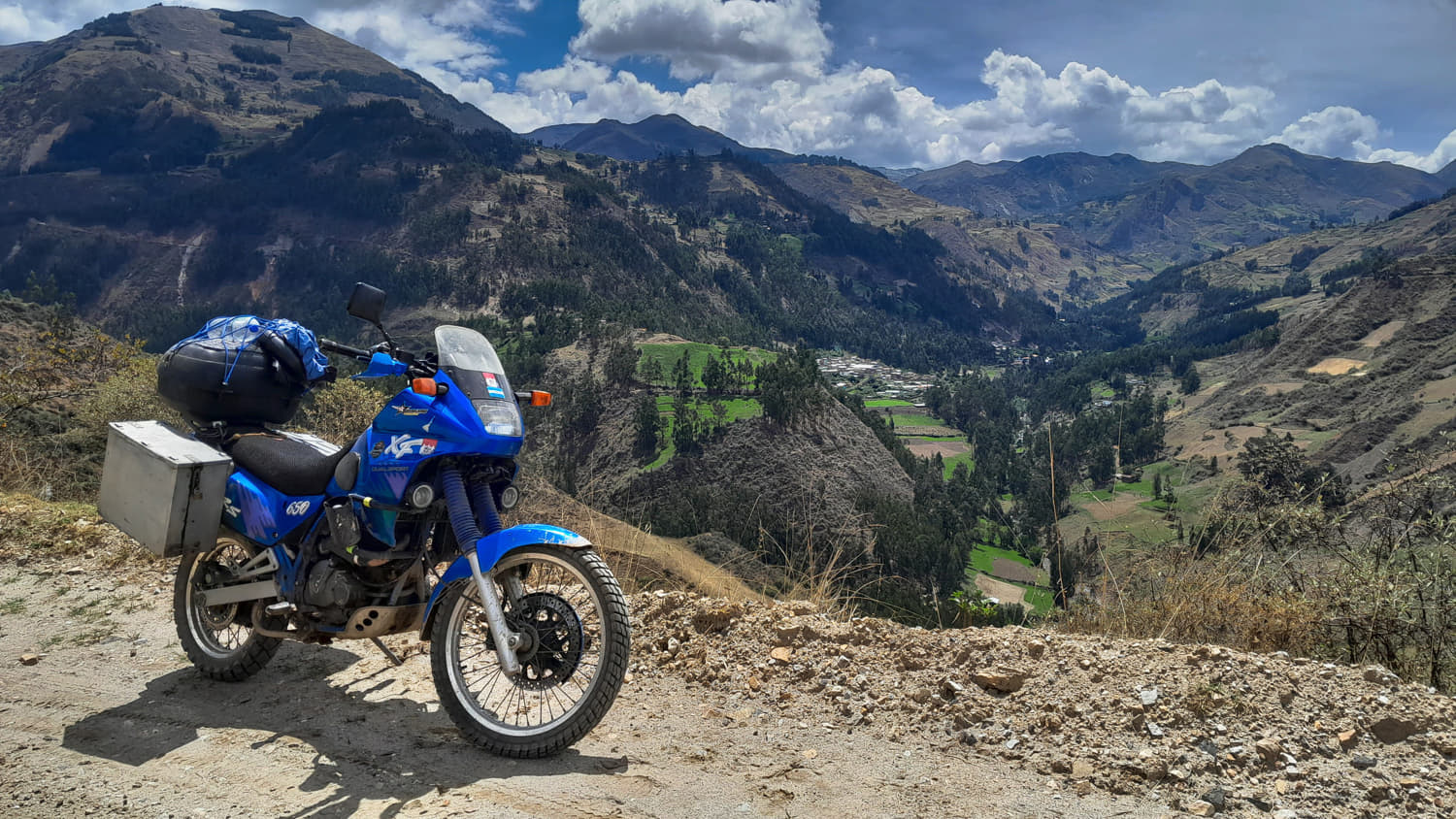
Quaint villages on the east, untouched by tourism, side of the Cordillera Blanca.
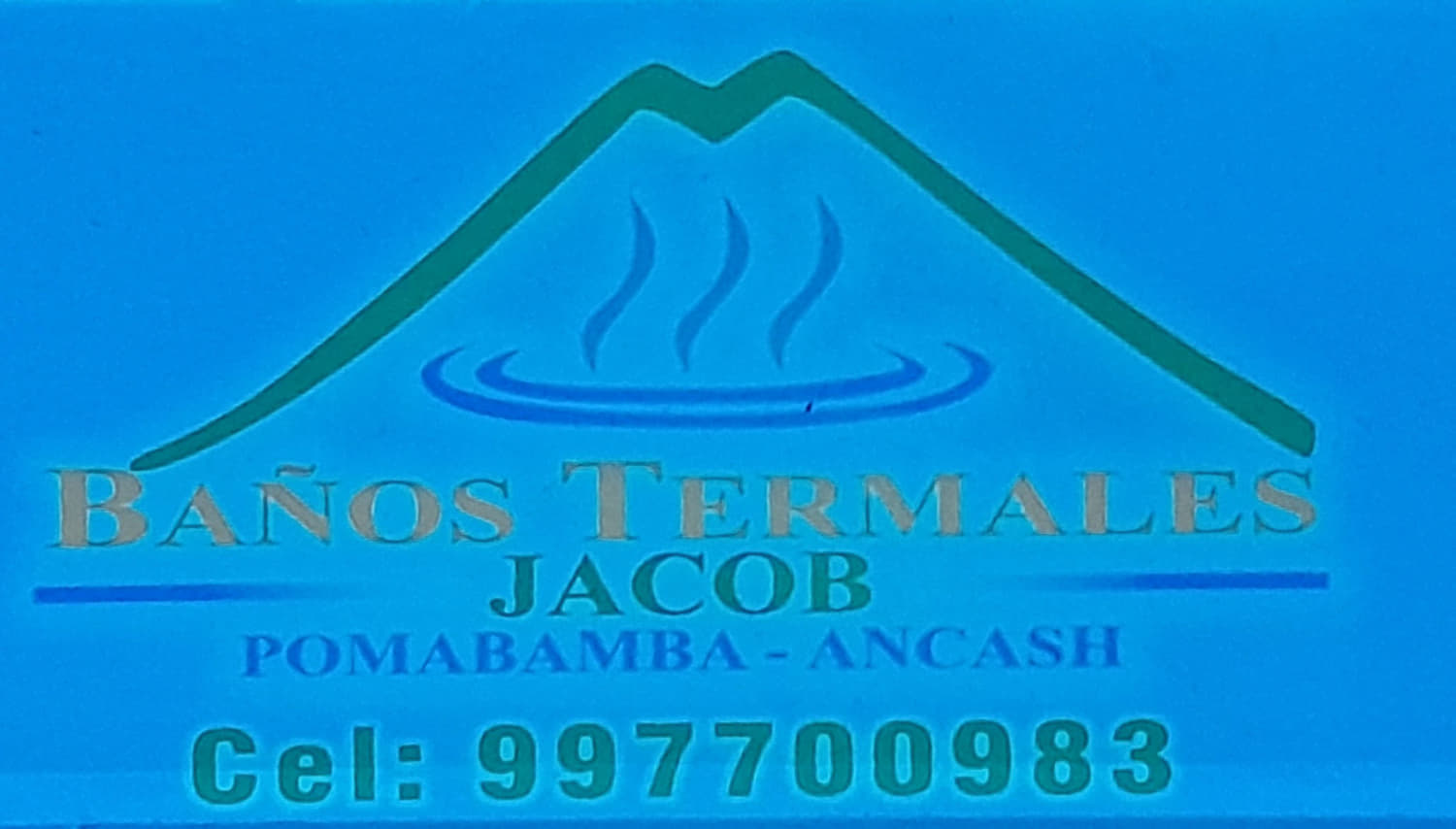
Hot springs in Pomabamba - a very pleasant place to spend a night.
I used to laugh at the story about the semi-truck driver who followed his GPS down Shaffer Trail in Canyonlands NP. But I made a similar mistake following my GPS down a narrow street. Eventually small street turned into a pedestrian path and I didn't stop to re-consider proceeding even after going down several steps. Turning the bike around was a nightmare because walls were exactly bike's length apart. Thanks God I didn't ride some 1000+ CC bike.

After going down three steps, I realized that I would not be able to continue. Turning the bike around was challenging. Passing policeman suggested me to simply ride bike down the path. Later on, I saw that the steps became steeper and path narrower, eventually having a tight 90 degree corner. Had I listened to his advice, I'd have to lift bike over the fence.

I had to roll bile back near the steps in order to turn it around. Even then, I had to lift the front wheel in order to clear little wall. Riding bike up the steps was the easy part, especially with the rocks.
I continued my ride south and crossed cordilleras on road nr 106 that passes by Lago Llanganuco. The weather wasn't good, cloud base was barely above the snowline. But at least it didn't rain on me. This place changed too, since I was here last time. Now they installed a gate and charge foreigners $8 to pass through. It's really just a road going through a national park, but they want money.

Starting climb on road 106 from the east side..

Start of Sant Cruz trek. The weather looked bad in the mountains, but hikers were still going in.
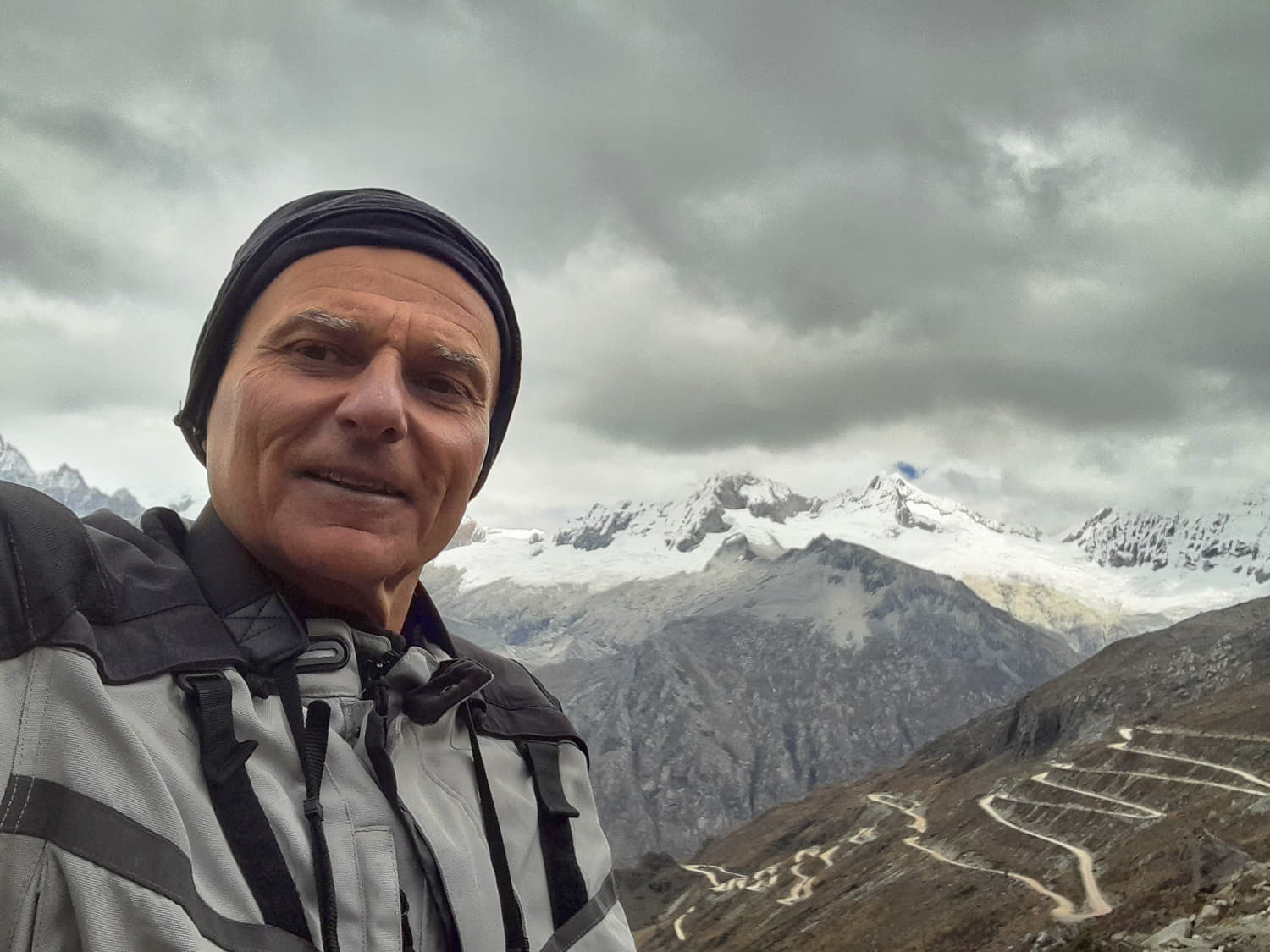
Atop the pass, high above Lago Llanganuco.
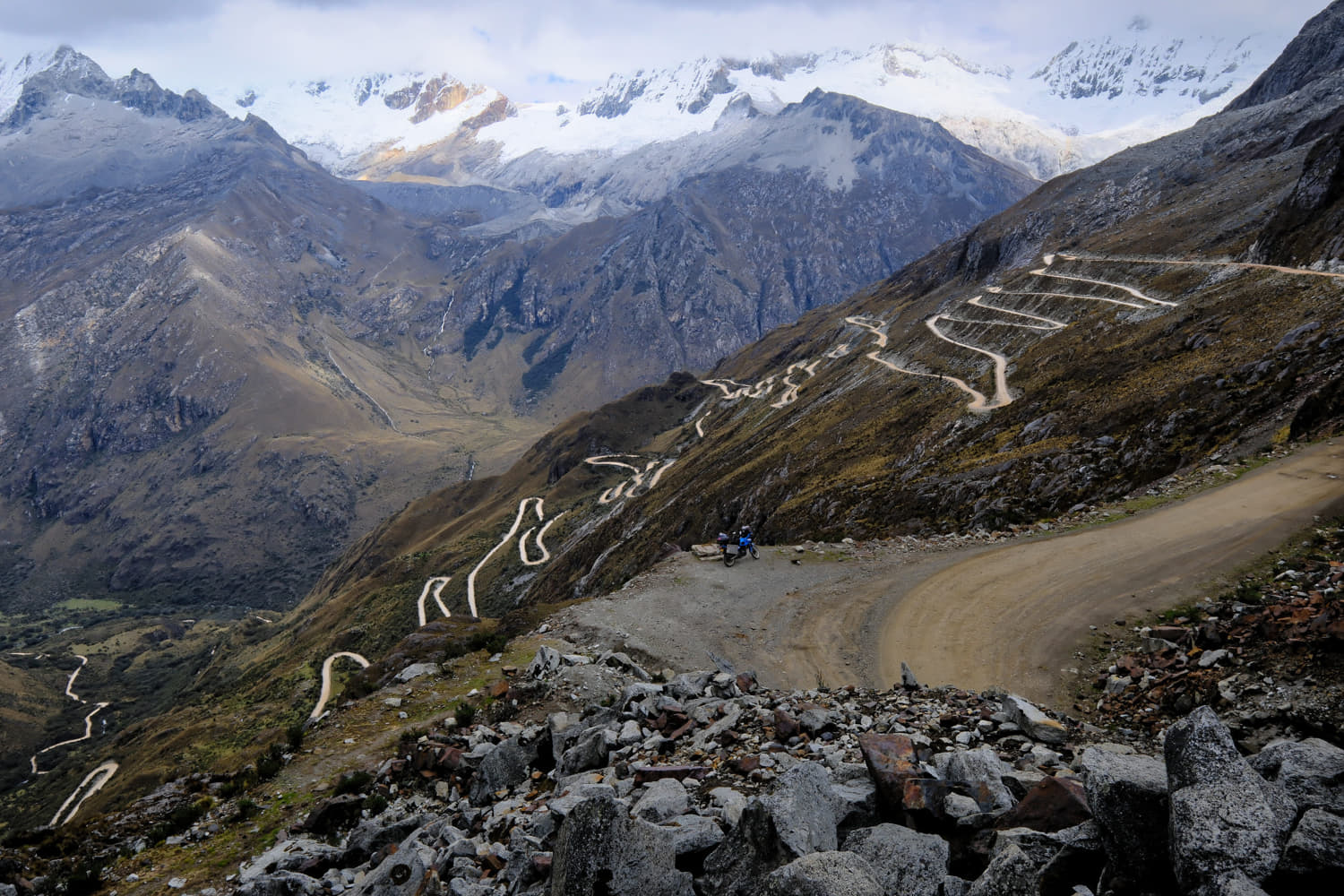
Switchbacks descending down to Lago Llanganuco.
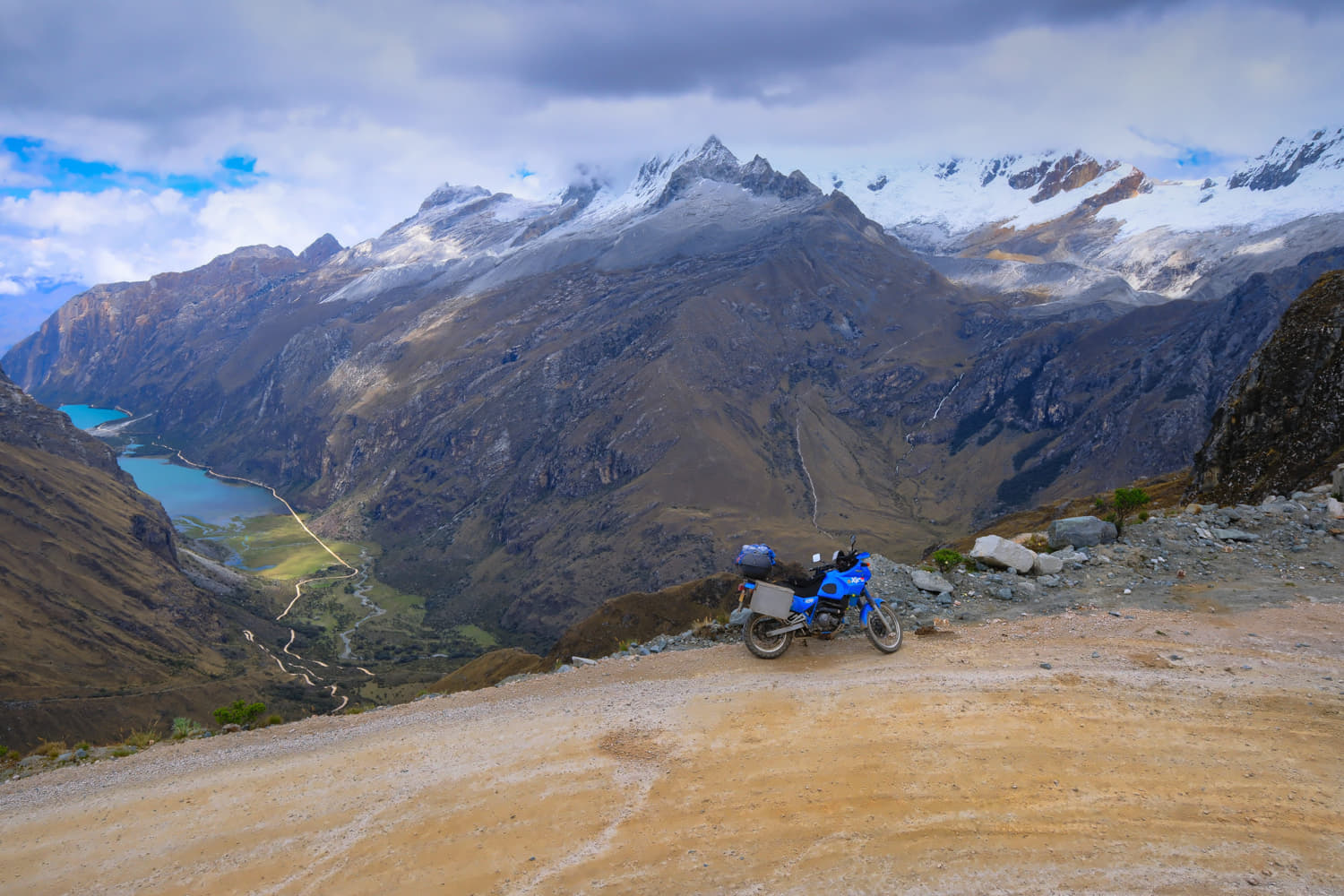
Lago Llanganuco.
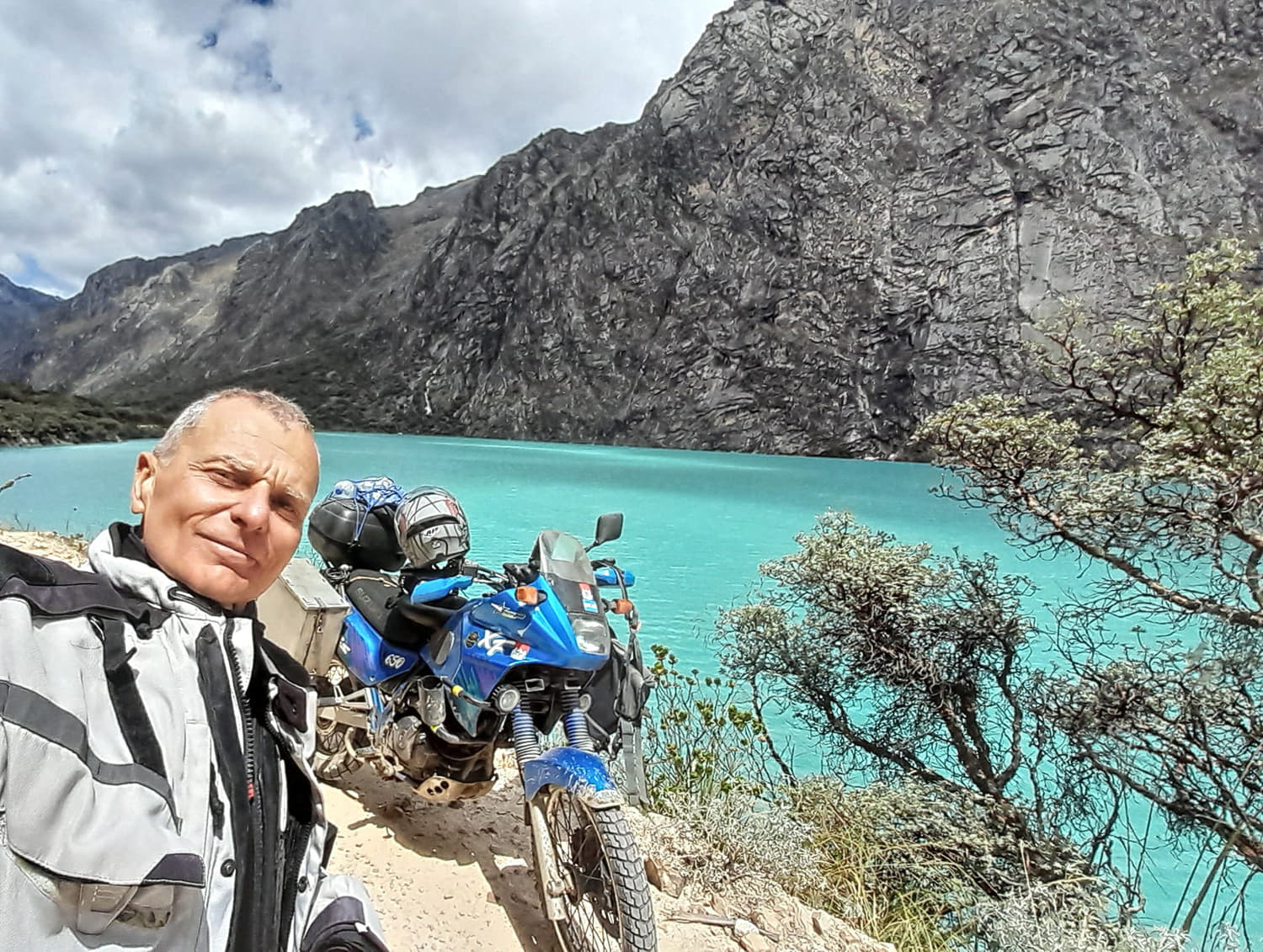
Lago Llanganuco.
Eventually, I got to Yungay and wanted to stay there, but couldn't find a decent hotel. So, I pressed on to Carhuaz, 20 min further south. Even though there wasn't much going on in Carhuaz, the hotel was new, clean and quiet, so I was happy.
Carhuaz was a good starting point to cross Punta Olimpica pass at over 4800m. It is just south of Huascaran, the highest peak in Peru at over 6700m. I got a glimpse of it through the clouds, but the weather was pretty bad overall. There were some pretty lakes on the other side, but again, in cloudy weather, nothing is particularly pretty.
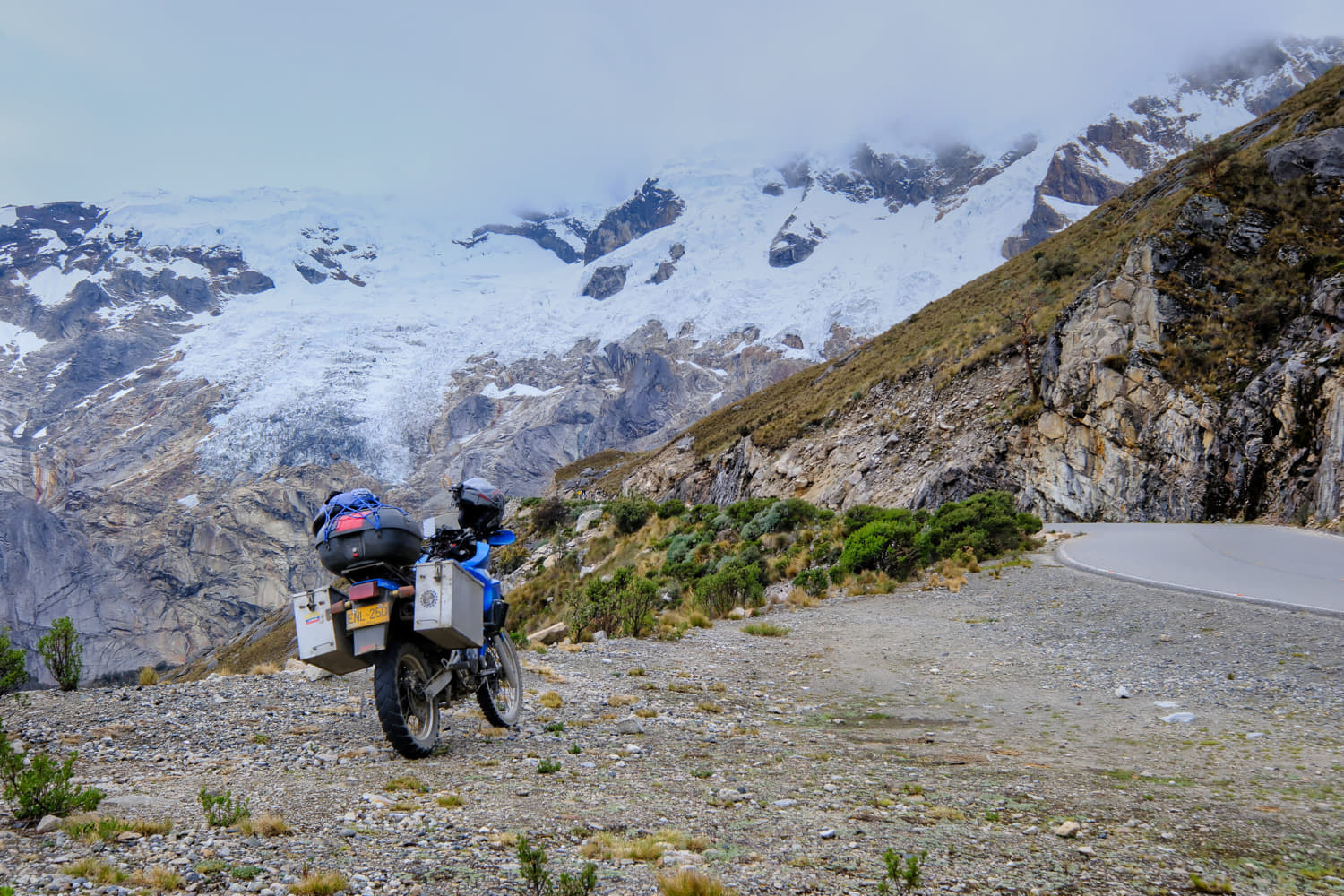
Just before the tunnel Punta Olimpica, road reaches lower level of the glaciers at around 4800m.

On the east side of Punta Olimpica, there is a picturesque lake just below a glacier.

I spent most of the day running away from the rain.

Eventually I started dropping to lower elevations and the weather got better.
After a few more hours of riding over another high pass and just before it started drizzling, I got to Chavin de Huantar and got a hotel room. I was just happy not to be wet.
Next morning, more rain delayed my departure just enough to enable me to visit the archeological site. I'm sure it was an important site in its heydays, but open roads tickled my fancy a lot more. So, after rushing through the site, I jumped on the bike and rode in the direction of dark clouds. It drizzled a bit on the way to the pass, but not too much. The other side was drier and brighter. As I approached Huaraz, the weather got better and better.
One can tell by numerous restaurants, coffee shops and tour agencies that Huaraz is a major tourist hub. I had a nice meal, got my camping gear and returned to the hotel just as the evening rain started.

These 3-wheeled taxis are the biggest danger in Peru. They unexpectedly swerve left and right to pick up passengers, make turns or just avoid potholes. This one goes around blaring commercials from its speakers.
I had several lakes around Huaraz marked on my map, but morning drizzle made me change my mind and I headed south towards brighter skies and Pastoruri glacier. Unfortunately, the weather there wasn't much better. No rain, but clouds obscured the glacier. So I just continued on the dirt road towards the paved highway. I spent pretty much the rest of the day dodging the rain and eventually made it to a small town with some decent hotels.
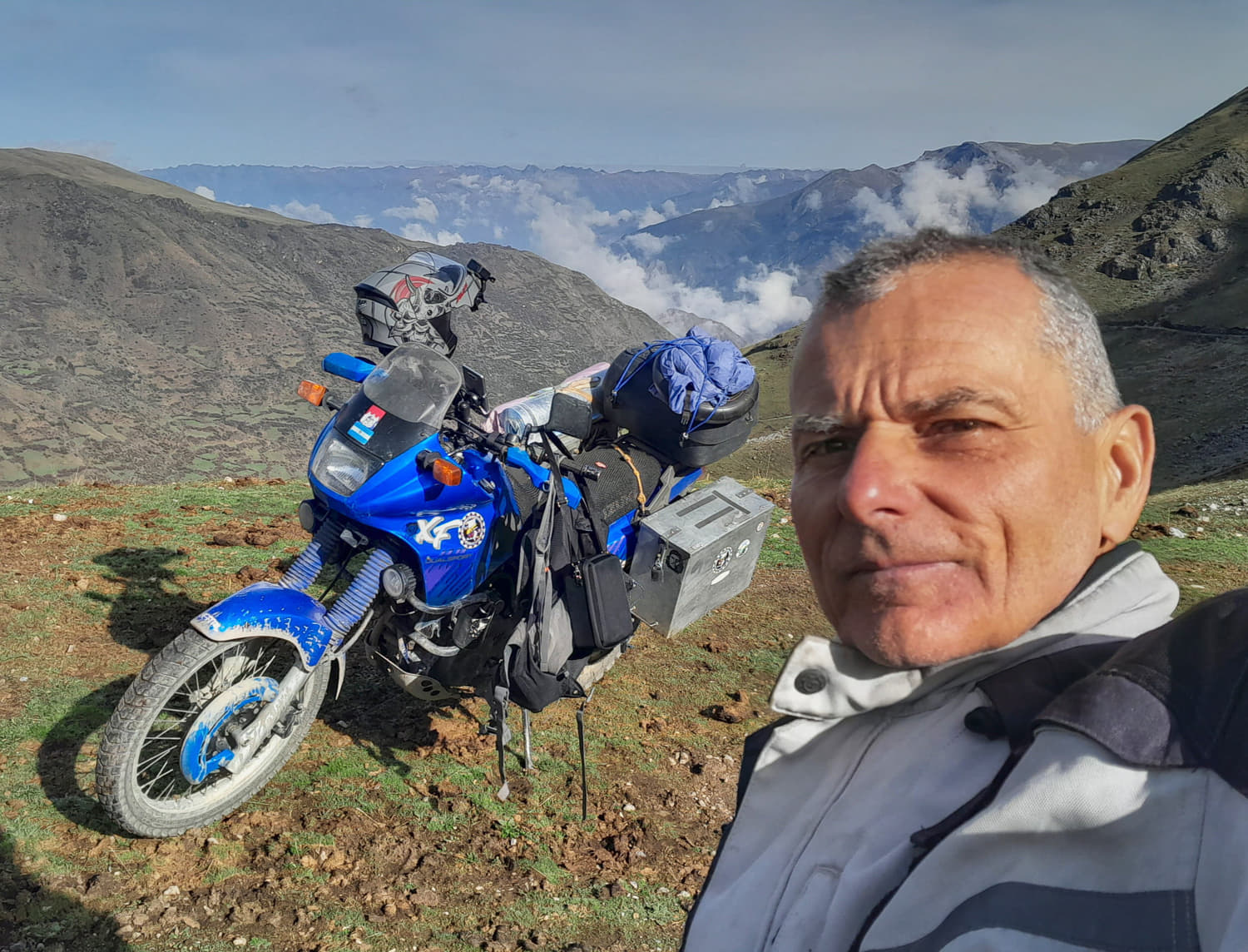
I had semi-decent weather on my last day in the mountains before heading to Lima.
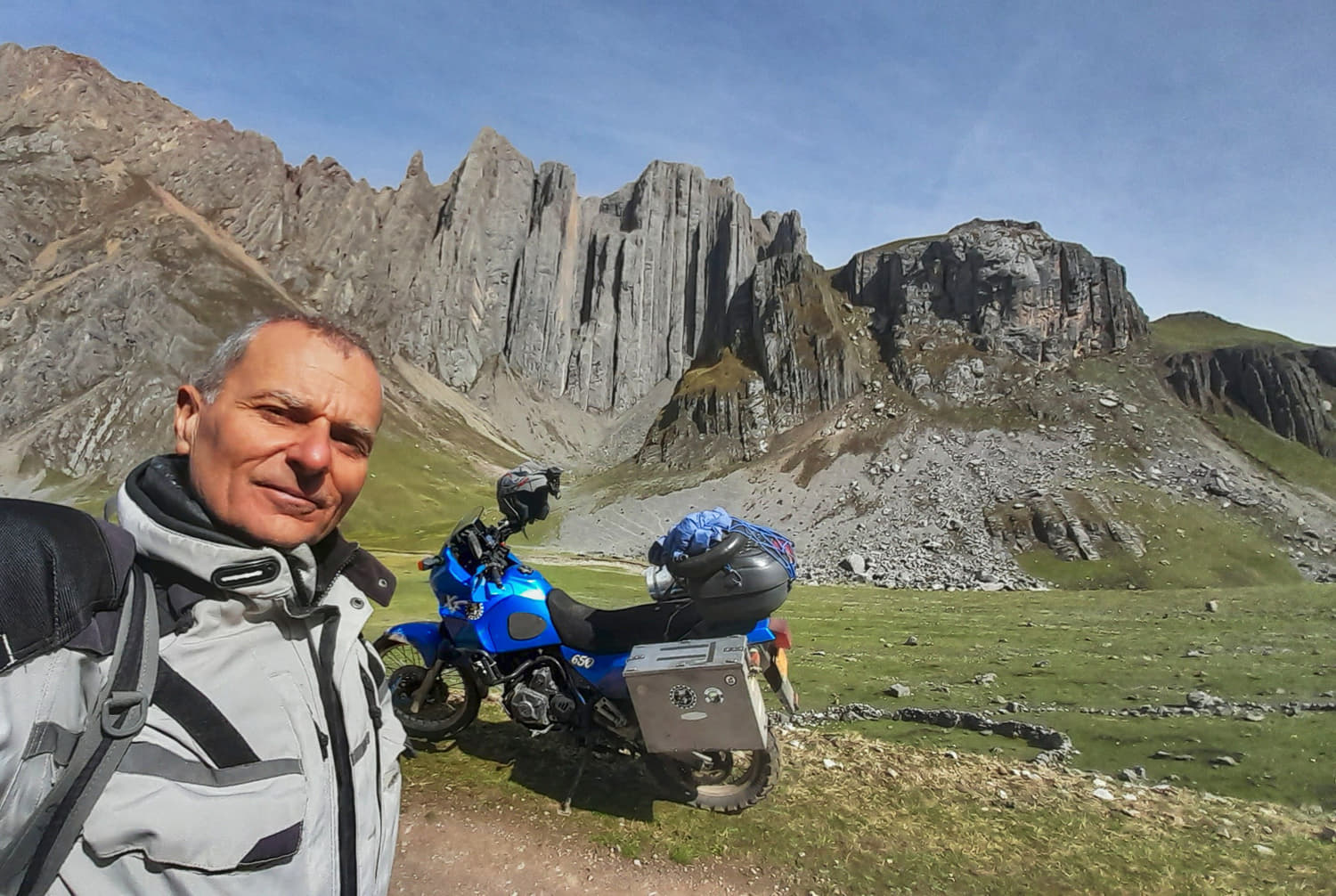
Rock face after crossing another 4800+m pass. I had hoped to ride some "virgin" roads, but at the pass I saw several stickers from other riders and even one from a bicycle rider, insane!
I really wanted to avoid the coast, Panamericana and, especially, Lima. However, I was very close to Lima and I was in need of spare parts for the bike. I was also getting mentally worn out by high altitude Peruvian villages. So, when I got to Lima, I was born again. Well-supplied supermarkets, coffee shops, restaurants, clean sidewalks... I was in heaven. It was only then that I realized that I had been out of civilization for over a month. I don't quite remember what Lima was like 14 years ago, but this time around, I was quite impressed with clean sidewalks, safe and clean neighborhoods (not only Miraflores) and numerous parks.
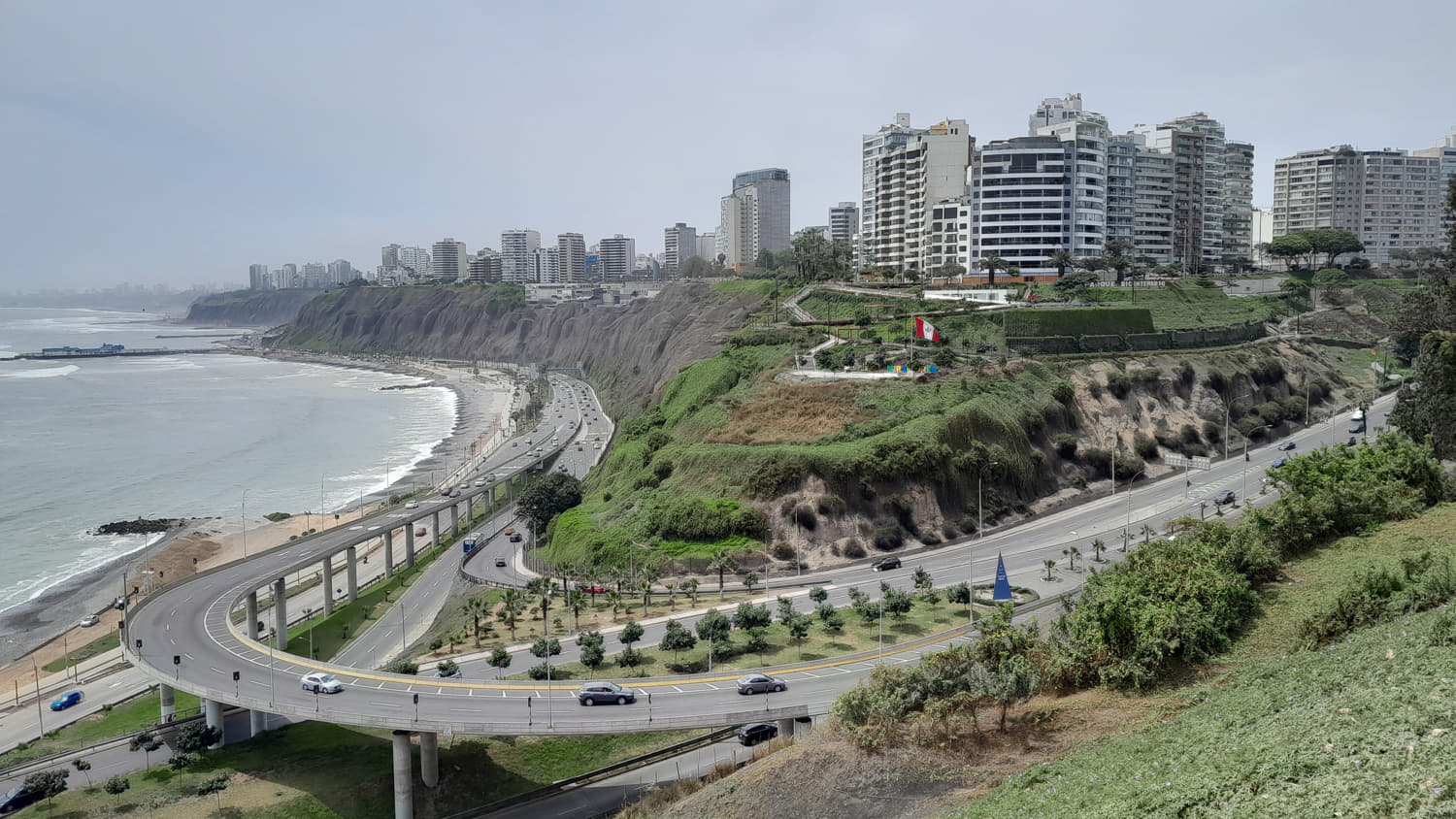
Lima's urban atmosphere, modern supermarkets, moderate climate and comfortable accommodation were exactly what I needed after three weeks of high-altitude villages.

I was happy just to be able to walk around in a shorts and t-shirt.

My search for spare parts led me to Documoto. The owner helped me get a custom-made clutch cable.

Nobody carries brake pads or clutch cable for my bike. But both can be custom-made. This is the clutch cable made just for my bike.

Lima has a flat iron building too.

Lima traffic is something else. These buses were blocking the intersection, while their passage was blocked by the bus I was on. Such grid-locks are quite common.

WTF bike.
After four days of R&R in Lima, I headed south towards Pisco and Ica. I spent one pleasant afternoon in the picture-perfect oasis of Huacachina and climbed atop one of the sand dunes for the sunset.

Atop a sand dune waiting for sunset.

Sunset time atop one of the dunes.
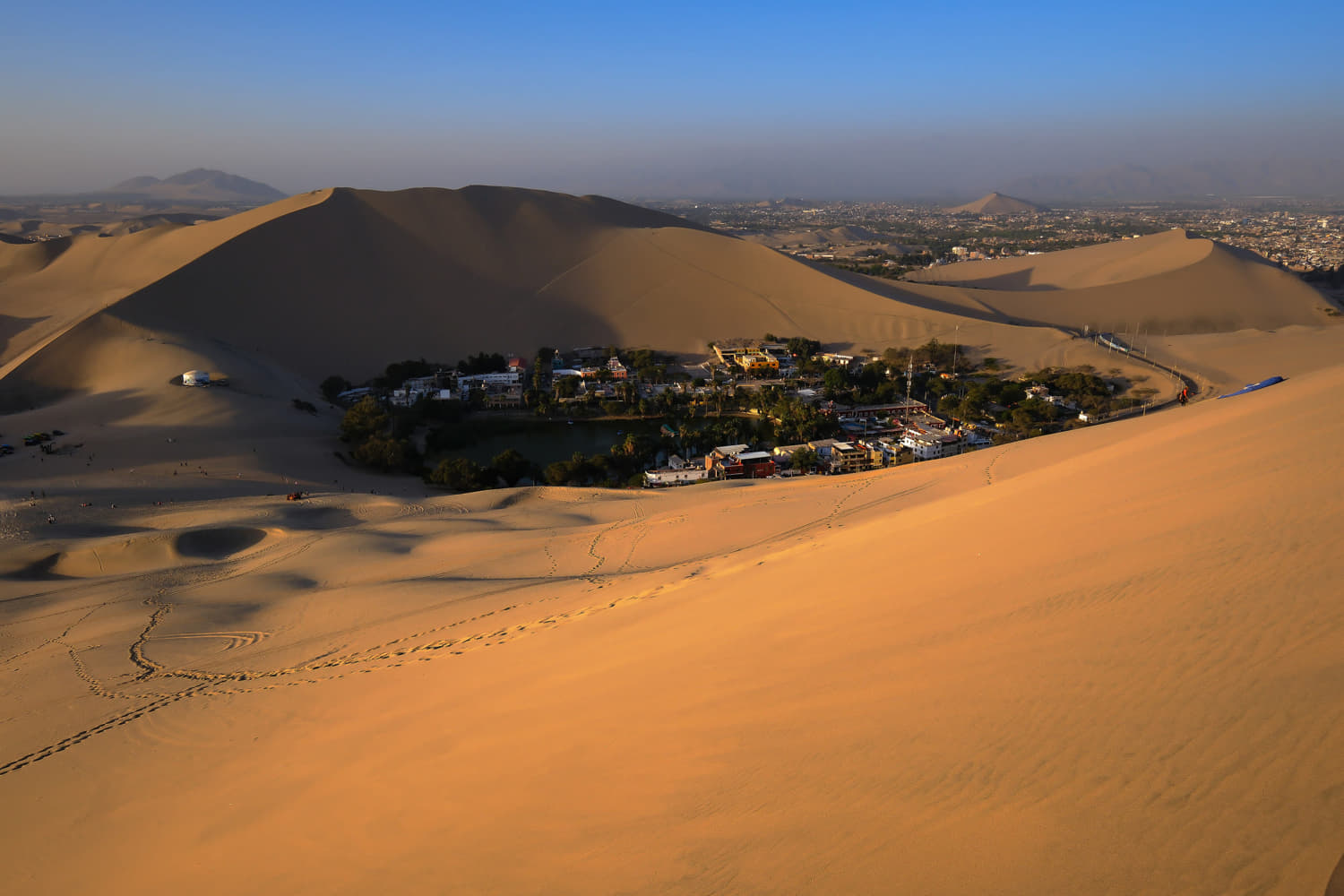
Huacachina - oasis surrounded by sand dunes.

Ripples in the sand on one of the dunes.
I was gonna take a road to the Aguas Turquesas from Ica, but my friend recommended me to ride to Ayacucho first. A small, one-lane, mostly paved road lead me over a high pass to the main Pisco-Ayacucho highway. The small road might have been one of the best roads I've ridden in Peru.
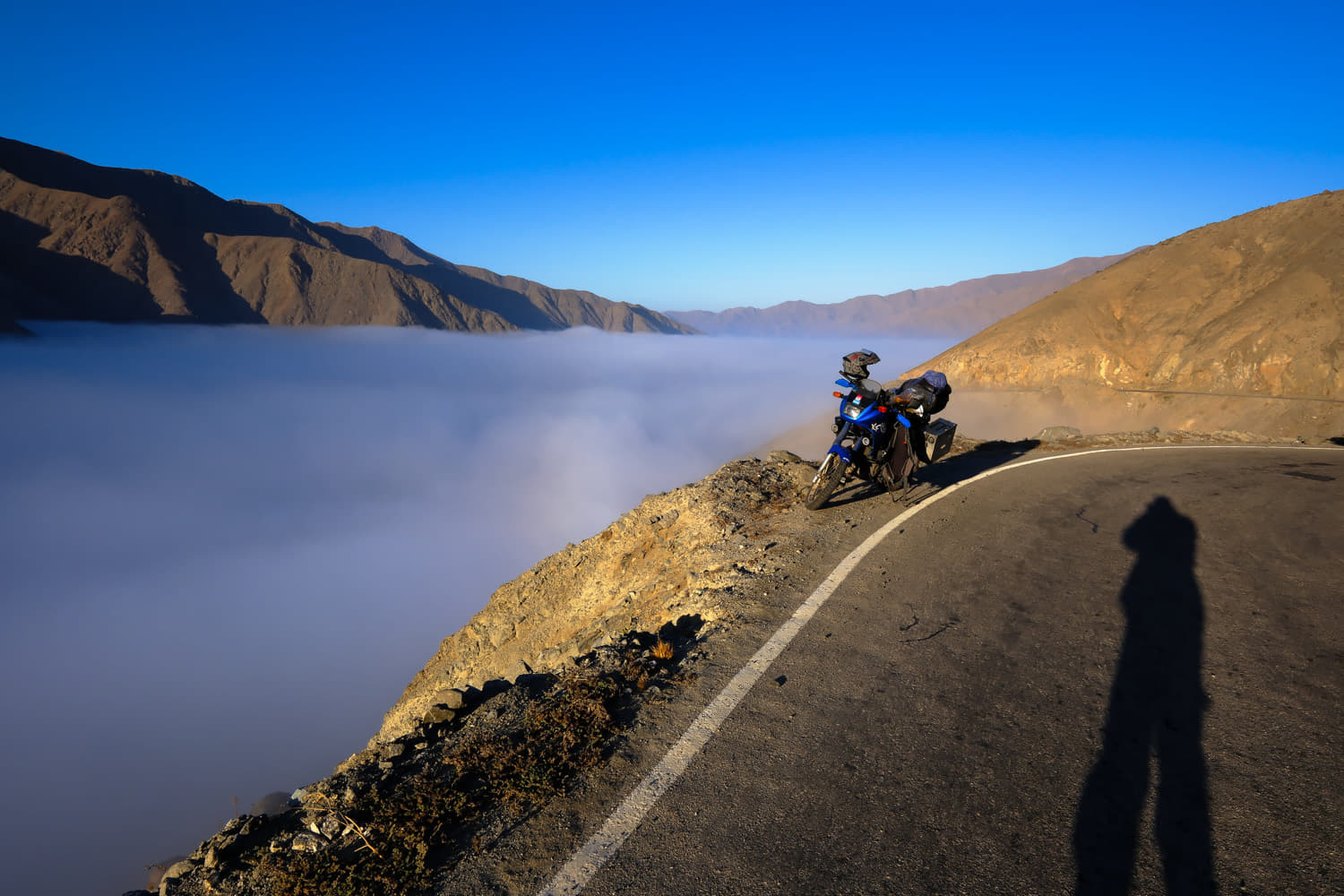
Above the sea of clouds outside Ica.

On the way to Ayacucho.
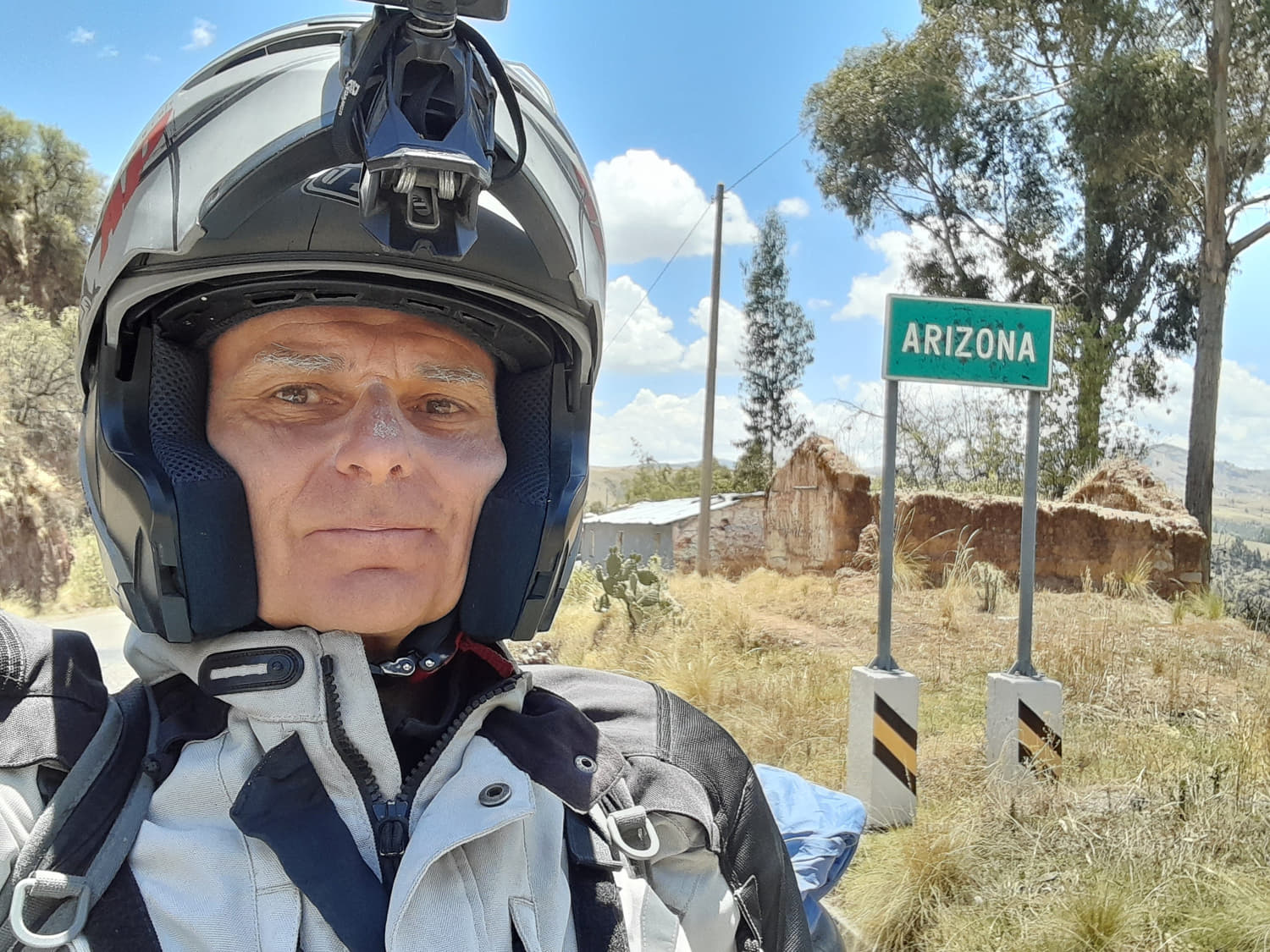
I passed through Arizona on the way to Ayacucho. Later on there was another town called California.
Ayacucho is a major mountain city of Peru and it's nested in a valley surrounded by high mountains. All the roads in or out of the city go over high passes.
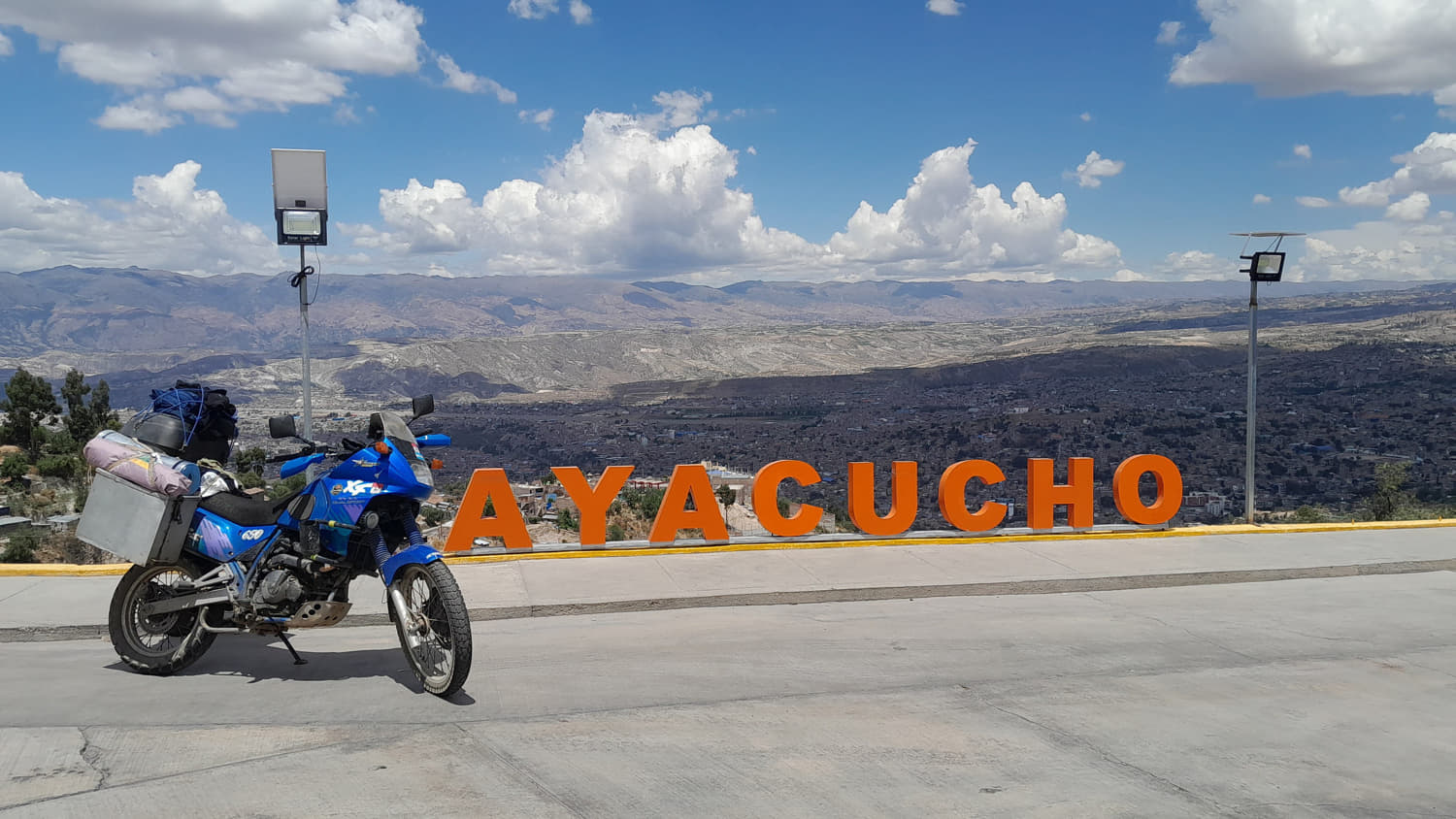
Viewpoint above Ayacucho.

Welcome drink - Ayacucho Plaza de Armas.
I still wanted to visit Aguas Turquesas and even though the weather didn't look promising, I went for it. I blindly followed my OSM GPS and it navigated me over rough road and high mountain pass just to save a few kilometers. Shame on me for not using my head to choose a better road.

Aguas Turquesas, without sun, they are just green.

Surrounding canyon is quite spectacular too.
It took me two more days of dodging rain, several hundred kilometers of dirt roads, many switchbacks and one flat tire before I reached Cusco.

First flat of the trip.
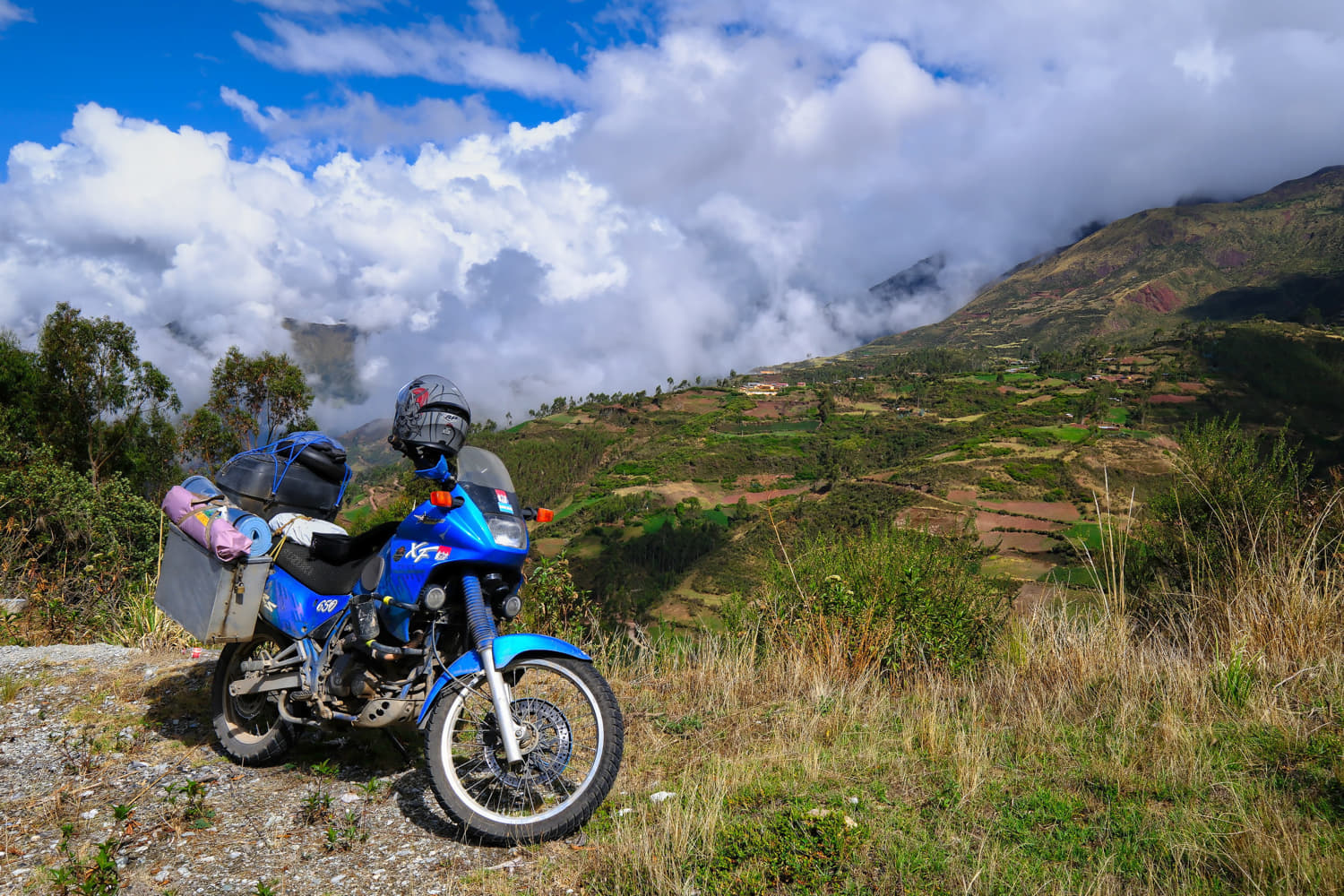
It was cloudy everywhere except above the valley that the road went through.
Cusco is a must-stop for travelers, whether going to Machu Picchu or not. It's got everything traveler needs, numerous plazas, parks, restaurants and historical sights. Unfortunately it's got all the bad elements tourists attract - touts, scammers and hasslers. I was gonna spent a few more days there just relaxing, but after 100th tout pestered me about a massage, I decided to leave ASAP.

Most street vendors are just annoying. 75 y.o. Francisco spends four days a week in Cusco selling hats and has a friendly and kind attitude. I bought his hat in exchange for a few photos.

In the evening this street is flooded with touts offering everything from massages to tours and it's impossible to take a photo. At 5 AM, it was blissfully quiet and I could actually take a few photos.
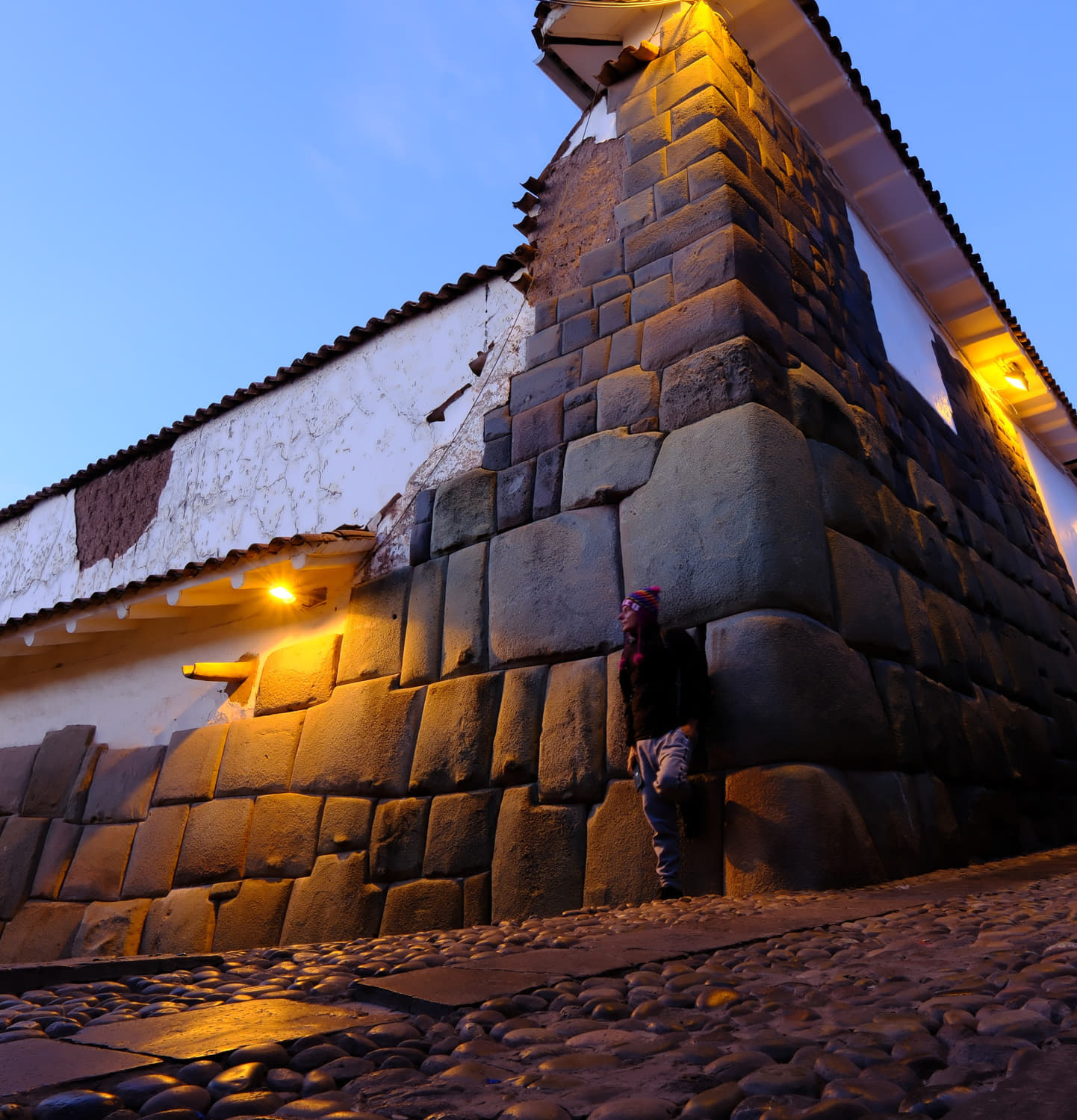
Famous Inca stone masonry.

7-corner rock is the place to take photo next to. Francisco's hat came in handy on this cold morning.
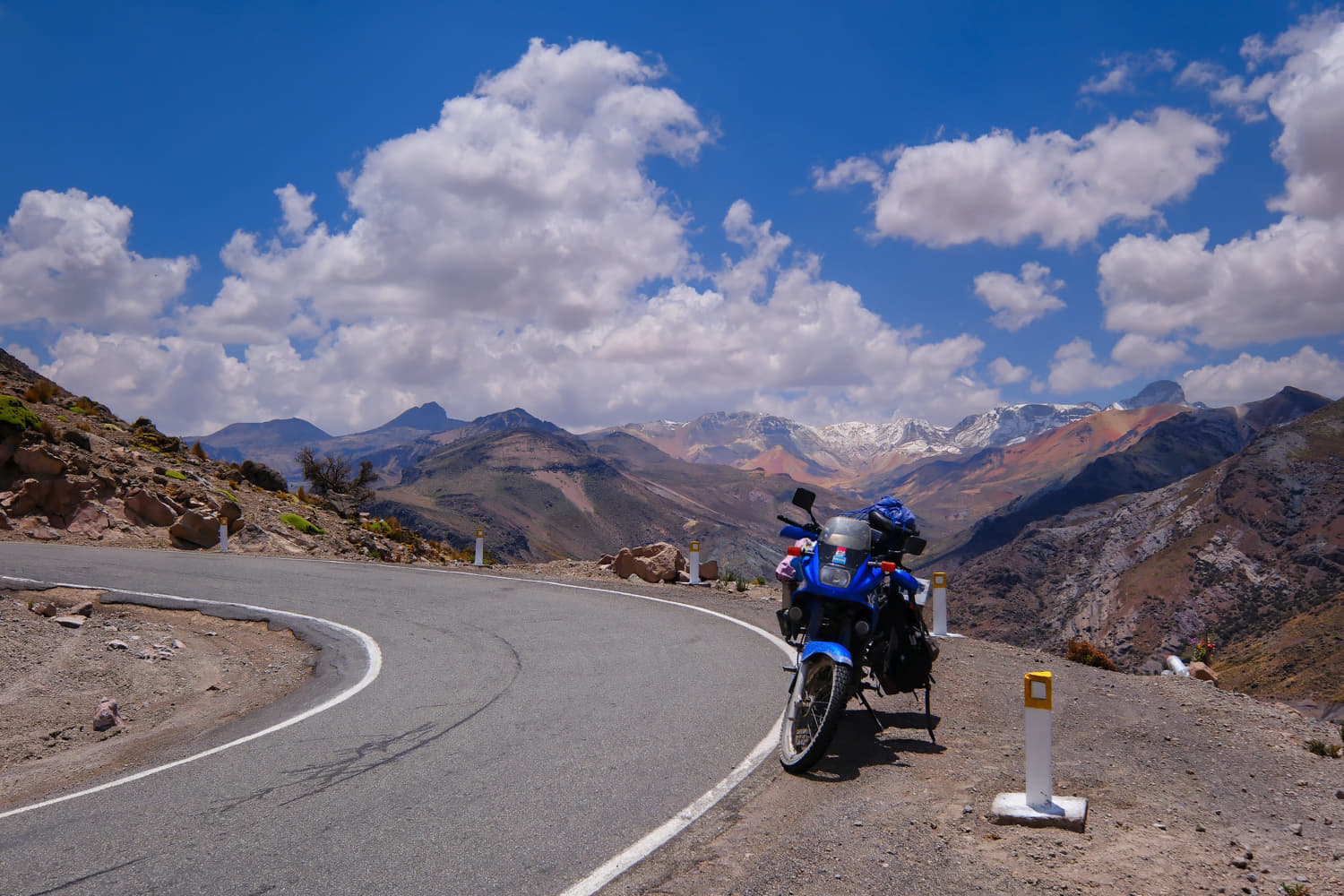
The last stretch of road in Peru - on my way to Tacna.

A storm brewing above the Andean desert.
Peru is a big and diverse country. In a month, one can only scratch the surface. This time I spent most of the time in the mountains. On my previous trip, I rode more than enough of the coastal desert. I wish the weather had been better to explore the Amazon basin more. But that will have to wait for the next visit.

At the Chilean border - 2000km to Santiago.
After a messy border crossing into Chile I spent a few hours in Arica looking for an ATM with least ridiculous fees. Then I rode a lonesome road through northern Atacama to Iquique - 300km without gas station.

Atacama desert Art.

Geoglyphs on a hill through N Atacama desert.

On the descent into Iquique, from high desert down towards Pacific ocean. A massive sand dune in the middle of the city makes Iquique a rather unique city.
I had ridden from San Pedro de Atacama through Calama down to Santiago on my first ride through Latin America. The memories of my broken chain in Atacama desert are still vivid in my mind. This time I wanted to take the desolate coastal road from Iquique south. I left Iquique quite early in the morning and I was hoping to get to Calama by noon.
The bike was making strange noises every time I ran starter motor since I left Colombia. By Chile, I got used to it and I it seemed normal. However, after a stop at a customs check point about 150 km south of Iquique, I could not get starter to turn. Luckily, every vehicle had to stop at this point and there were many truckers. One guy offered help jump starting the bike. Unfortunately, it wasn't the battery issue. The driver suspected brushes on the starter motor were worn out. The driver and his buddy tried to push my bike and bump start it, but there just wasn't enough momentum.
I tried removing the starter, but timing chain tensioner was in the way. I wasn't in the mood to remove chain tensioner in the middle of nowhere. So, I asked another truck driver to pull me to bump start the bike. This time, the big rig had plenty of momentum to pull my bike and it fired up.
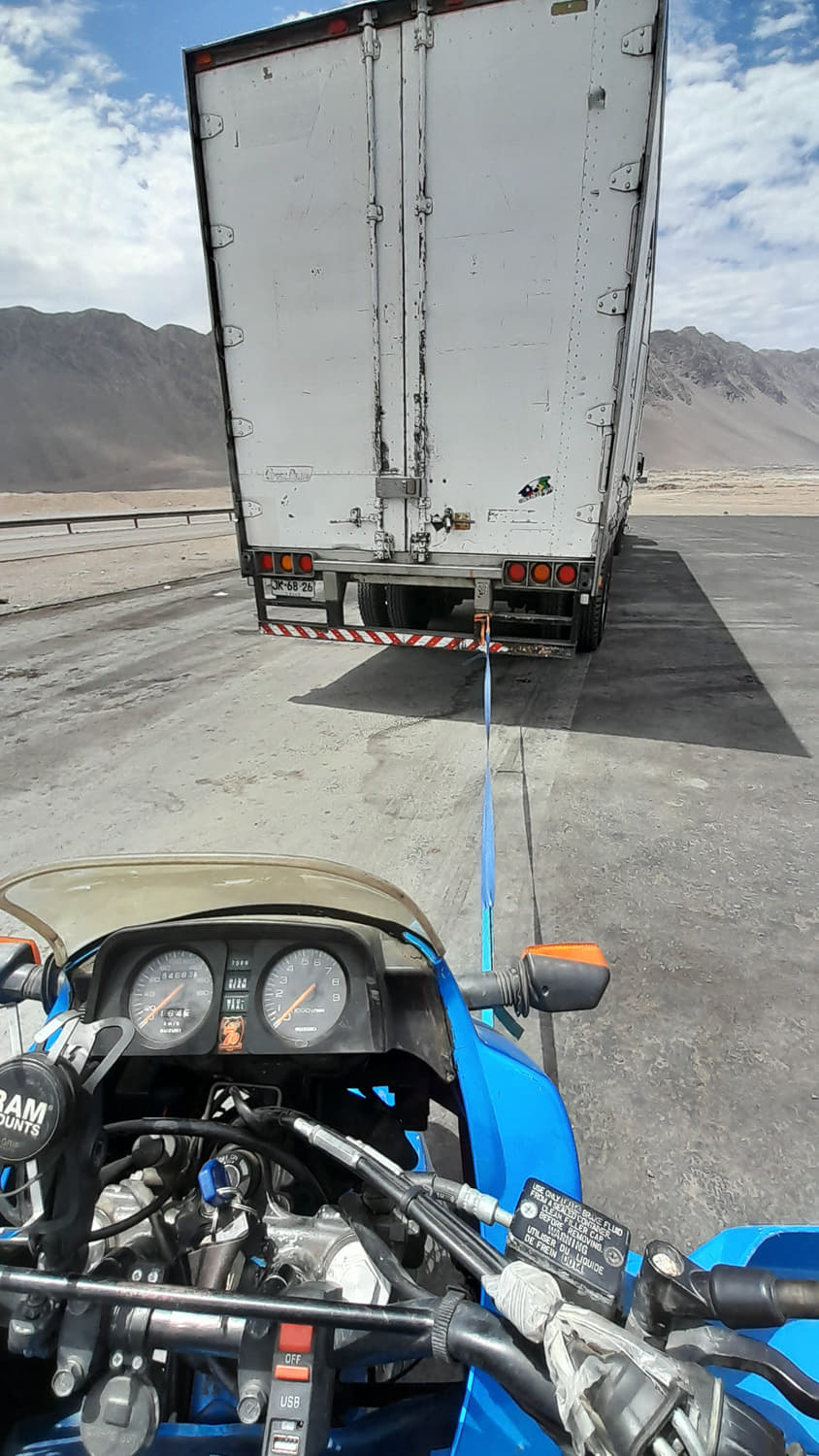
I've never been towed by a semi. There is a first time for everything.
I thanked the drivers and started packing my gear while the engine was running. Drivers of another truck saw me being pulled and told me that they had a ramp behind and could transport me to a shop. I thanked them, but decided to ride myself the remaining 300km to Antofagasta. They told me that I should never worry about broken bike in Chile, someone would always help me. They added that they always stop to offer help to riders with motorcycle problems.
With bike running again and encouraged by the truck drivers, I continued my ride south. I knew that I would not be able to shut off the bike for the next 300km. There was virtually no traffic on this desolate, very scenic road. Here, Atacama desert, the driest place on Earth, descends to meet the Pacific ocean. Other than some fishermen shacks here and there, there was nothing along this road.
As my luck would have it, my fuel consumption was much higher than normal and my engine started stuttering. Being on a borrowed bike, I didn't know the reserve position of petcock valve. I fumbled with it till the bike came to a stop, at the lowest point, with the closest hill several kilometers away.
Asking truck drivers for help at a stop was easy. On this desolate stretch of road (dangerous too, as I found later) people are hesitant to stop for anyone. As I sat by the side of the road, considering my options, I kept on replaying words of the truck drivers I had met earlier "You don't have to worry about broken bike in Chile, someone will always help you." It certainly helped me stay calm and confident that someone would help me.

By the time I found "reserve" position of my petcock, motorcycle engine died at this point, with the closest hill miles away.
As the traffic was very sparse, I reluctantly resorted to flagging passing vehicles down. I didn't have to wait too long. The third vehicle I tried to flag down stopped. It was an old pick-up truck with some youngsters inside. When I explained my predicament, they happily agreed to pull me.
With bike running again, I rode rather slowly to conserve gas. Normally, the reserve should get me to the next petrol station, but I knew my consumption was higher than normal, so I was extra careful. Eventually, I did make it to the only town between Iquique and Antofagasta. I stopped at the gas station and begged attendants to fill up my bike without me turning off the engine. They smiled and filled up my bike without any complaints.
Even though city of Calama was closer, I was told that Antofagasta is a bigger city and I may have better chances of finding a good mechanic there. So, I pressed on. With only 200km left, I was feeling pretty good. Unfortunately, the string of whammies didn't end. I came upon a road construction block. I stopped with engine running and asked how long it would be. The lady told me "only 10min." It's not such a long wait, but engine being air-cooled, I was afraid of overheating. So I begged the lady to let me go carefully against the on-coming traffic. Once again, super helpful Chilenos helped me, she let me go. On-coming drivers were appalled by me disrespect for signalization, but I didn't have other options.

Even though I could not turn off the engine, I stopped several times to take photos.
After two more hours of riding, I finally rolled into Antofagasta. It's a rather big city and I had no clue where I could find a good motorcycle shop. I knew that once I turn off engine, I would not be able to start it again.
Soon after entering the city, I noticed one motorcycle shop. I rode there and turned off engine. The main mechanic wasn't there and young guys who were working there weren't too excited about fixing my bike. However, with the engine off, that was the end of a terrible riding day in Atacama.
In retrospect, I wished I had gone elsewhere as the mechanic was not very smart or capable and it took him 2 and half weeks to fix the bike. It took him six days just to remove the magneto! WTF! Any illiterate mechanic in Colombia or Peru would have found a way to remove it in no time, but this guy "didn't have the tool." It took him four days just to place an order for the spare part that a shop in Santiago had in stock. On the top of it all, he charged me an exorbitant fee.
The worst part was that he kept on lying about when the bike would be ready. "I don't have a crystal ball to tell you when the part will arrive", as if that was the first time he was ordering parts from Santiago. To add insult to injury, he wold repeatedly tell me how my bike was "too old" and I better get a newer bike. My problem wasn't the bike, it was the incompetent mechanic.
But things do go wrong and sometimes one ends up with a bad mechanic. I read plenty of horror stories of local mechanics damaging travelers vehicles. That's all a part of adventure riding. I just wish I had gone to Santiago to visit a friend instead of changing hotels every couple of days and ending up in few dumps.
Regardless of the frustrating experience with the extended wait in Antofagasta, I cherished my experience in Chile. Always ready to help Chilenos warmed my heart.

For the first few days in Antofagasta, I reveled in the fact that I wasn't stuck in the middle of Atacama desert.

Chilean wines are among world's best. They certainly helped with the mechanic blues.

One of the nicer stays in Antofagasta.
My luck turned for better when I came across Juan's BnB, clean, comfortable and cheap. In addition, Juan is a great person. He felt sorry for my woes with the mechanic and took me around almost every day. We went to several places around Antofagasta - Portada, Capricornio, Juan Lopez and Mejillones. Juan is a retired engineer who worked in mines and he told me many interesting stories about his life in Chile and his country. Despite all the problems with the mechanic, I have fond memories of my time in Antofagasta, thanks to Juan.
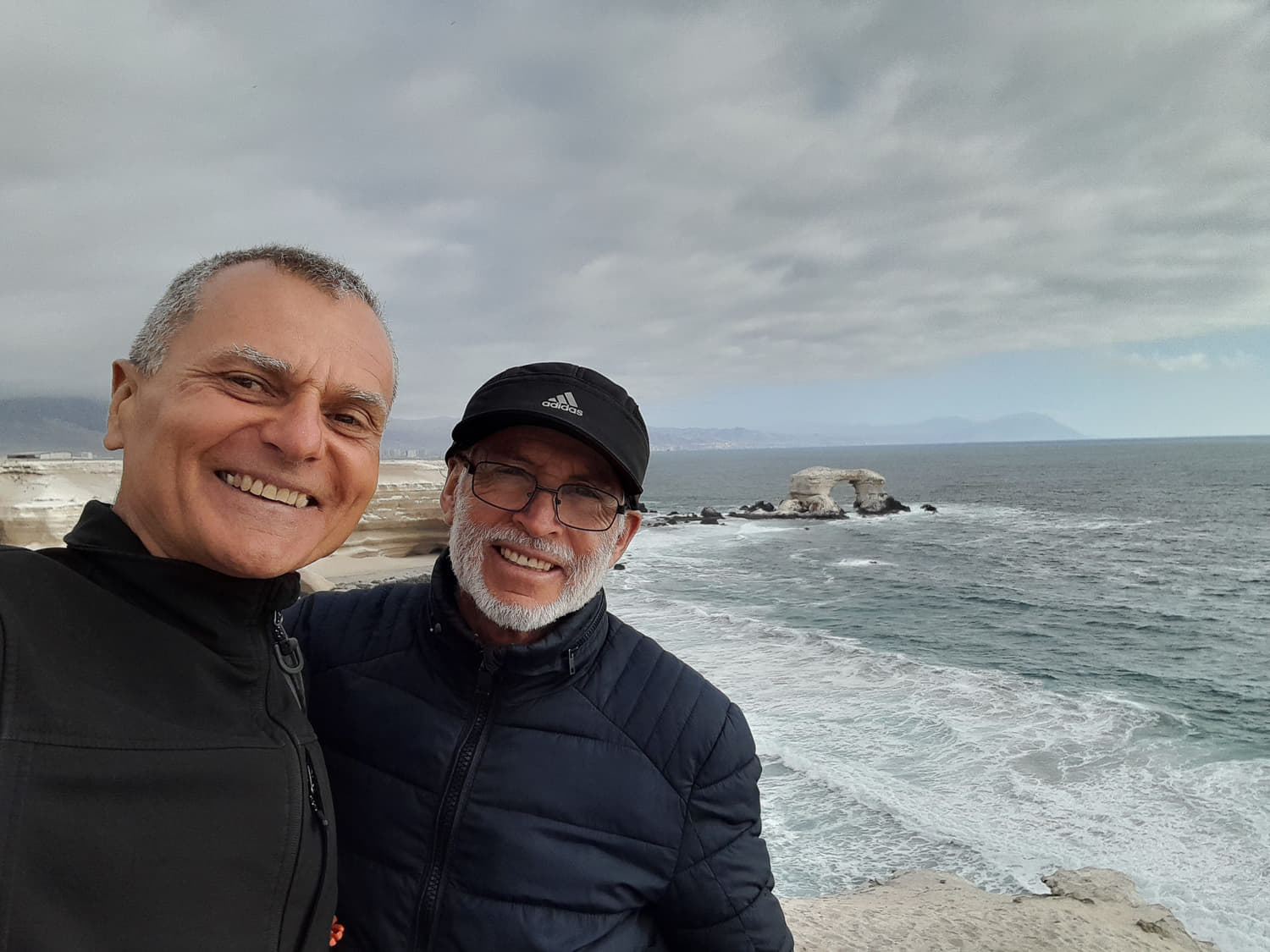
Juan took me La Portada, Antofagasta's landmark.
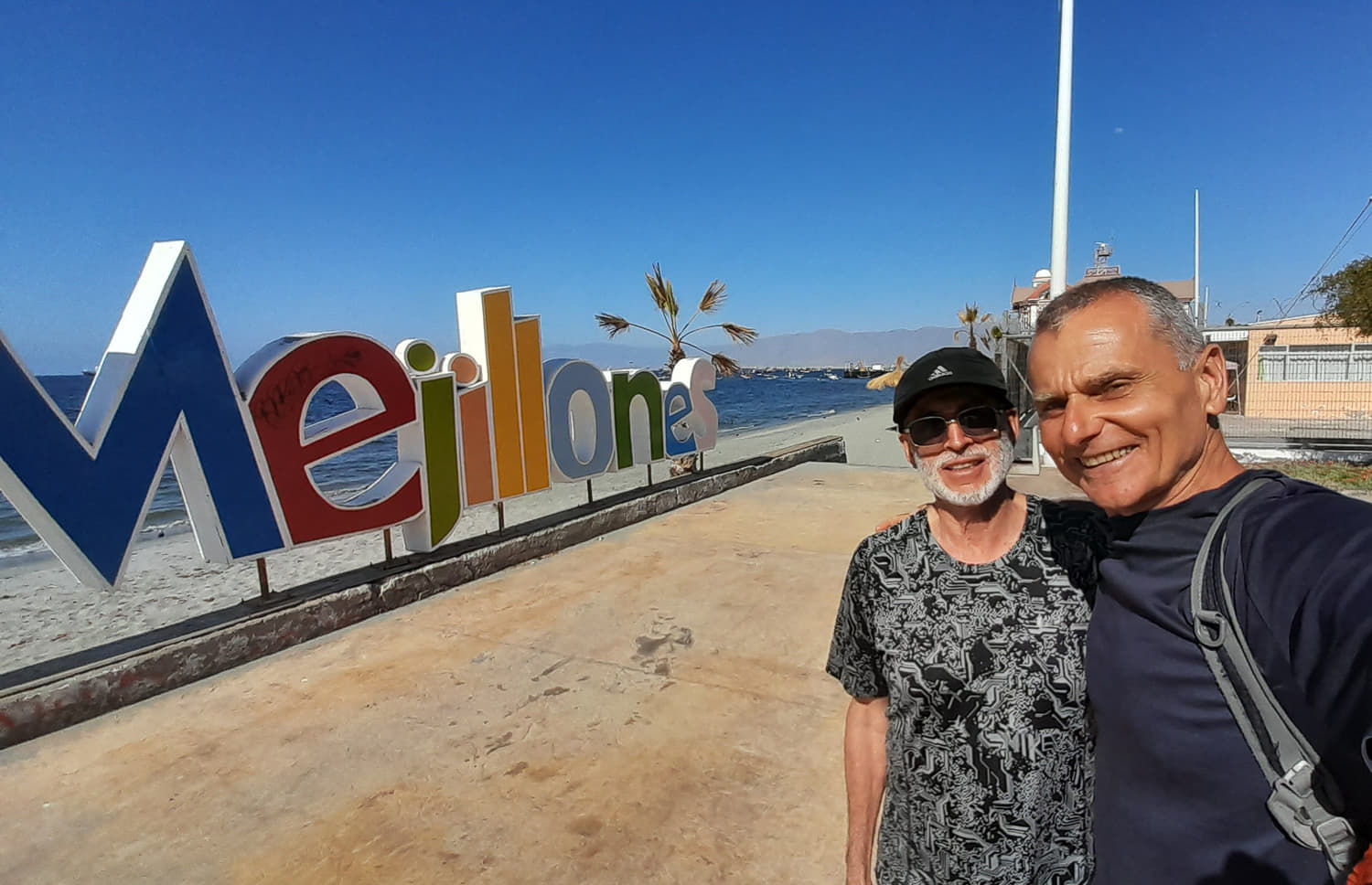
One day we went to Mejillones, a touristy seaside town 80km north of Antofagasta.

Central Antofagasta.

Giordano Bruno was burnt alive by the Catholic Church for being an early fighter for the freedom of speech. It's good to see that he is still remembered around the world.
.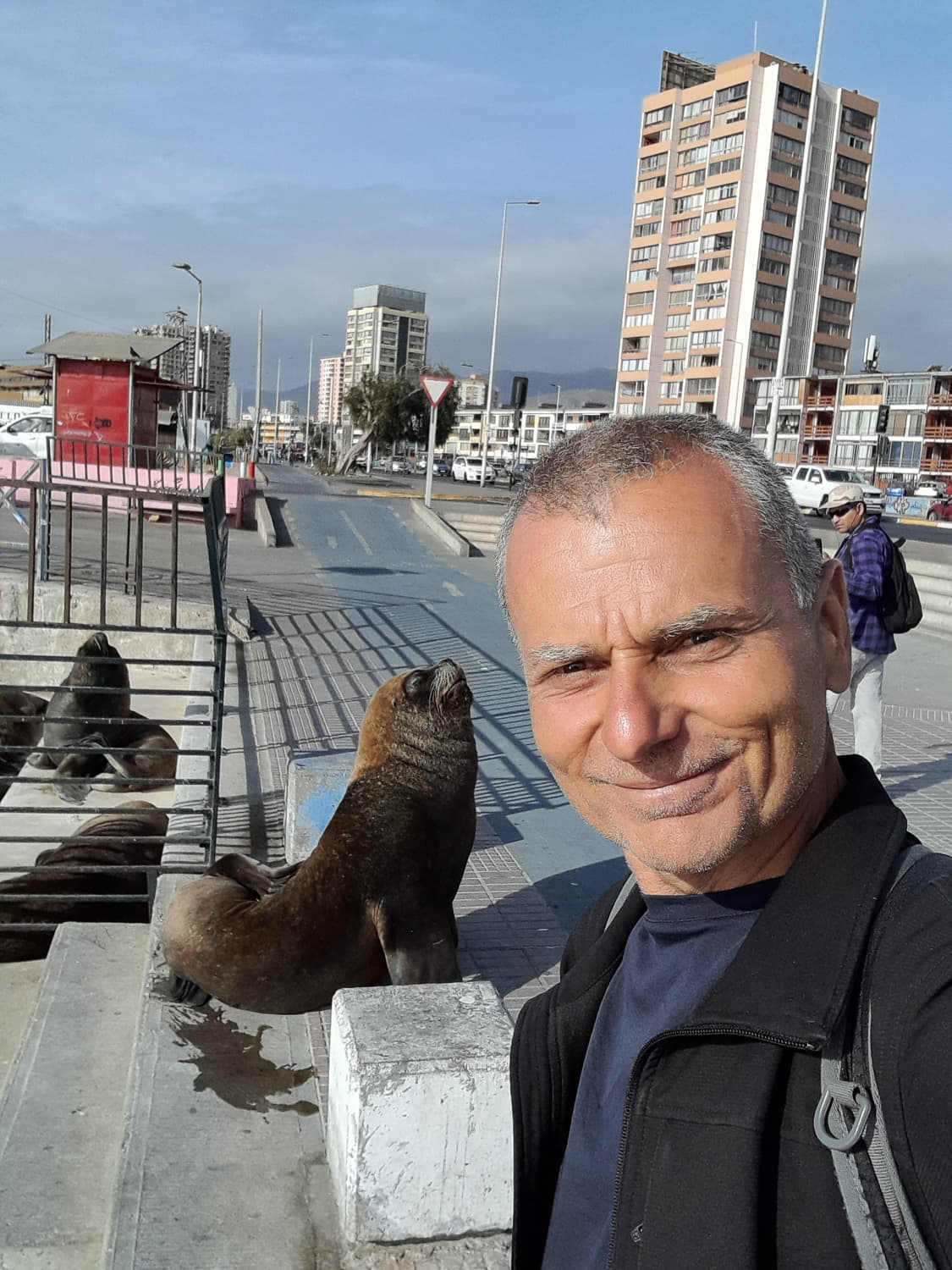
During Covid lockdowns, sea lions got used to sunbathe on this seaside avenue. Now, people are back on the streets, but sea lions still think it's their territory.

One of many beautiful sunsets in Antofagasta.
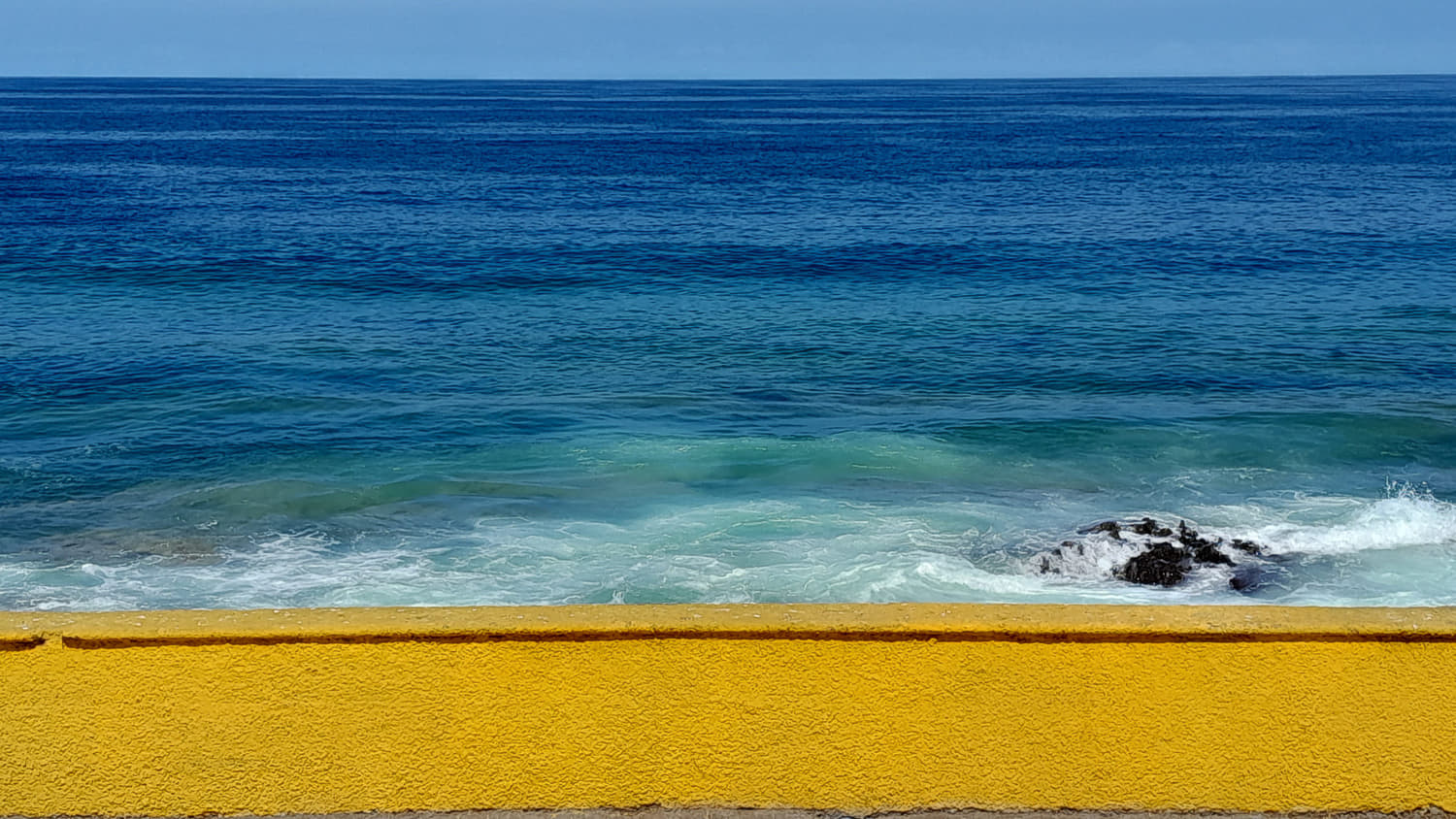
Antofagasta is a long and narrow city, stretching for over 30km along the Pacific ocean.

I noticed cracks on my aluminum panniers. A local welder wanted $65 for two 10cm welds. Juan thought it was a ridiculous price and he helped me reinforce panniers for less than $10.

Even though I had great experience in Chile, after two and half weeks of suffering with the mechanic, I felt I had to get out of Chile (not that it matters, but the mechanic wasn't Chileno). So, I rode to San Pedro de Atacama with the hope of going to Bolivia to visit Salar de Uyuni.
Salar de Uyuni, a very special place, is the main reason one would want to visit Bolivia (especially for second time). Despite being the only country of S America requiring $160 visa fee, I was determined to enter Bolivia again. I checked out of Chile and rode over to the Bolivian side.
Doors of the immigration building locked, nobody to be seen anywhere, I walked around knocking on the doors and windows in vain. Finally, an officer opened the main door, for a tour guide that just showed up (I'm guessing one has to call to announce his arrival).
After he processed the tour group that came after me, I handed over my passport and $160 visa fee. He smiled and showed me a thick stack of documents that visitors needed to submit - photos, bank statements, hotel reservations and an itinerary. Itinerary?! Last time I entered Bolivia, they were quite happy with the visa fees. Apparently they upped their game. Ridiculous visa fee alone is not enough, they want to hassle you, put you down, step all over you. The official excuse is they need all this info to track down visitors who commit crimes in Bolivia. I wonder what the number of visitors to Bolivia who commit crimes v.s. number of visitors that end up being victims of crime in Bolivia is, or what the number of Bolivians working illegally and overstaying their visas in Europe/USA is.
I might have gone for the bank statement and hotel bookings, but itinerary?! Heck now, I do not travel by itineraries! I grabbed my passport, put money away and rode back to re-enter Chile. Only later on did I realize how wise my decision NOT to enter Bolivia was. I kept on reading travelers' reports of road blocks, civil unrests, fuel shortages and gas station attendants refusing to sell them the fuel.
Yes, I wanted to re-visit Salar de Uyuni badly, but itineraries were the line I could not cross. I know that chances of being punished for not following my itinerary were slim, but still, a cop in need of money could have easily given me trouble (I read somewhere that detentions were a possibility). Why would I subject myself to that kind of abuse. I refused the idea of "itinerary" thing in Angola a year earlier, why bend over for another pathetic country now? Not to mention security, gasoline and road-block problems in Bolivia.

One of many reports about gas shortages in Bolivia. Many more travelers encountered problems getting gas even at stations where the gas was available.

Camper van stolen in Chile, eventually recovered in Bolivia. Bolivia is worried about criminal tourists?
Later on I read reports from other travelers in Bolivia about people standing by the side of the road with extended hands begging for hand outs. Quite sad, but not surprising, considering that Bolivia is the poorest country of S. America. Much like in Africa, I wonder if anti-visitor policies are a result or part of the reason for the desperate economic state of the country.
Partly disappointed and partly glad that I decided not to enter Bolivia, I turned back and re-entered Chile. It was already around 5 pm, but the days were pretty long. I thought I could make it to Argentina before dark, but I forgot just how wide Andes are. The road stayed at above 4000m for over 300km. By the time I descended below 4000m, it was already dark and I ended up camping at a graveyard (at least it was quiet and nobody bothered me).

On the way to Jama pass border post with Argentina. Road goes above 4800m in places. It's a very inhospitable place. Having spent 3 weeks at the sea level before this ride, I had a splitting headache.
More than an hour after the sun went behind the mountains, I was still at over 4000m with no suitable camping place in sight. I kept on riding in hope of dropping to lower elevations.

Argentinian side of Jama pass. Still another 100 miles at over 4000m. Interesting, beautiful in a way, but very inhospitable place.
Finally, just before it got pitch black, I saw a few houses and a side road. I followed the dirt road for a few hundred meters and saw a walled compound with an open gate. I rode in and it seemed quite and suitable for camping. Only after I stopped did I realize that it was a cemetery.

My quiet campsite in a cemetery.
Even though cemetery was quiet, I did not sleep well because of the altitude. At one point I thought I was going to puke. I also saw lightening in the distance. A major storm was pounding vallley to the east. So I wasn't too sad that I couldn't get further.
I woke up to a beautiful morning an continued my descent. After a series of switchbacks, I ended up in a dry and windy valley and soon after in the city of Jujuy.
I always felt funny about Argentina - cheap, good food, wines, pleasant people, yet it somehow lacked something. I can't quite put my finger on what it is, but I simply never felt a draw to spend much time there. 800km of straight road from Salta to Resistencia did not help change my feelings about Argentina. So, 4 days after entering it, I was happy to cross into Paraguay.
On my previous ride through S. America, I missed Paraguay, so I wanted to make up for that this time around. After one of the most laid-back border crossings (near Asuncion), I was enjoying tropical heat in my hotel near Asuncion downtown. Even though there wasn't much to see, I enjoyed quiet afternoon and my first Acai of the trip.

A new bridge over Paraguay river outside Asuncion.
Next day, I rode across the country to Ciudad del Este, where I visited a waterfal and Iatipu power plan, until recently, world's largest.

My first Acai of the trip.

Monday Waterfall in Ciudad del Este.
Worn out by the mechanic, Bolivian BS and Argentinian boring roads, I was quite excited about entering Brasil. Besides, I could not find badly needed spare parts for my bike anywhere - countersprocket and brake pads. My Brasilian friend contacted her friend in Maringa and he managed to get those parts for me. So, Brasil, here, I come!

15,000km route around Brasil.
It's strange how some countries feel like home as soon as I cross the border. Brasil is one of them. It's the people, like one Brasilian friend told me, uninhibited welcoming and helpful.
As I approached the border, there was a several km long line of vehicles waiting to cross the bridge to Brasil. While I was trying to zig-zag around cars, some Brazilian riders waved to me to follow them along side streets to bypass the line and get onto the bridge. There were special motorcycle lanes to bypass the traffic. Gotta love a country with "moto" lanes! Border officials were just as welcoming. The entry into Brasil was smooth and efficient and before too long, I was in the country.
Brasil is a huge country, world's 5th largest. Even though a big chunk of the country is the roadless Amazon basin, there are still so many towns, cities and sights to visit that I would really need a year to do Brasil a justice.
During my first ride through Brasil, I spent more than a month riding along the coast from Uruguay to Salvador and then along transamazonica road and Amazon river to Manaus and eventually exiting Brasil to Peru via Humaita and Porto Velho. I barely got a taste of Brasil and I was longing for a return visit. I didn't know it would be another 14 years before I get another chance to explore Brasil on a motorcycle.
Even though I had visited Iguazu Falls on my first ride around S. America, it was from the Argentinian side. This time, I was passing through, so why not visit it again, from Brasilian side. Even though I went there before the park opened, it was unbelievably crowded. I walked the length of the falls and was happy to be done with "touristy" stuff. I started my long journey north towards Belem.

Mighty Iguazu Falls shortly after record 24 million liters per second of water flow.

Another view of the falls with Devil's throat in the distance.
First stop was the city of Maringa where a new countersprocket was waiting for me. My friend showed me the city, where good motorcycle stores are and told me about his life in Brasil. He also recommended me to visit Bonito, some 1000km west of my planned route.
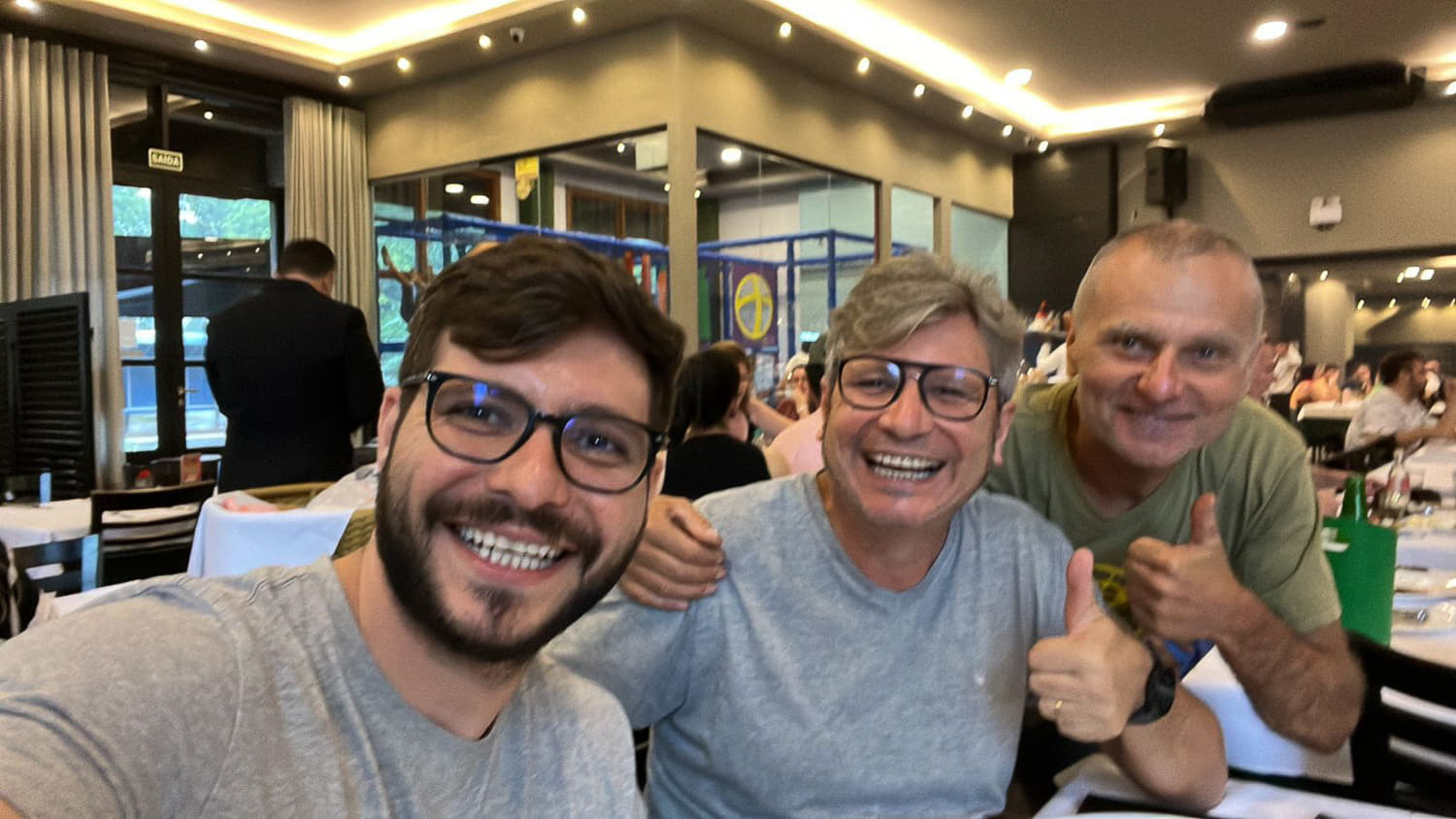
Friends and fellow riders who got me a new countersprocket and brake pads.

The new and old, badly worn out, countersprockets .

City of Maringa is a well-planned city, founded in late 40's and built by a British land development company.
It took me almost two days of riding to get to Bonito. The sights are scattered about the village and they have agencies all around town selling tours. Even for visiting a cave, one has to book a tour through an agency. Very organized, but not exactly my idea of travel. So, after two days in Bonito and two tours, I was ready to continue my journey north.
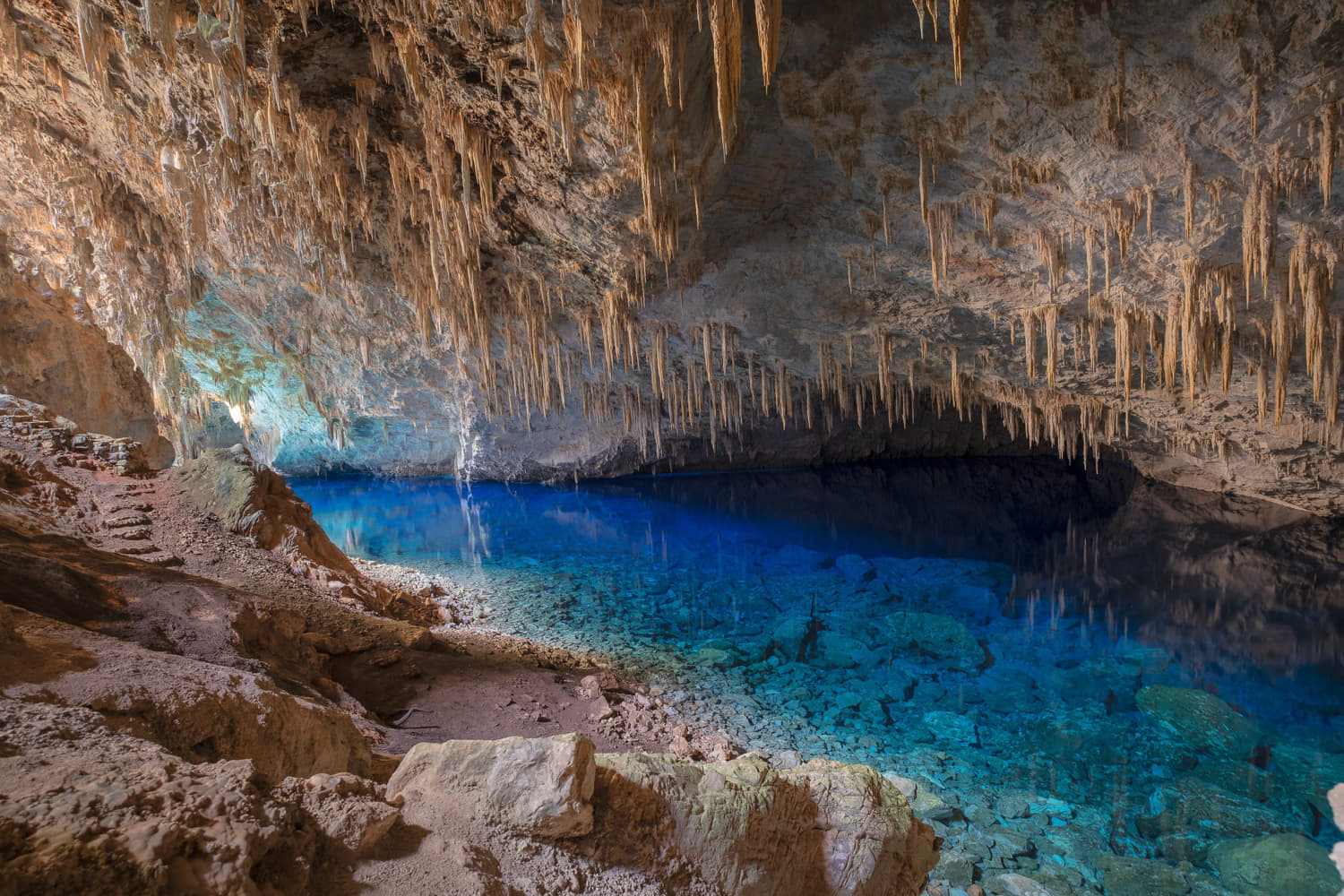
One of the caves with incredibly clear, blue water in Bonito.

Floating down one of the rivers around Bonito is another popular activity.
I don't remember seeing any breathtaking photos from this part of Brasil. Now I know why - it's all farmland. I've never ridden or even driven through Midwest USA, but I'd imagine that the scenery is similarly uninspiring for a motorcycle rider. There were some old colonial towns that I wanted to visit along this route and I certainly wanted to visit the capital, Brasilia. What I didn't know, were many large cities that I had never heard of. I guess I shouldn't be surprised considering that Brasil is world's 5th largest country with the population of 250 million people.
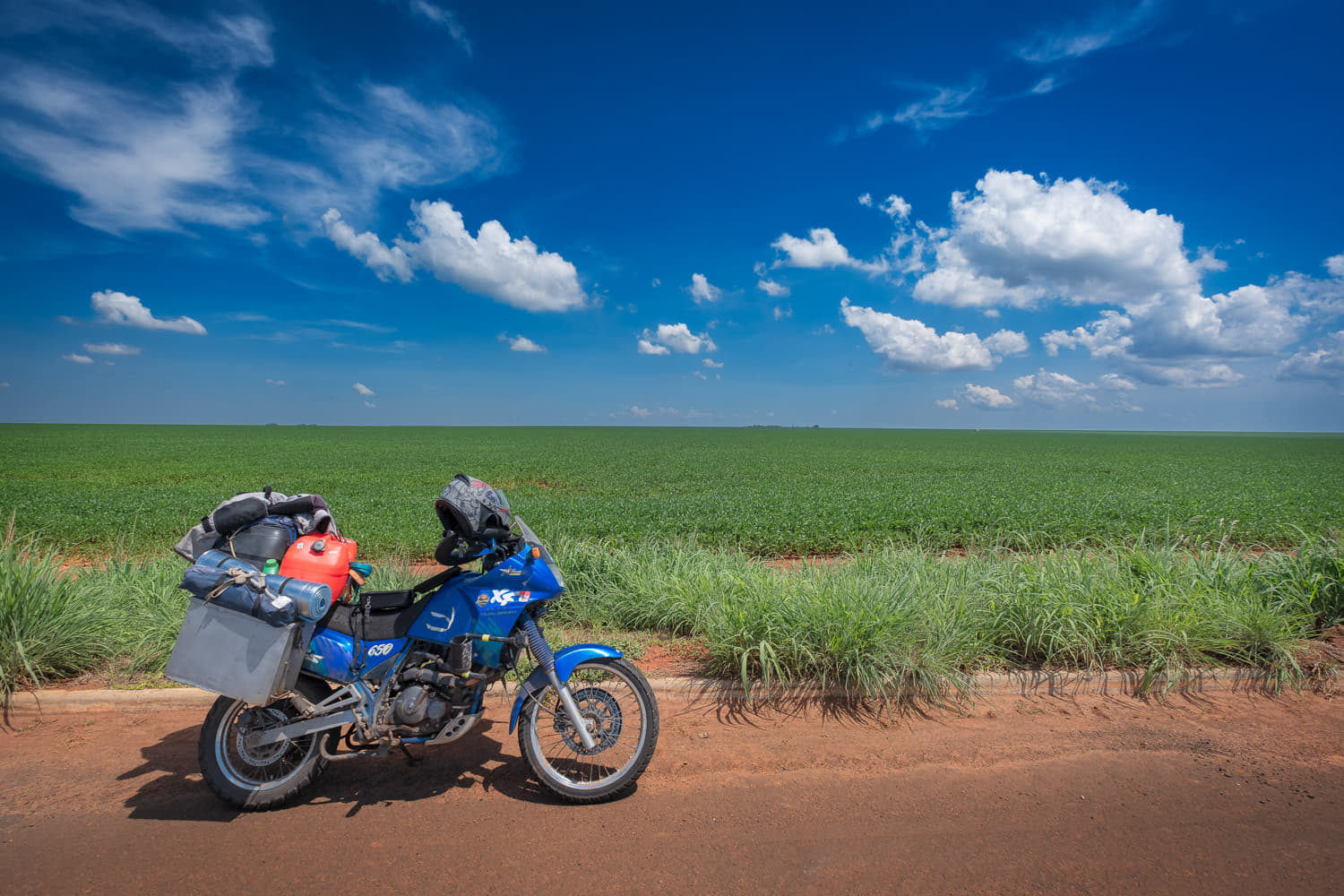
I had never seen such huge farms and so much land under one single crop - soy beans. I was told they use soy beans for animal feed.
Chapada dos Veadeiros National Park was a welcome break from the monotony of endless farms. Even though mountains weren't particularly high and the area was semi-arid, there were some beautiful waterfalls to visit.

Mirante de Janela, one of the most popular spots in Chapada dos Veadeiros National Park.

Goias - an old colonial town west of Brasilia.

Piresopolis is another popular colonial town near Brasilia.

Street art in Piresopolis.
Brasilia, designed from scratch and purpose built to be a new capital, is a UNESCO world heritage city. It was designed by a group of architects, of which Oscar Niemeyer was the most famous. The whole city is laid out to resemble an airplane with wings and fuselage representing various sections - residential, business and governmental sections.
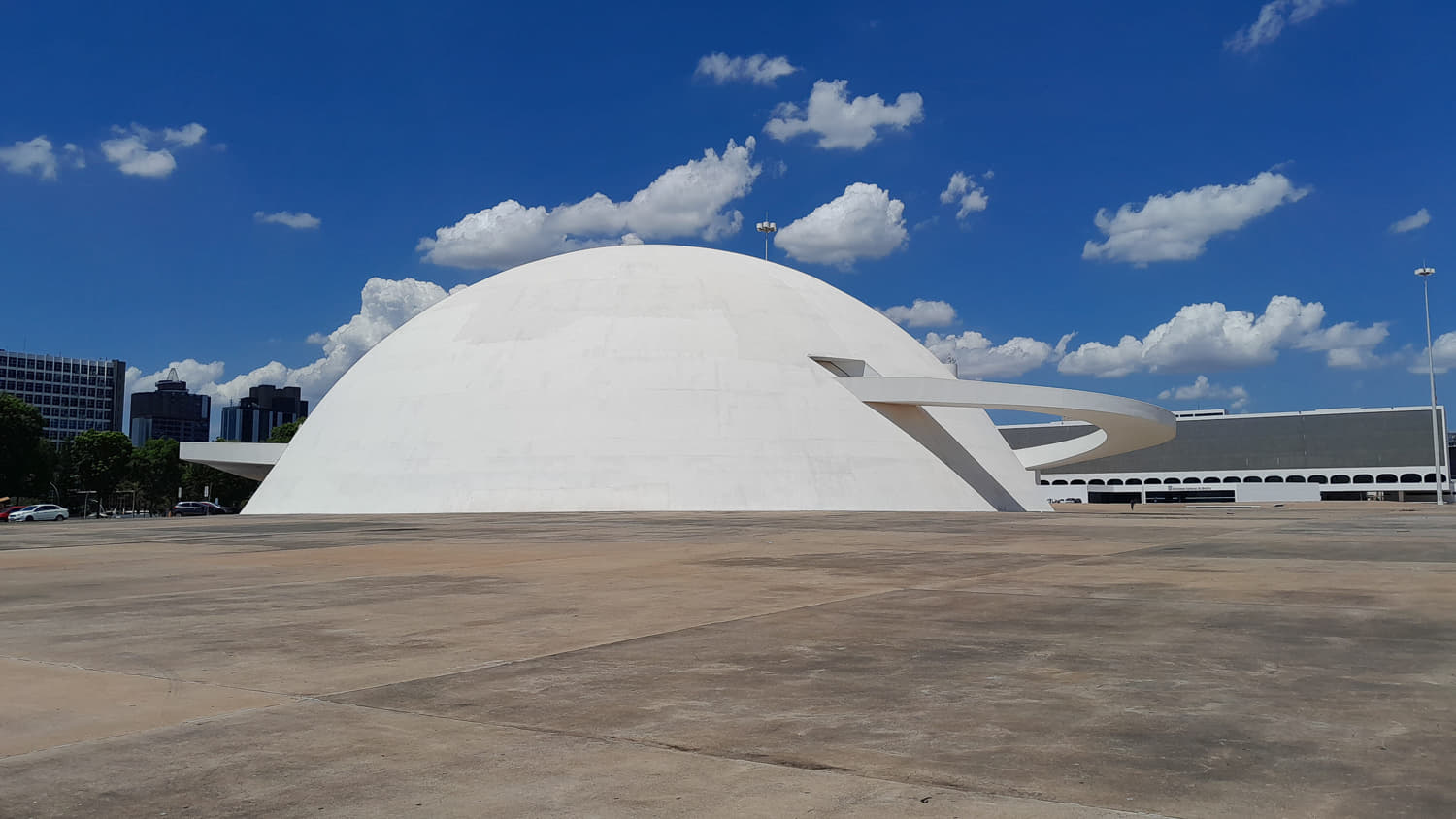
Brasilia is full of funky buildings. This is the science museum.

National Cathedral in Brasilia.

Natonal Congress Palace in Brasilia.
After a few days of 500-600km of riding, I finally arrived in Belem, the place I wanted to visit even during my first ride, but Brasilian distances dissuaded me. While waiting for the motorcycle to be fixed in Antofagasta, I kept on looking at the map and Belem looked so far away. It took me over 8,000km and more than a month to finally reach Belem.
I enjoyed oppressive tropical heat, tropical fruits of the Amazon and sights of Belem for two days, reveling in the fact that I finally made it to this gateway to the Amazon. Originally, I was toying with the idea of taking a boat from Belem to Macapa and riding through Guayanas to Boa Vista and then south to Manaus. But I found out about French Guayana's extortionist motorcycle insurance - $100 for two weeks (there is basically only one road along the coast) and I promptly dropped that idea.

Getting closer to the Amazon region - less bridges and more ferries.

Mango trees are everywhere and ripe fruit just falls on the ground with hardly anyone bothering to eat it. People get spoiled with abundance!

Belem - jump off point for river trips up Amazon to Manaus or across to Macapa. I had always thought that Belem was on Amazon river. It is actually on river Para and it takes a while for the boats to reach Amazon from river Para which also empties into Antlantic a bit south of the Amazon.

A typical boat in the Amazon region.

A menu in Belem - bewildering selection of tropical fruits. I wanted to try as many fruits I had never heard of. I ended up drinking 5 juices.
From Belem I rode to Salinopolis, the northernmost point of my trip. It's a huge, wide, white-sand beach where people drive and camp on. From this point on, I would be heading south, mostly along the coast. Fortaleza, Natal and Recife were the names that had been on my mind for years and now I was finally going to visit them. Uruguay, the final destination, seemed impossibly far away.

Salinopolis - a beautiful beach town marks the northernmost point of my ride. At this point, I was closer to my starting point in Colombia than I was to the destination in Uruguay (as the crow flies).

Alcantara - a colonial village across the bay from Sao Luis.
Between Sao Luis and Fortaleza, there is a very special place - Parque Nacional dos Lençóis Maranhenses. Green lakes nested among white sand dunes. Well, at least that's the scenery after the rain season, when the lakes are full of water. Even though I got there during rain season, the lakes were almost dry. The sky was cloudy too, so the place did not look anything like what I had hoped for.
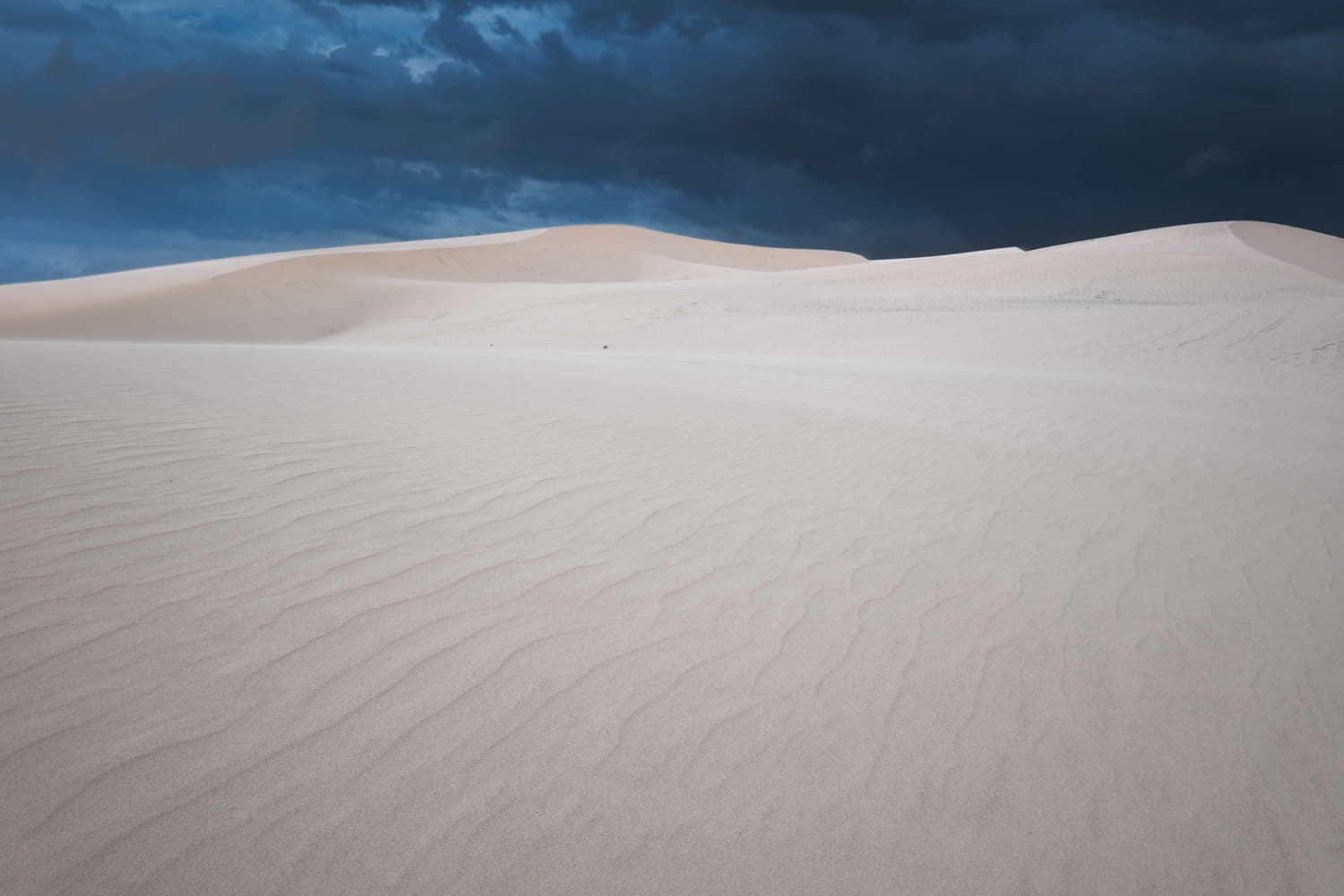
Lençóis Maranhenses sand dunes in stormy weather.

There was one muddy lake and some people even went and swam in it.
I visited another rather touristy place between Sao Luis and Fortaleza - Jericoacoara. It was a typical Brazilian party central - lots of food, booze and music on the beach. There were some sand dunes and a nice beach ride that I enjoyed.
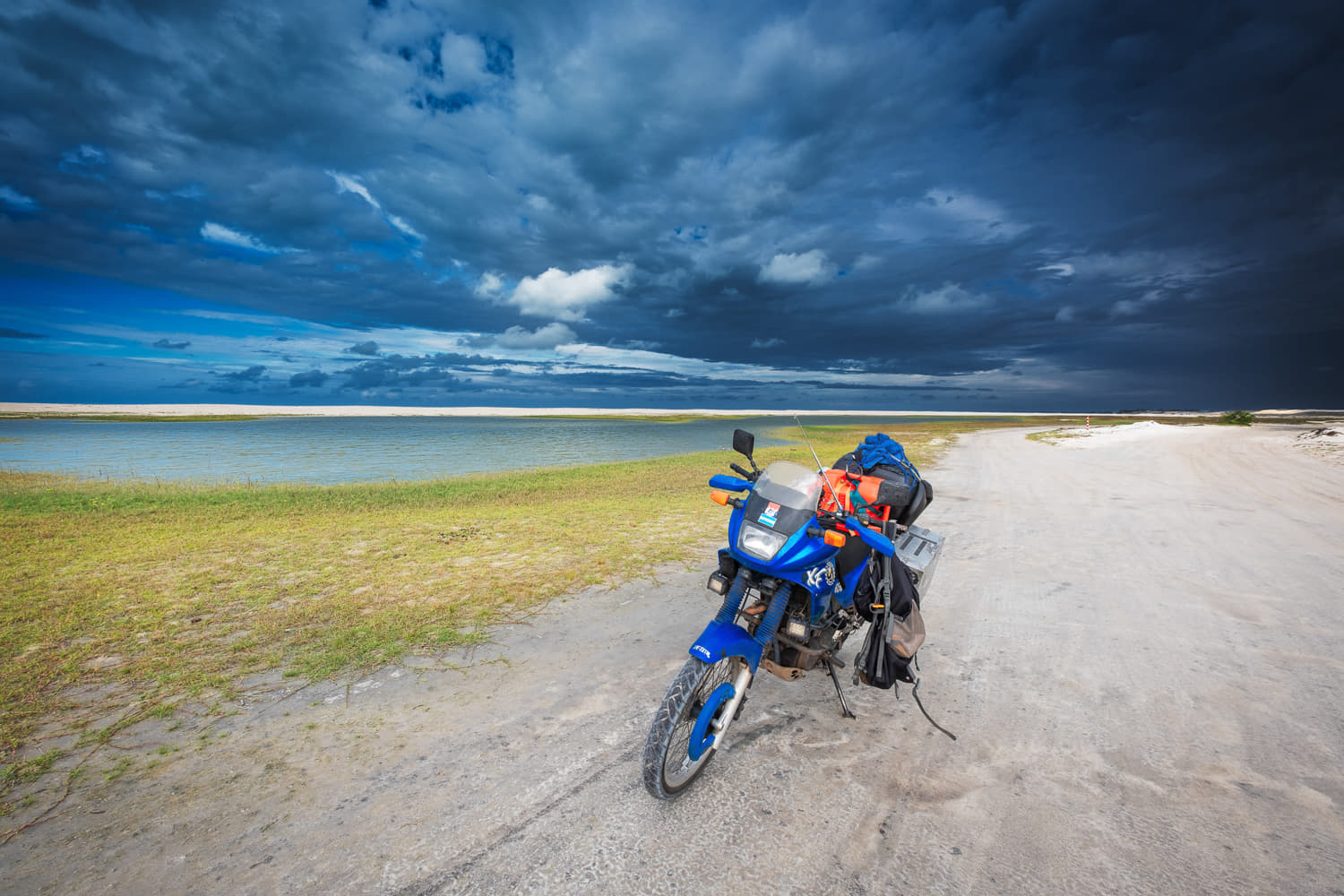
Jericoacoara - paradise for kitesurfing and off-road activies as well as beach partying.

Fortaleza, at long last.
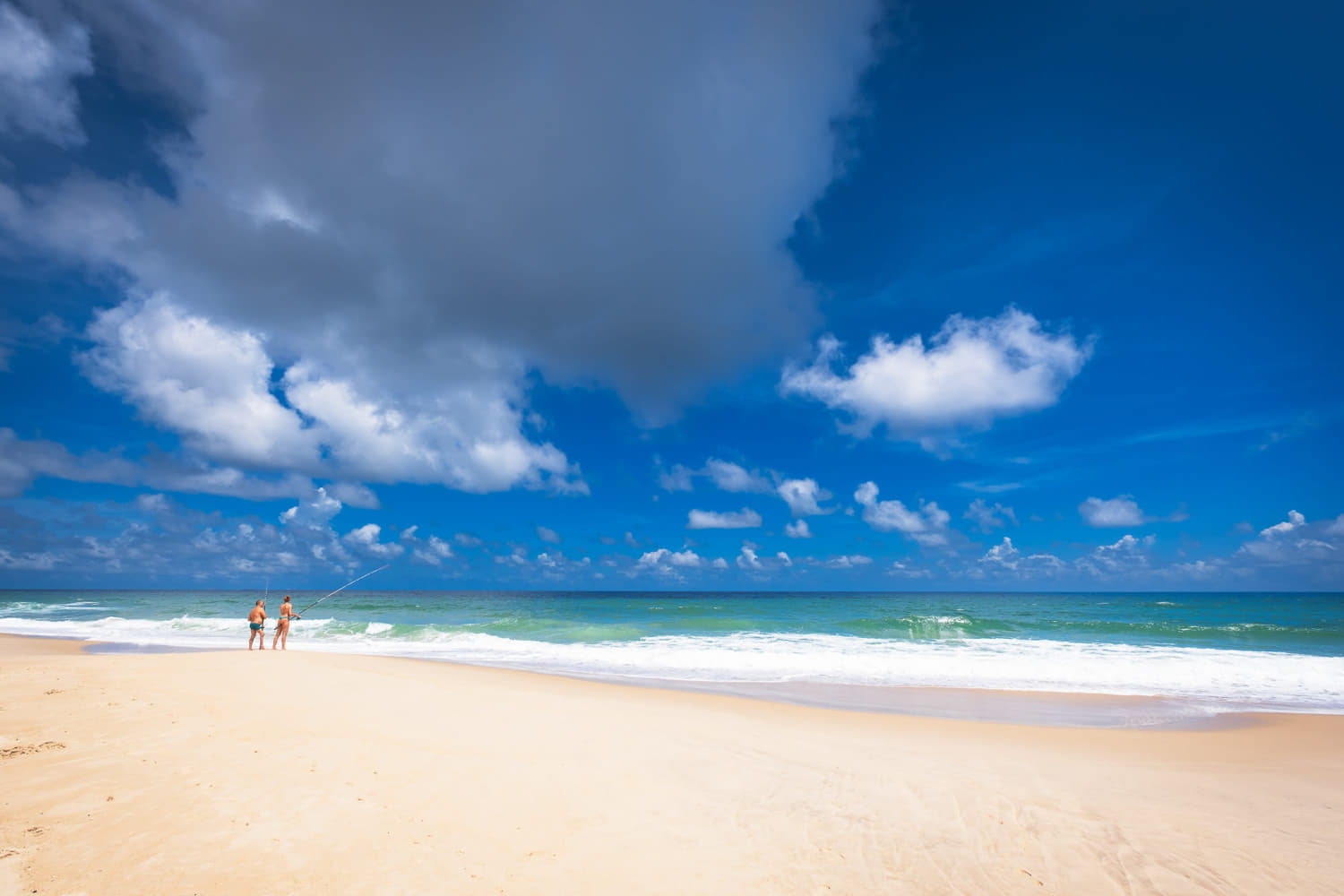
There are miles and miles of deserted beaches south of Fortaleza.

Natal - my favorite beach city in N. Brasil. I rode south and visited some beautiful, quiet beaches and spent an afternoon sitting by the beach in the city, drining coconuts.

A beach in Natal. Even though this beach is very close to the city center, there are sand dunes behind it and it feels miles away from the civilization.

A beach town south of Natal, clean and quiet.

Another quiet beach south of the city. There is a 4x4 road along this beach, but the sand was way too deep for my motorcycle.
Whenever I have a chance, I like visiting geographically important points. Easternmost point of a continent certainly qualifies for that title. Joan Pessoa is the easternmost point of S. America and I had to visit it.

The place where sun is born in South America - Easternmost point of South American continent.
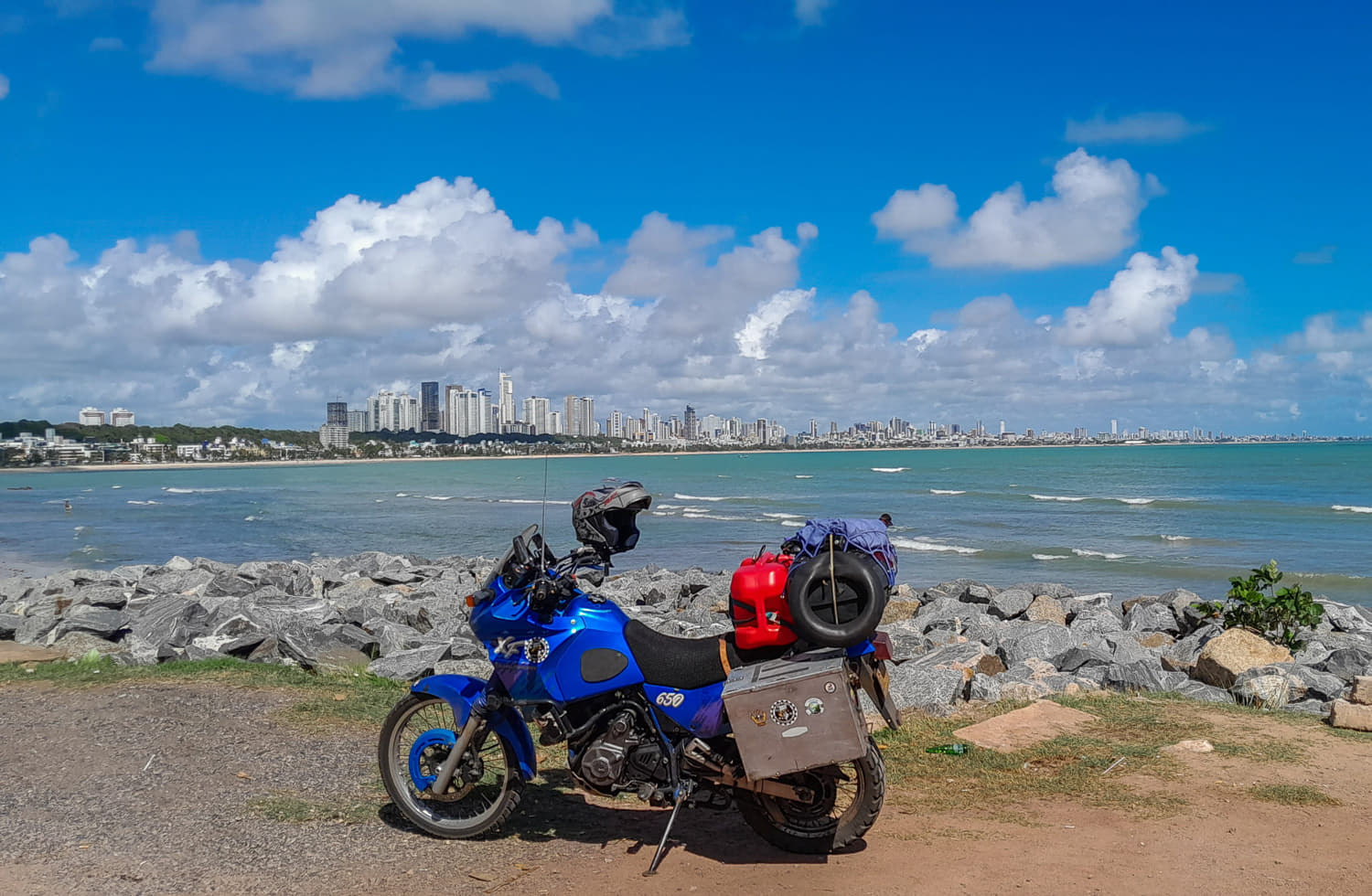
Joan Pessoa is a big city, strung along a long beach.
After riding around the city and its beaches, it was time to head to Olinda, a cute colonial city just outside Recife. As soon as I got on the expressway outside the city, I heard some noise and lost power. I knew it was the chain even before I got off the bike.
When I had chain replaced, back in Peru, they didn't have a rivet master link. They put on a clip-on master link and assured me it would be fine. Well, it was fine for about 18,000km, but a piece of rubber (that I was using as a makeshift chain slider) got dislodged and was rubbing against the chain, causing the clip to fly off and I lost the chain.
I walked back and found both the chain and damaged master link. The master link was bent and useless. I tried straightening it to at least get to some motorcycle shop. I checked my map for nearest shops and there were none in the area where I was. Even an exit was about a mile away. Speeding buses and trucks were passing within few feet of me.
The situation looked bad. Do I leave the bike and all of my things and walk to get help or do I just sit there and cry? If I were to leave bike on the side of an expressway I probably wouldn't find it upon return.
As I banged on the bent master link in a desperate attempt to straighten it, a rider stopped and asked if I needed help. I instantly became a religious convert. I looked up to the sky and whispered "Thank you." Kind rider's name was Cleber. He showed me some shops on the map but I still didn't know how to get to them. He agreed to tow me even though it was illegal to do so on an expressway.
While he was towing me in the emergency lane, a passing bike waved to us and Cleber stopped. Soon after, a highway patrol car passed by. I realized that those riders were warning us about the approaching patrol car. It was heart-warming to know that riders watch out for each other here.
Eventually we got to an exit and then, a couple of miles later, we arrived at a mechanic shop. I thanked Cleber profusely as I thought the mechanic would take care of me. Well, not so fast. He did not have any 525 chain in stock. He explained to us that the only shops that might have 525 chains were in the downtown. So, once again, Cleber swooped in and took me on a tour of Joan Pessoa in search of 525 chain or a master link, at least.

Cleber, my savior who stopped on a busy expressway to help me and towed me to a motorcycle shop.
Even that seemed to be impossible. None of the shops had 525 chain in stock, not even a master link. Shop owners kept on asking me what bike the chain was for?! WTF! It's a 525 chain, it fits on tons of bikes.
I did manage to buy a 525 chain master link but for a non-o-ring chain. Unfortunately, upon the return, I discovered that it did not fit onto my o-ring chain. So, I was still without a solution in sight. It was Saturday afternoon and most shops were already closed. Things looked bleak. I was already contemplating spending two nights in a dull neighborhood hotel and hunting for a master link on Monday.
Luckily for me, another customer in the stop heard about my problems and called his friend who owned a motorcycle shop. It turned out he had a 525 chain in stock. It wasn't D.I.D. chain, but WHO CARES?! At that point, all I needed was a chain, ANY chain would do. Moreover, the shop had "delivery service." For a few bucks they brought the chain to the shop. Unbelievable! I felt my luck was turning for better.
Soon after, the main mechanic came over and installed the new chain on my bike. It took him about 30 min and he did a very good job. He refused to accept any money from me. I insisted, but he wouldn't budge! What a contrast to the mechanic who jerked me for two and half weeks in Antofagasta!
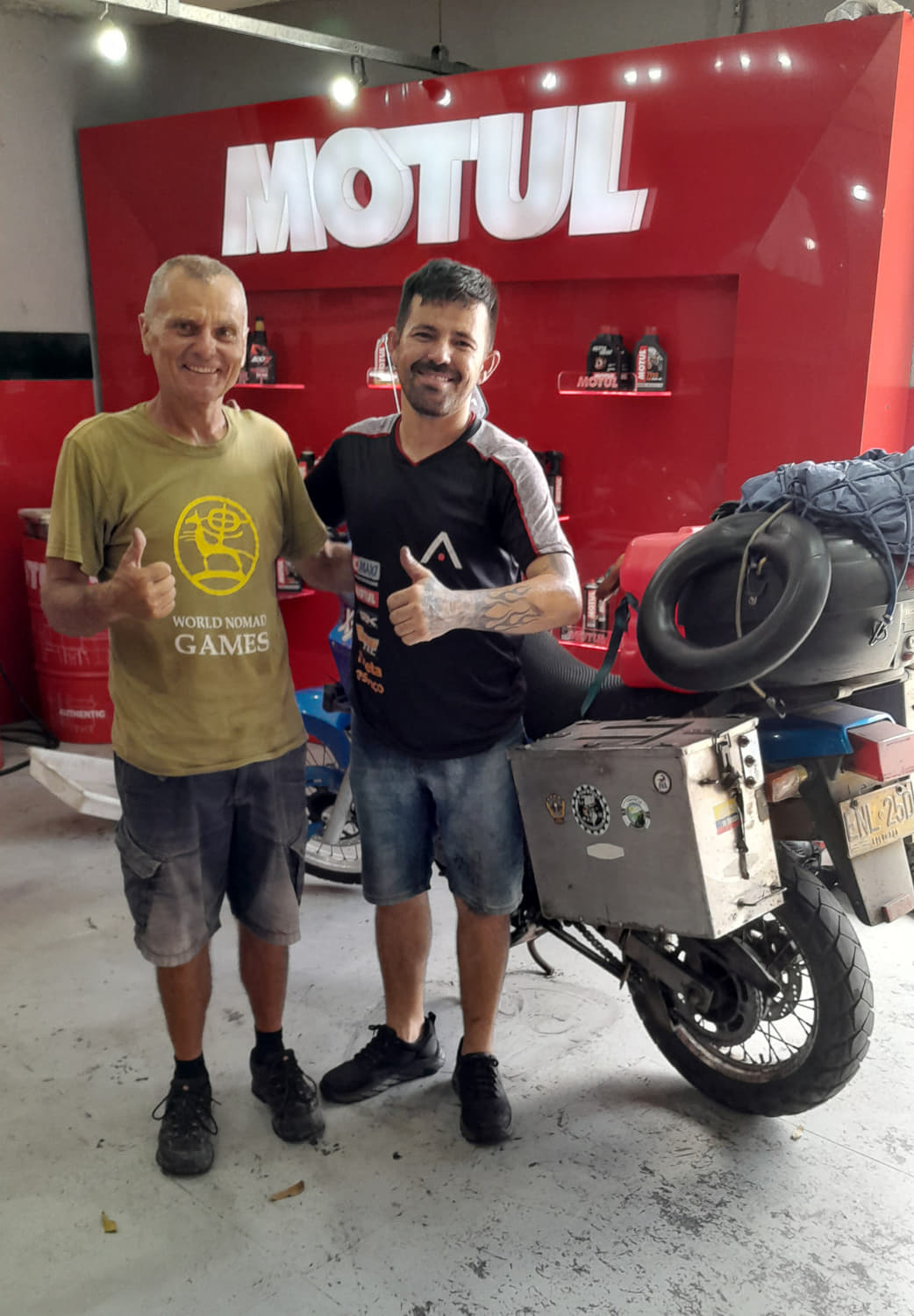
Joan, the shop owner refused to take a penny from me for installing the new chain.
After the drama was over, I took Cleber to lunch and he told me about his family and his life in Brasil. He is a personal trainer who loves volunteering with young kids.
I was supposed to arrive in Olinda in early afternoon. Now I was happy to make it to my place before dark. Upon the arrival at my booked place, I took a shower and walked to the beach just in time for a sunset drink.

Olinda sunrise.
Olinda is just across the bay from Recife. Besides Salvador, it was nicest colonial city in Brasil, IMHO. I spent a pleasant morning walking around the old town. It is clearly a party place as all the bars and restaurants were closed and streets were full of empty alcohol bottles and cups from the night before.
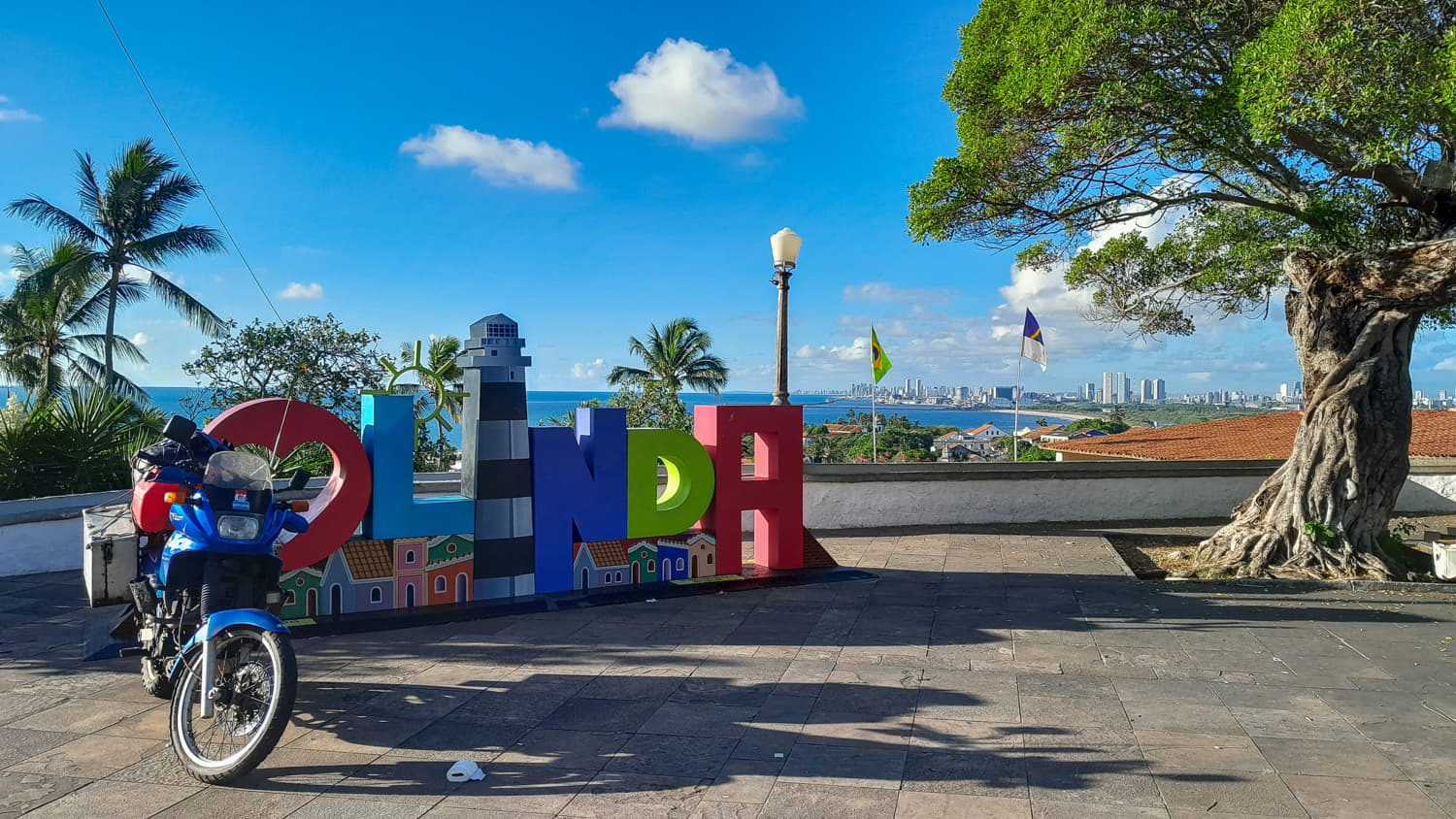
Olinda is a popular tourist destination just outside Recife.

One of many churches in Olinda.

St Benedict monastery.
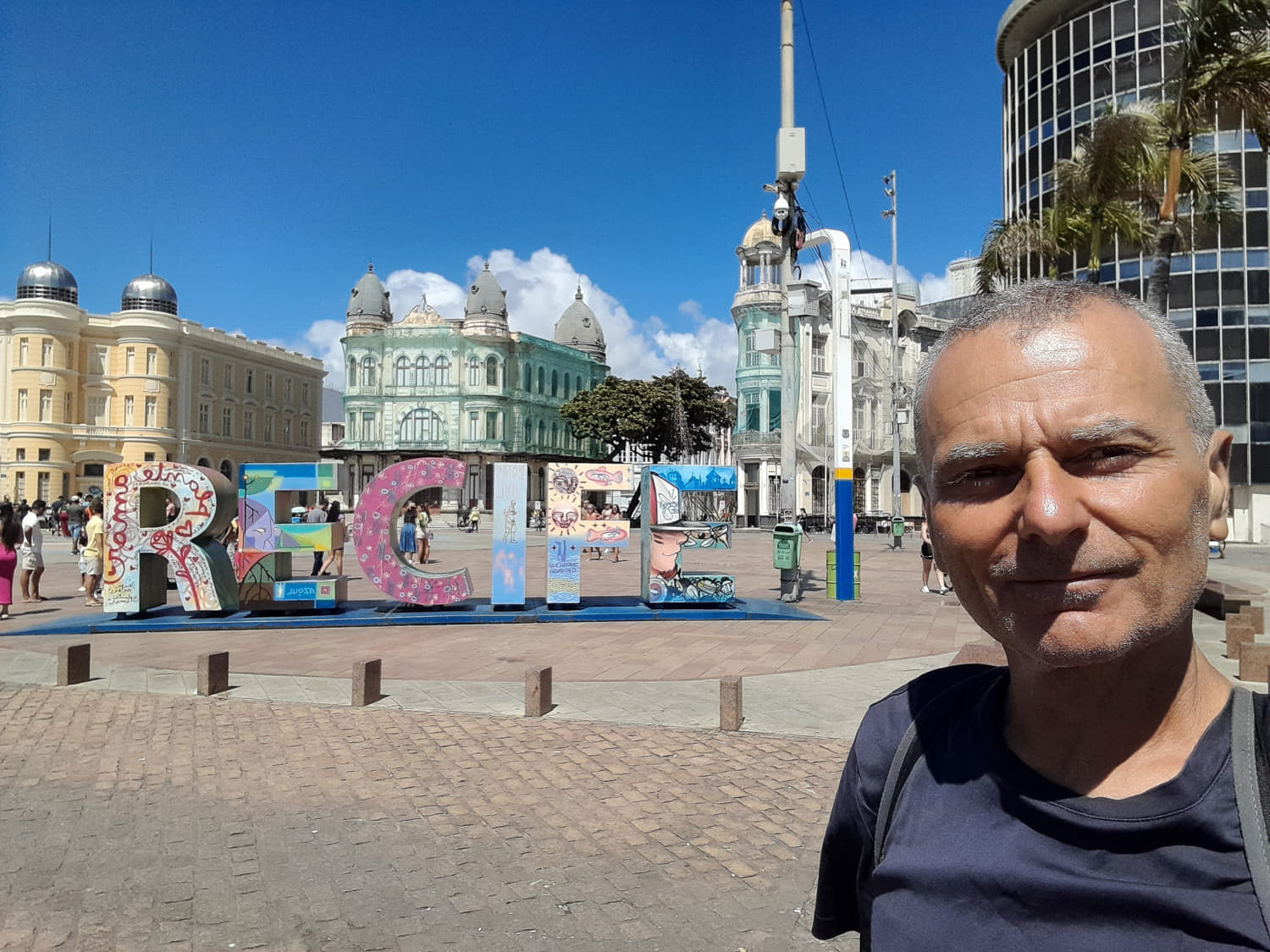
Kilometer zero - old port in Recife.
This part of Brasil is blessed with the most beautiful beaches - deep blue ocean and powdery white sand. I didn't spend much time in the area, but beaches around Maceo were the most beautiful. After two days of riding along various beach towns, I arrived in Salvador de Bahia.
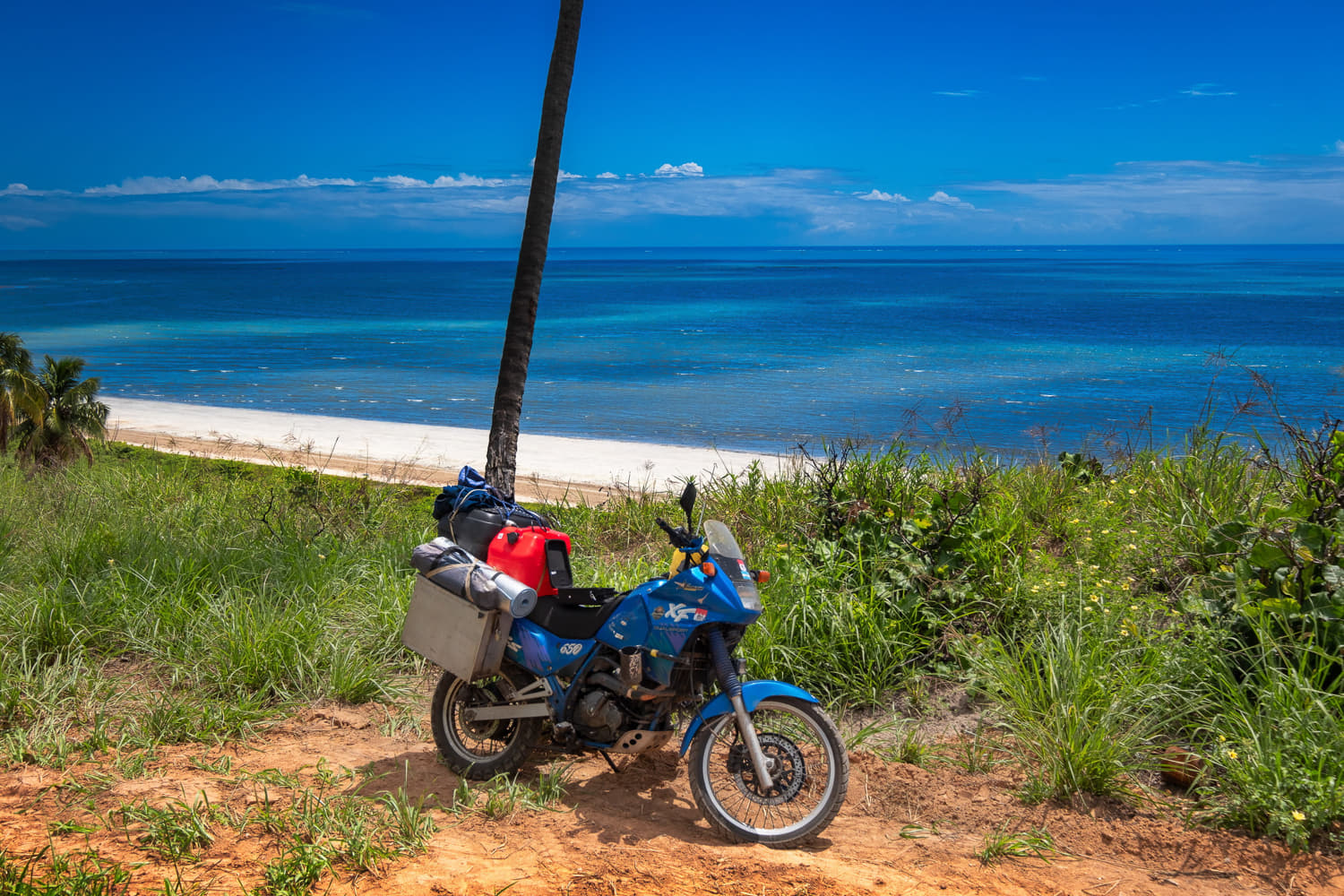
A beautiful beach near Maragogi.
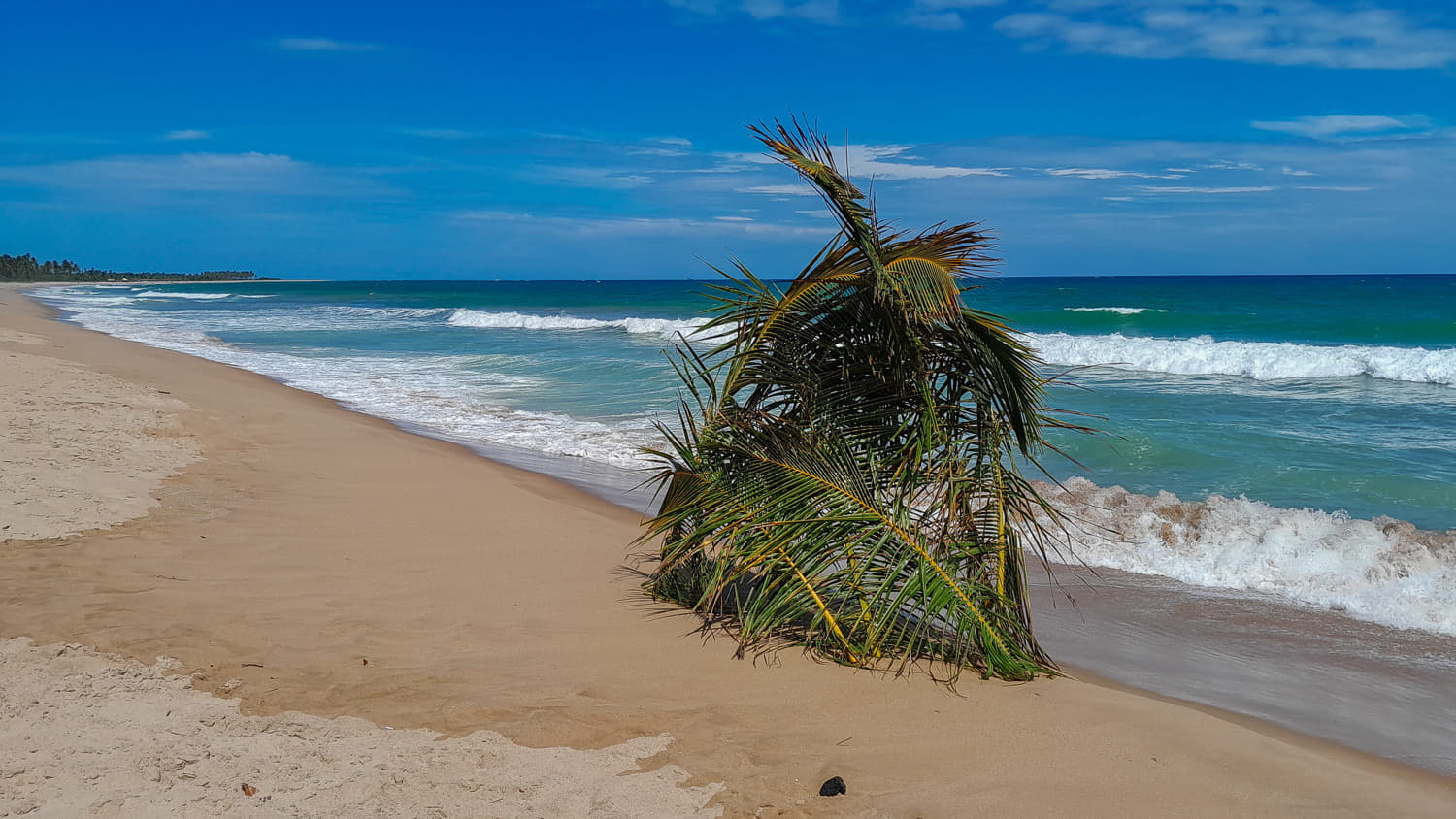
Another deserted beach near Maceo.

Salvador - historic center.

The main plaza in Salvador.

Street art in Salvador.
Salvador is Brasil's first capital, UNESCO world heritage city and the most beautiful colonial city of Brasil. Everyone warned me not to go to Salvador because of the crime, but I couldn't miss this jewel. There was a heavy police presence in the historic center and I thought I was pretty safe there.

Fallen cross - monument to a church that was torn down to make space for Salvador's tram.

This friendly lady offered to pose with me for a tip.
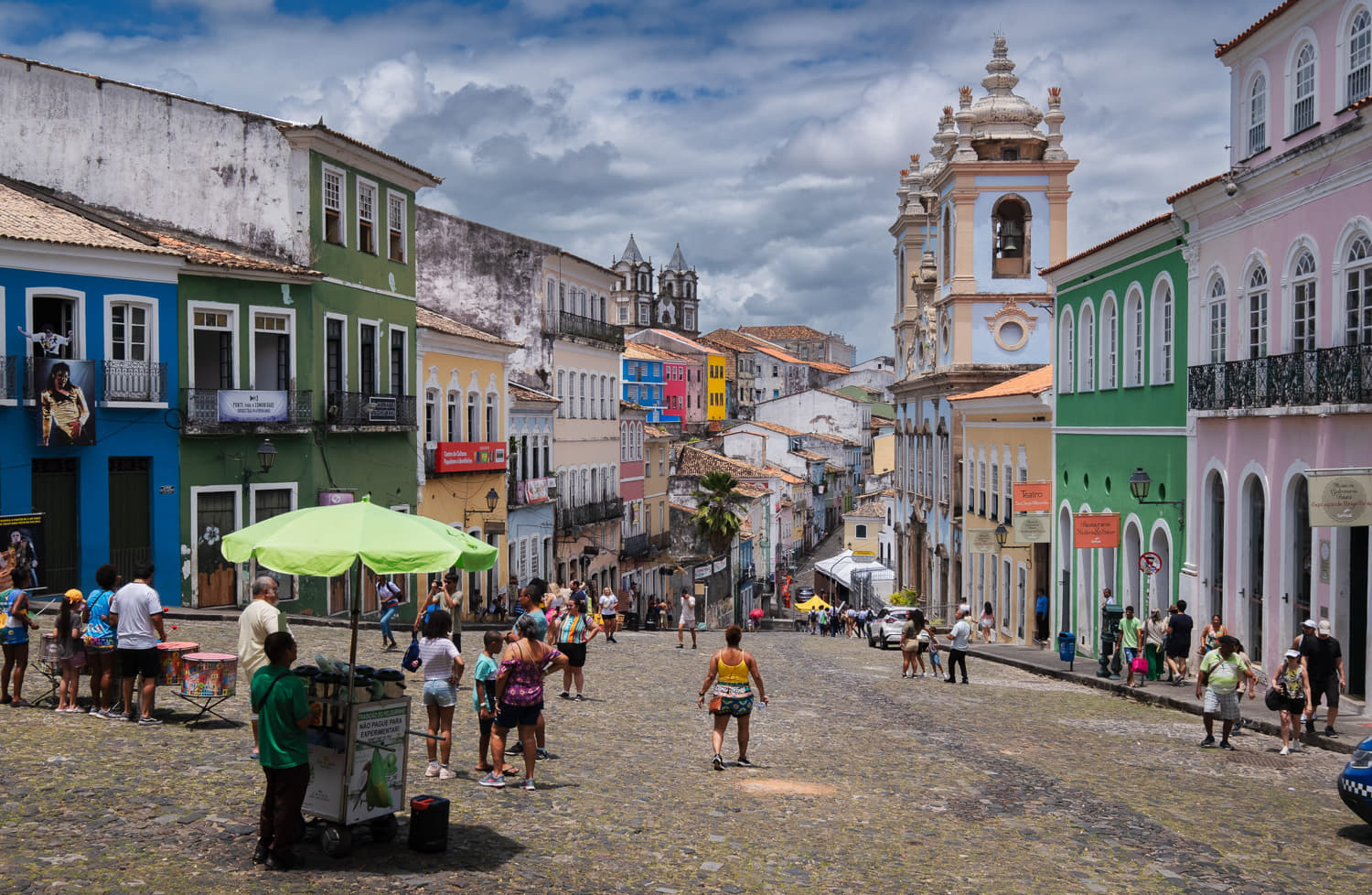
Classic view of Salvador's historic center.
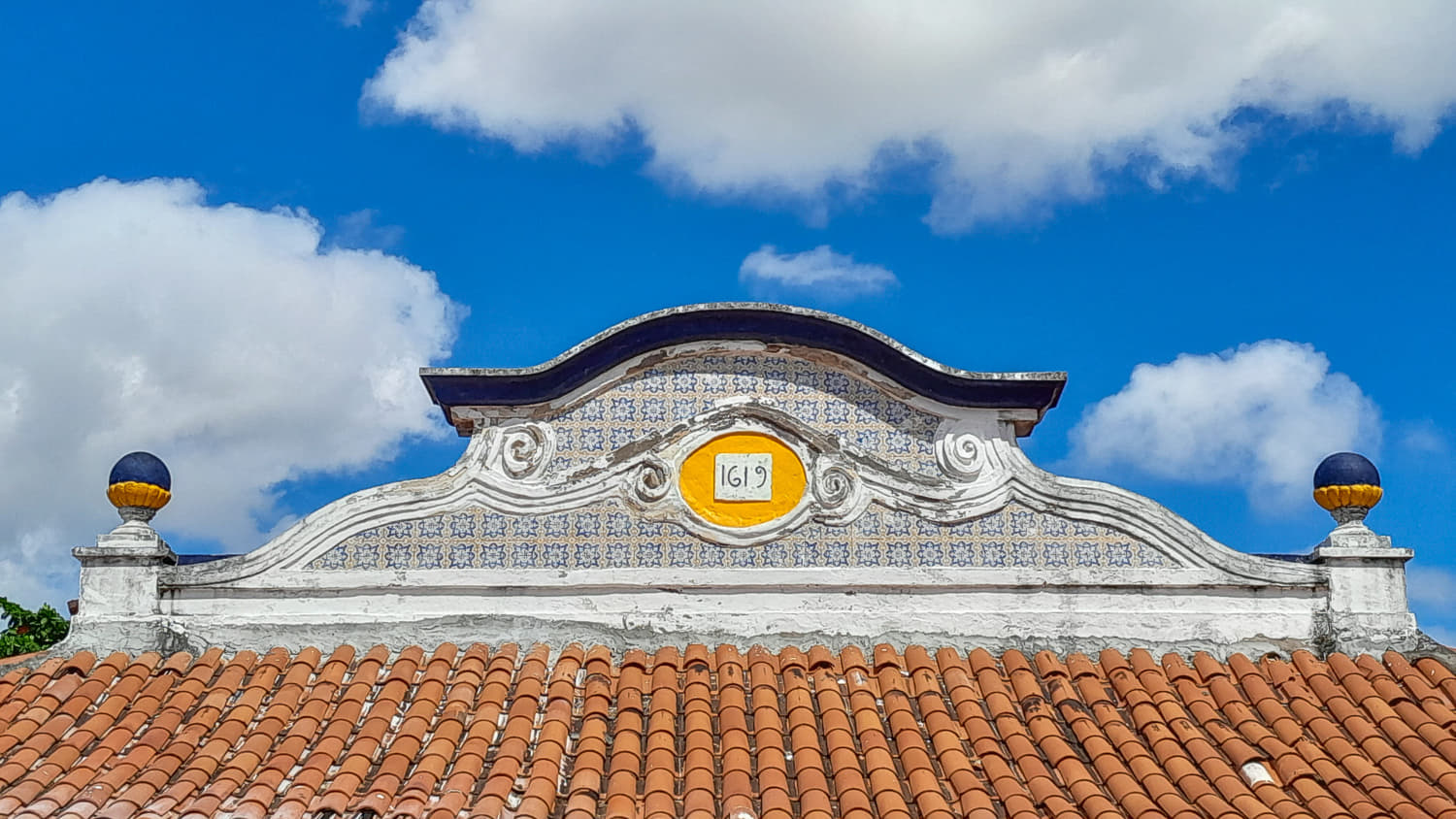
1619 - an old building in Salvador.

Salvador has many beaches, all of them are packed with people.

Farol da Barra - another magnet for tourists in Salvador.

One of the orld's earliest public elevators, still in opearation today.

A modernistic fountain in front of Brazilian Navy building.

It's strange to be on the east side of a continent and watch sun setover the ocean.
From Salvador I headed inland, towards Chapada Diamantina. I had visited it during my first S. American ride, but I felt the urge to go there again. After all, it's only a few hundred kilometers off my route.

Chapada Diamantina - National Park a few hundred kilometers west ofSalvador.
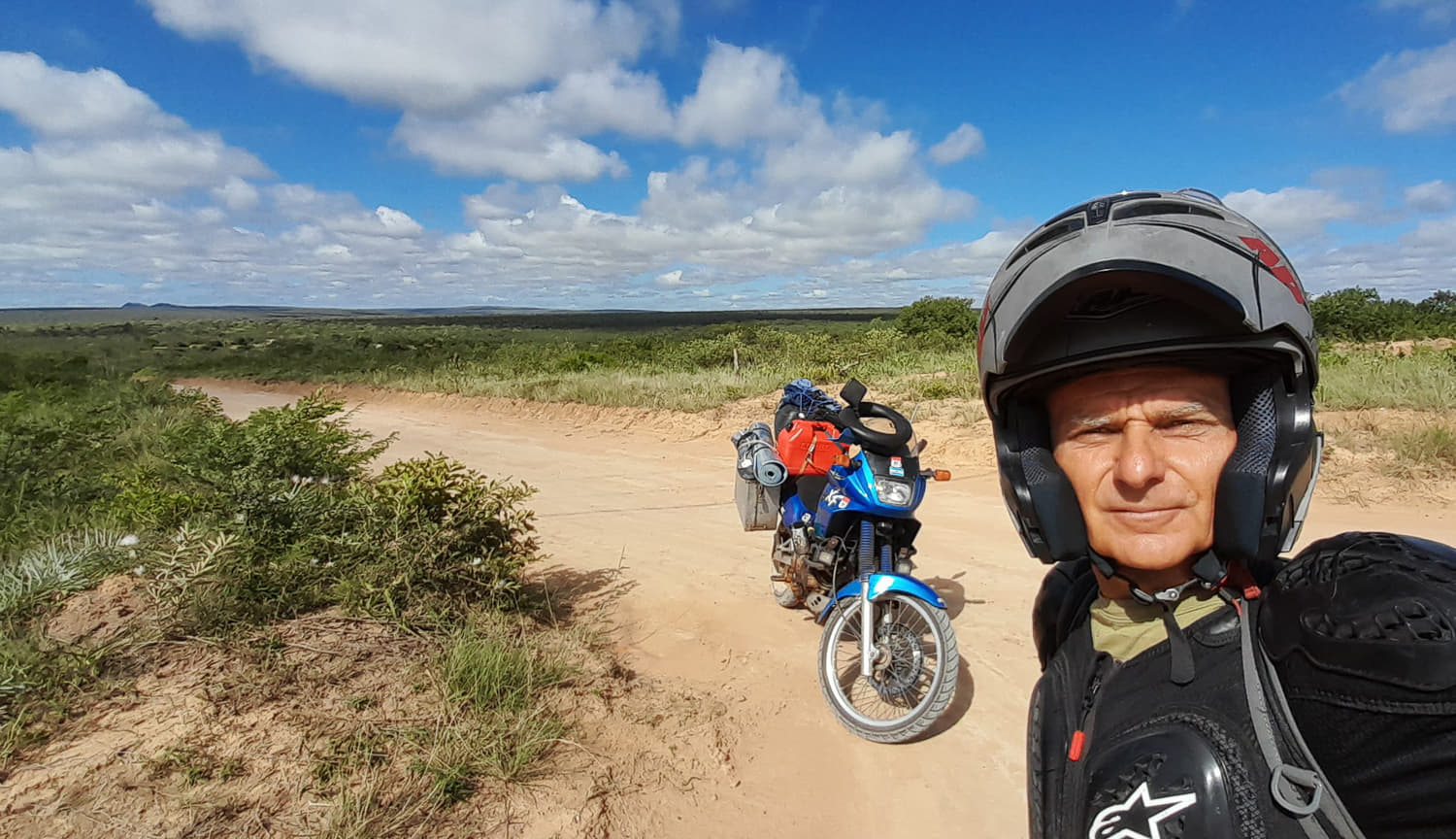
Some sites in Chapada Diamantina can be reached only by a dirt track.

Another blue water cave. Things have changed quite a bit since my first visit 14 years earlier. Back then, I had Poco Azul cave all to myself. Now, I would have to wait for 2 hours to get on a tour to go into the cave with a bunch of other people and even then, for just a few minutes. I turned back. Why spoil a good memory?
On a map of Brasil, Chapada Diamantina looks pretty close to Vitoria, the capital of province of Espirito Santo, but it took me two days to get there. Brasil is BIG!
As soon as I entered the state of Espirito Santo, the scenery got more mountainous and interesting for riding. After 12,000km of straight roads, I felt I forgot how to ride on curvy roads. First few tight curves almost got me.
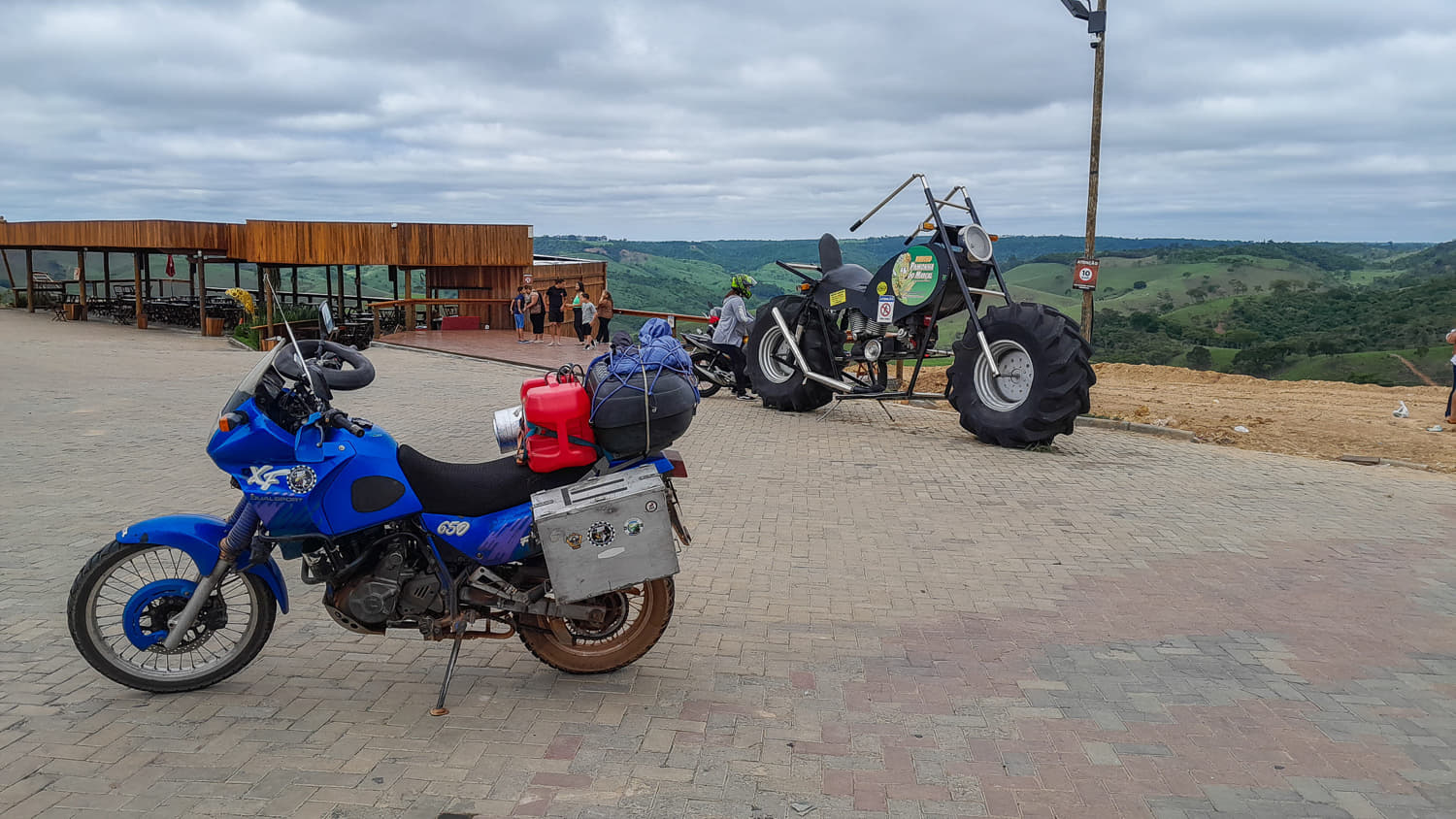
Motorcyle art between Chapada Diamantina and Vitoria.
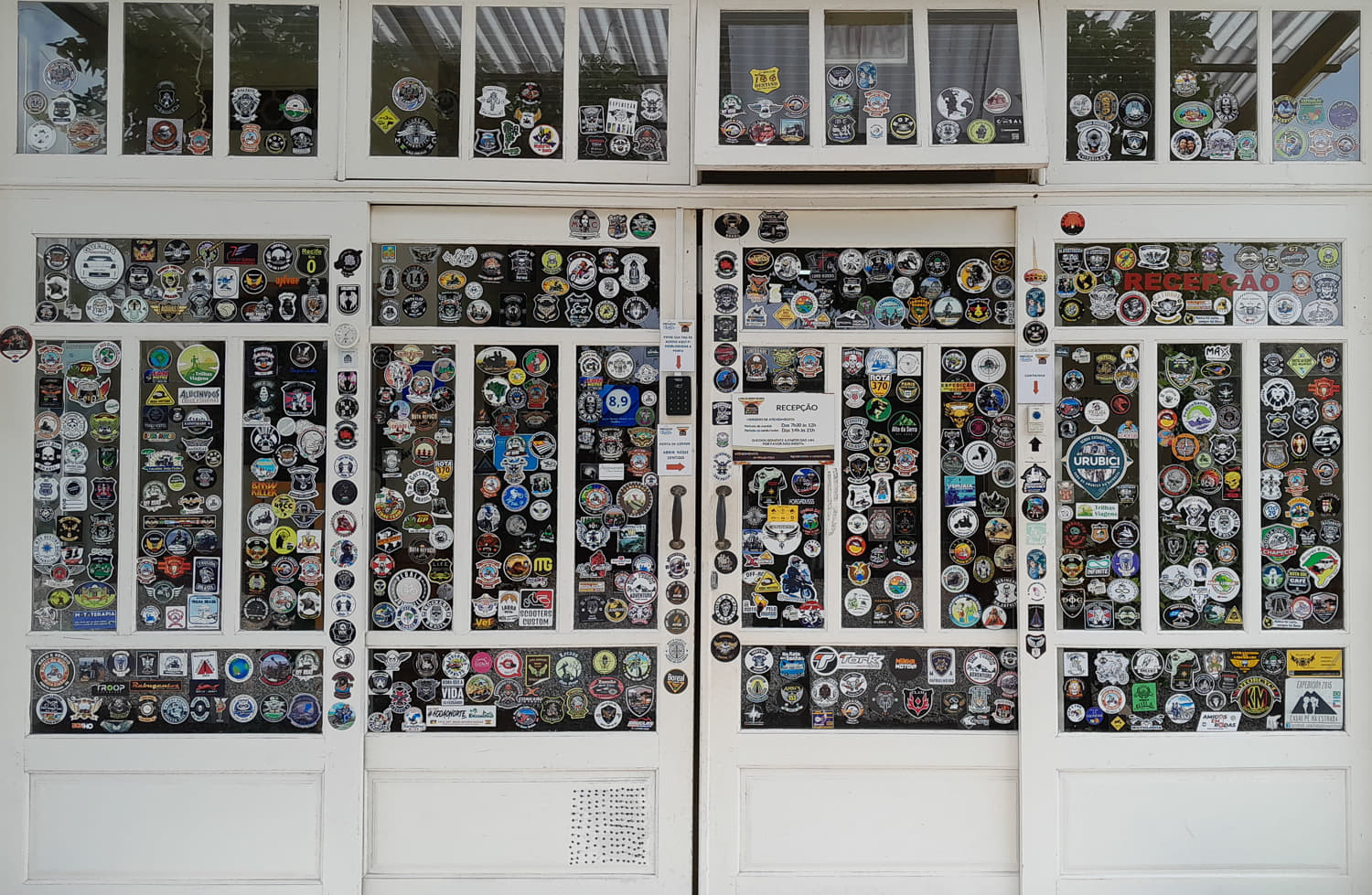
Brazilians are crazy about motorcycles and stickers! It seems that every rider has his or his club's sticker. Most of them feature some kind of skull, must be a Harley thing.

Vitoria is surrounded by giant rounded granite rock formations.

Vitoria Bay - straight out of a Disney movie with numerous islets and hills.

Fishing boats in Vitoria Bay.
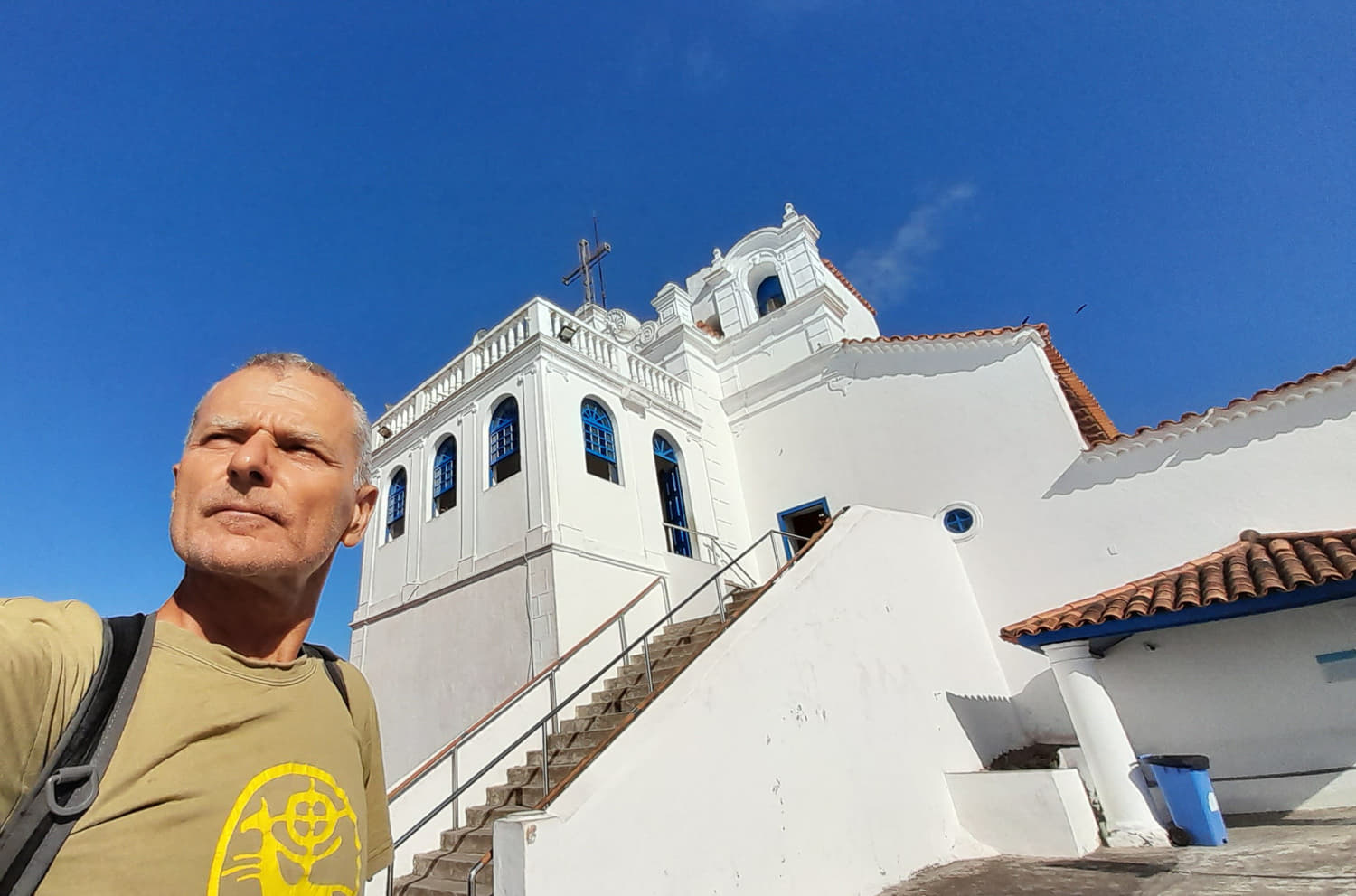
Convento de Penha, perched high above the bay of Vitoria and an important religious site.

Vila Velha - the new part of Vitoria.
Vitoria was a very pleasant city and I wish I had more time to spend there. Unfortunately, the date of my flight out of Uruguay was approaching fast and I still had several thousand kilometers of riding ahead of me. So I rode inland following smaller roads towards Pedra Azul.
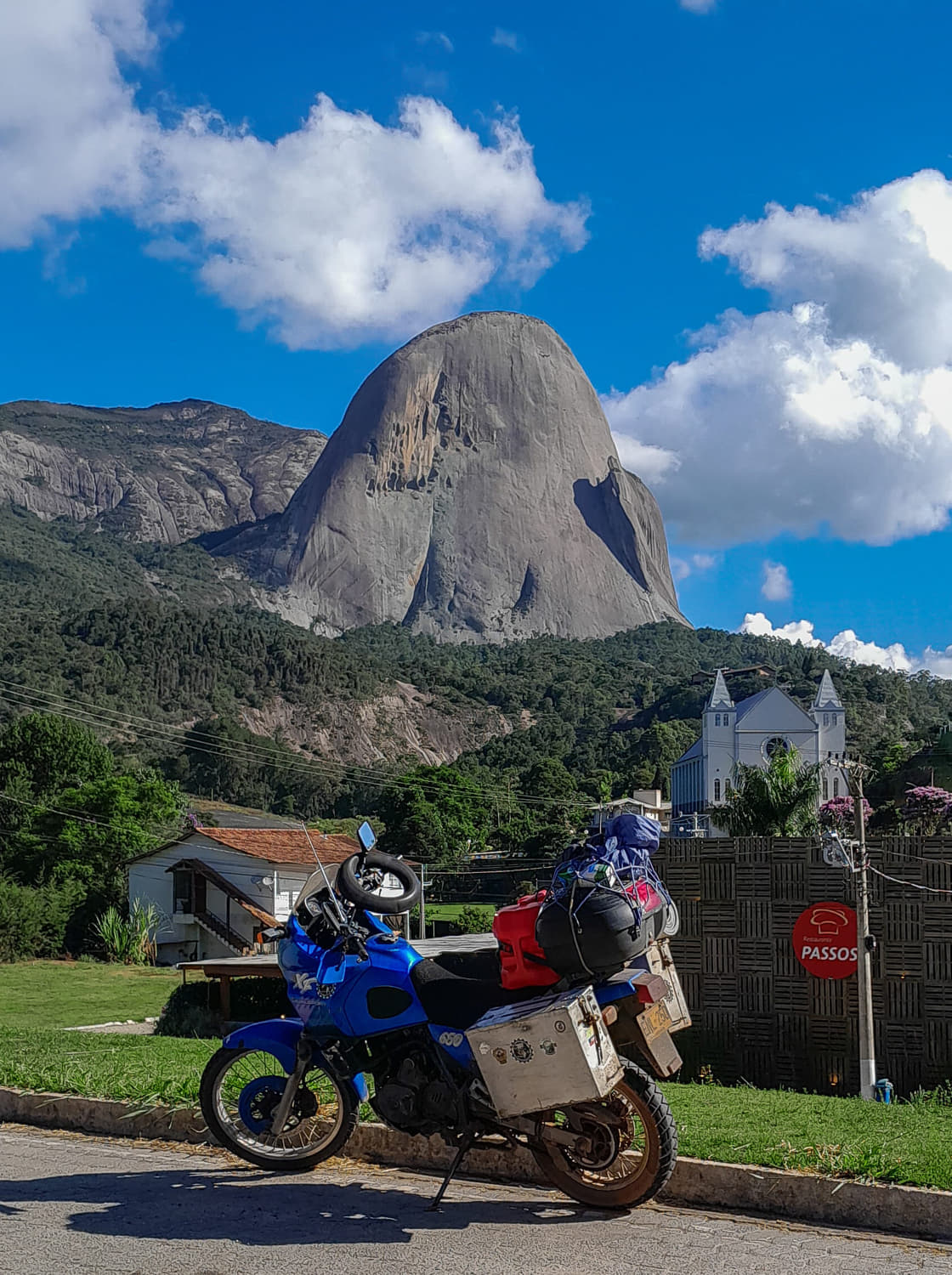
Pedra Azul - beautiful granite rock surrouded by jungle. The ride there from Vitoria was spectacular - twisty road through jungle covered mountains.
This part of Brasil is immigrant territory and, it seems, mostly of German origin. There are many small towns and villages with distinctly German look. Even though it was rather hot in Vitoria, up in the mountains, it was cool.

Next morning, I did a hike at the base of Pedra Azul.
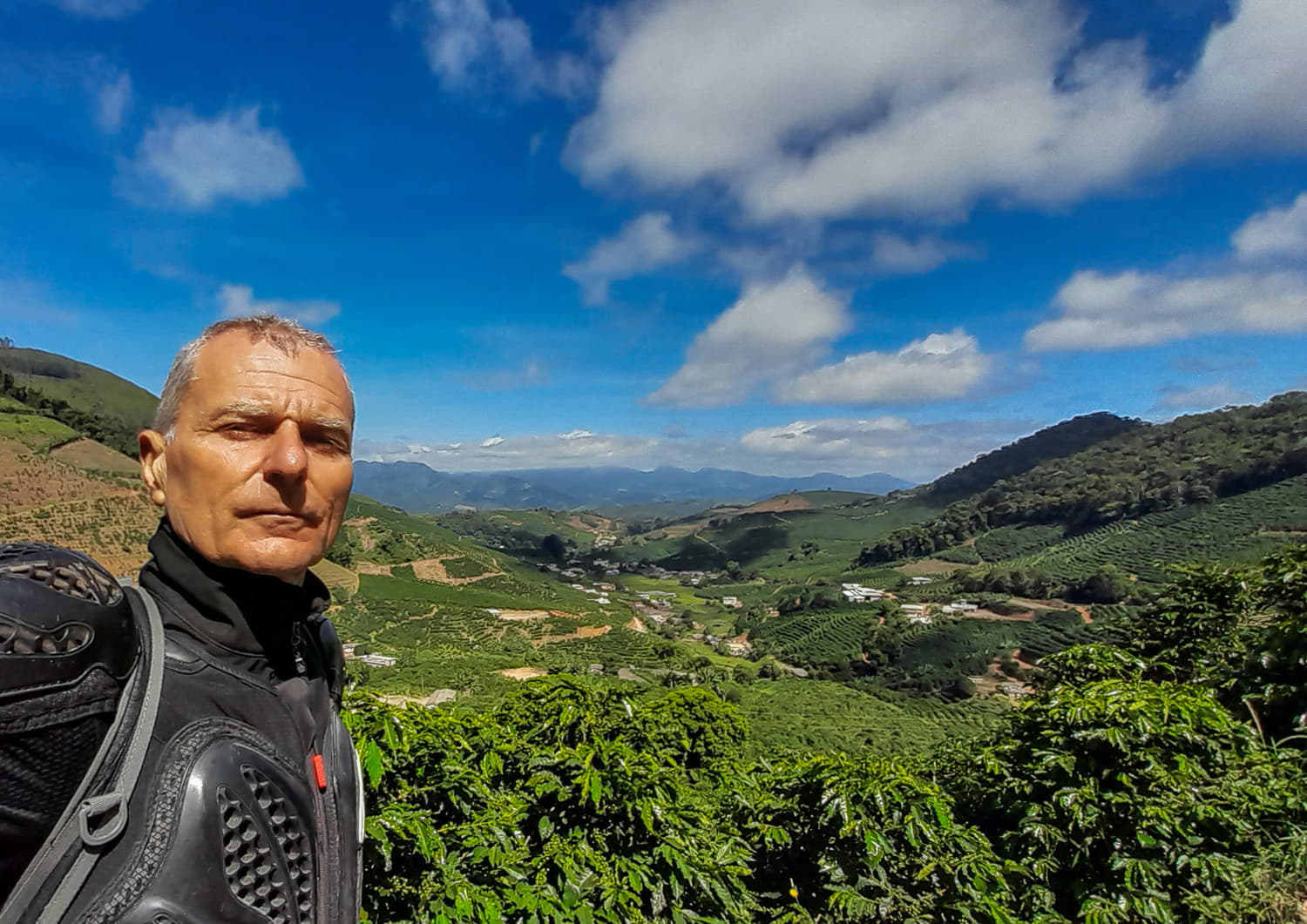
Coffee plantations are a major industry in Minas Gerais.

Verdant valley of Minas Gerais.
After a short hike around Pedra Azul, I continued my ride west and south towards Rio. I rode through some green valleys and over scenic mountains till Rio de Janeiro province. Then things got really spectacular - Teresopolis, Petropolis and Nova Friburgo.

Serra dos Órgãos National Park and God's Finger.
I spent two days visiting towns and riding twisty roads through the spectacular mountains just outside Rio de Janeiro. I felt little stupid for riding almost 15,000km through farmlands and sertao of Brasil when the best riding was around Rio and Sao Paulo.

Dedo de Deus or God's finger, prominent spire outside Teresopolis. On an early morning hike to a view point in Serra dos Órgãos.

A popular trail to the view point of Dedo de Deus.

View of the bay of Guanabara from Petropolis. Pan de Azucar is barely visible in the distance.

A side road descent from Petropolis to Rio de Janeiro. There is a four lane road to Rio, but this small mountain was far more scenic, even though I ended up going through a few dodgy neighborhoods.
Almost every single Brazilian I met warned me about Rio and advised me not to go there. Rio is well-known for violent crime world-wide. But it is one of the world's greatest cities and I coulnd't ride through Brasil without visiting Rio.
I was staying at a modest hotel 2 blocks from Copacabana beach with parking space, which is hard to find in Rio. It was a weekend and I spent a day walking up and down Copacabana and Ipanema beaches. On weekends, one half of the beach avenue is closed for traffic, so people can ride bicycles, skate and walk on the street too. Brazilians love their beaches and Cariocas take that to the extreme.

I arrived into Rio early Sunday mornig. I figured criminals were asleep after a night of hard work.
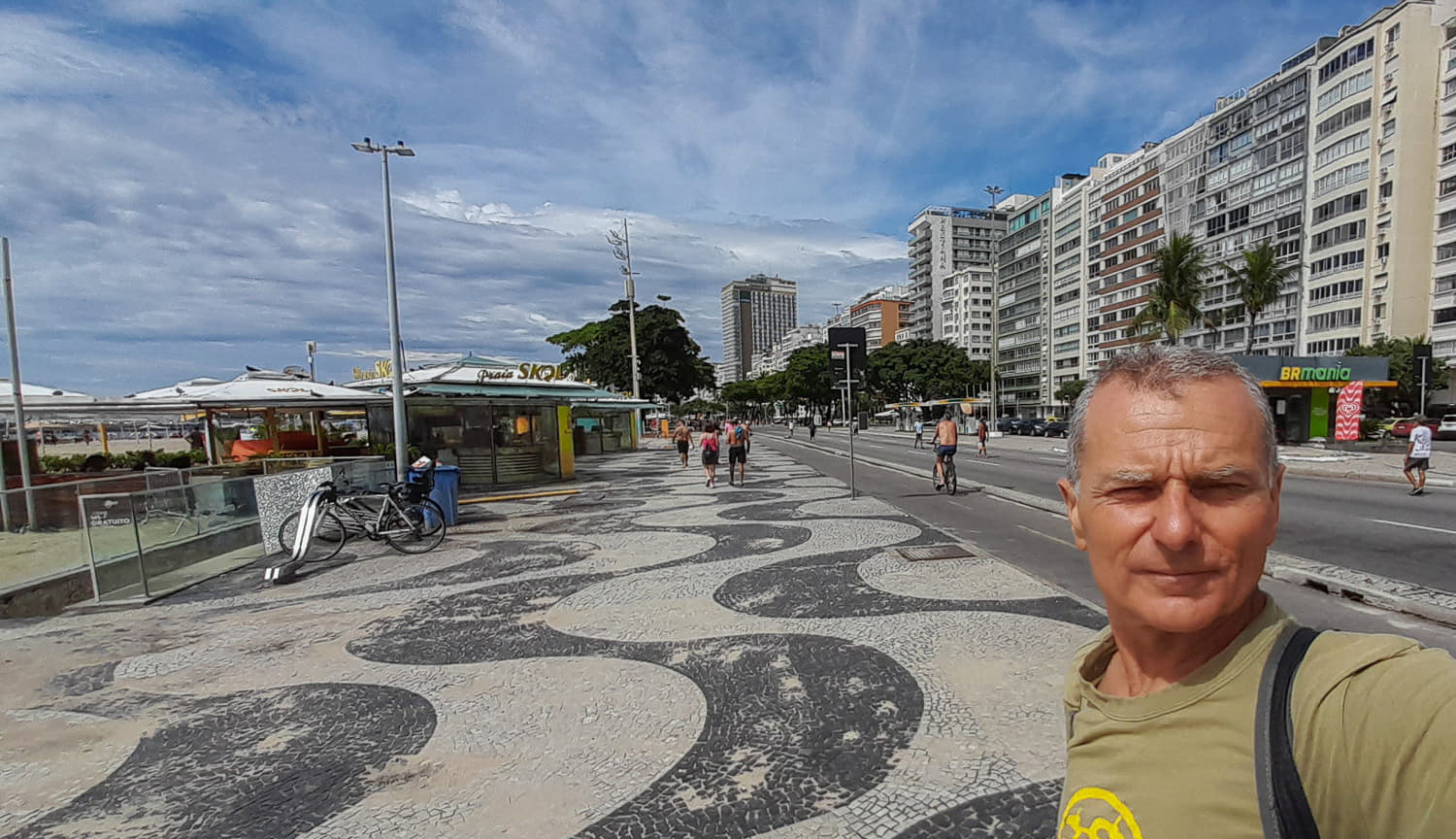
Copacabana beach mozaic pattern on the sidewalk.

I thought Ipanema beach was more scenic.

Juares is a Brasilian rider who I met at my hotel. We had a chat at night and he told me more about Brasil.
Next morning, I left Rio and headed towards BR-101 - coastal road between Rio and Santos. I remember this road from my previous ride through Brasil. That was one of the most scenic roads I had ridden anywhere. Unfortunately, this time, the weather was bad, from cloudy to rainy.

The scenery along BR-101 was spectacular - lush jungle on one side and ocean on the other. Unfortunately, in rainy weather ocean is not pretty.

Crossing the tropic of Capricorn one more time.
Sao Paulo is one of the world's largest cities. Metropolitan area has 30 million inhabitants. I was advised not to ride there, but I needed some spare parts that I could not find anywhere else in Brasil. So, on a rainy morning, I went in. The traffic was horrendous, but on a bike, I managed to zig-zag my way to the city center where all the motorcycle stores are located.

The weather was still bad and I didn't get to see much of Sao Paulo downtown. I only spent one afternoon walking around the center.
A friend of a friend who lives near Sao Paulo invited me to visit him. I spent two days exchanging stories about riding and traveling in Brasil and South America. His uncle, an avid traveler himself, spent a day taking me around.

Visiting friends near Sao Paulo.
My bad luck with the weather continued as I rode south towards Curitiba along Rastro da Serpente. This road together with Serra do Rio do Rastro and Estrada da Graciosa are among the most famous motorcycling roads in Brasil.

Estrada da Graciosa descends high plateau from near Curitiba down to the port of Paranagua. This is one of the most scenic roads to ride. Only after I got half way down the descent did I realize that I had ridden this road 14 years earlier.
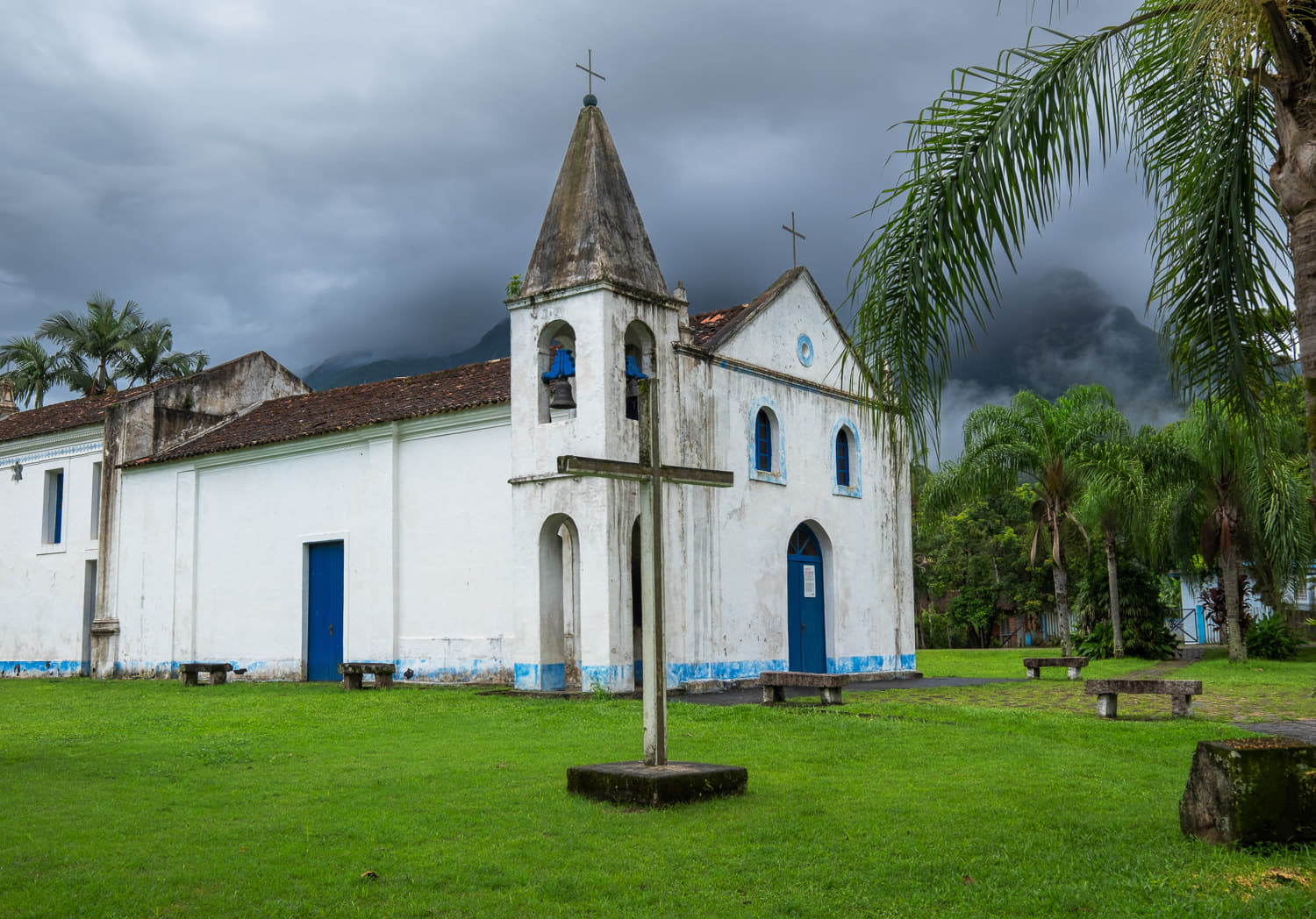
Once I descended down to the coastal plain, rain stopped. An old church near Paranagua.
After a night in the German city of Blumenau (they have a beer fest there), I continued riding through picturesque mountains of St Catarina state.

One of the highways crossing mountains on the way towards Florianopolis.
Urubici town is nested in a valley surrounded by mountain peaks and is a adventure central for motorcycle riders. Just outside the town is Ruta 370 steeply descending down a canyon towards Florianopolis. To the south, Ruta 390, the most famous and scenic, climbs up to a spectacular view point before descending down a series of switchbacks towards the ocean.
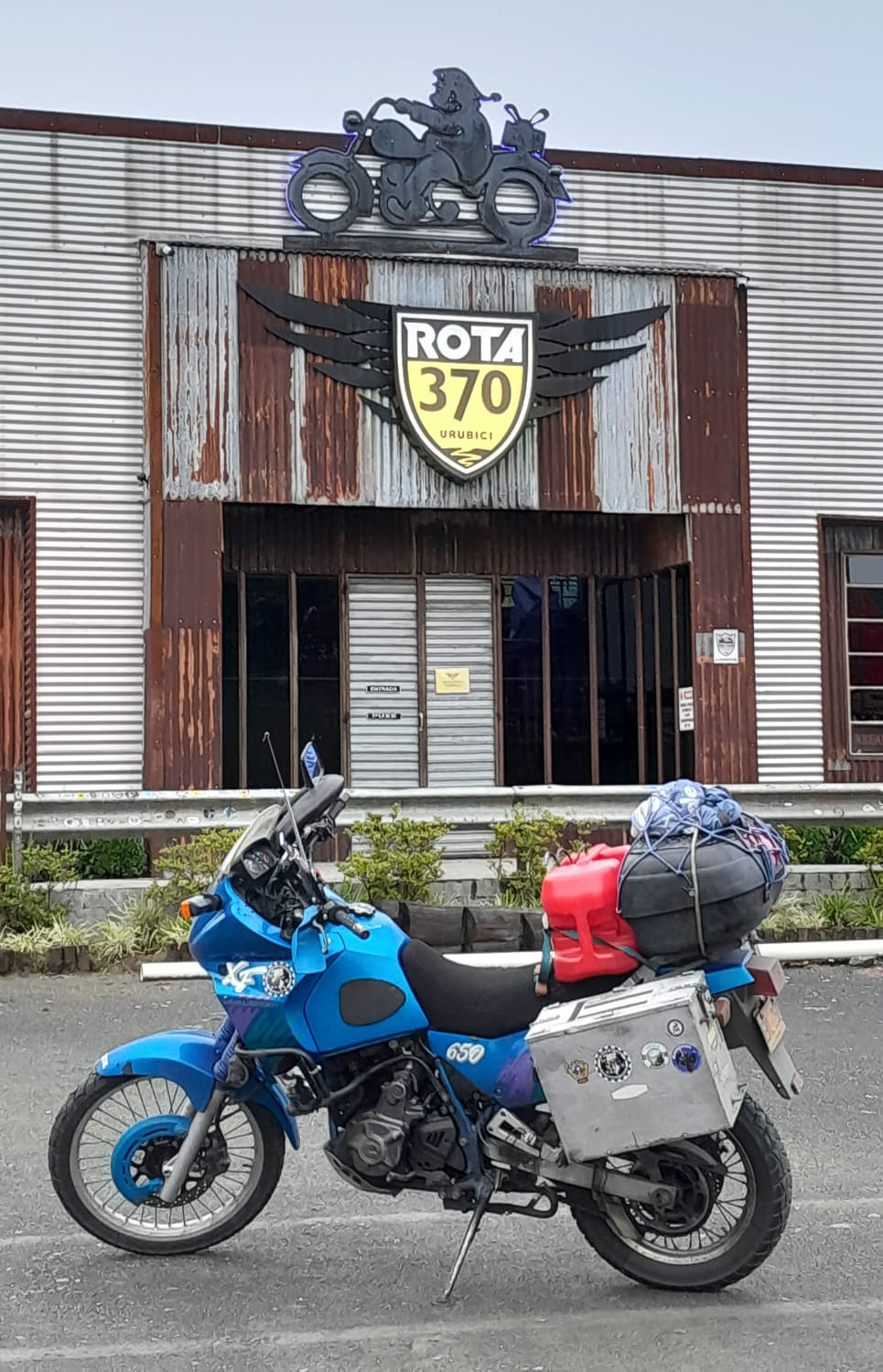
Bar/museum off road 370 just before steep switchbacks.
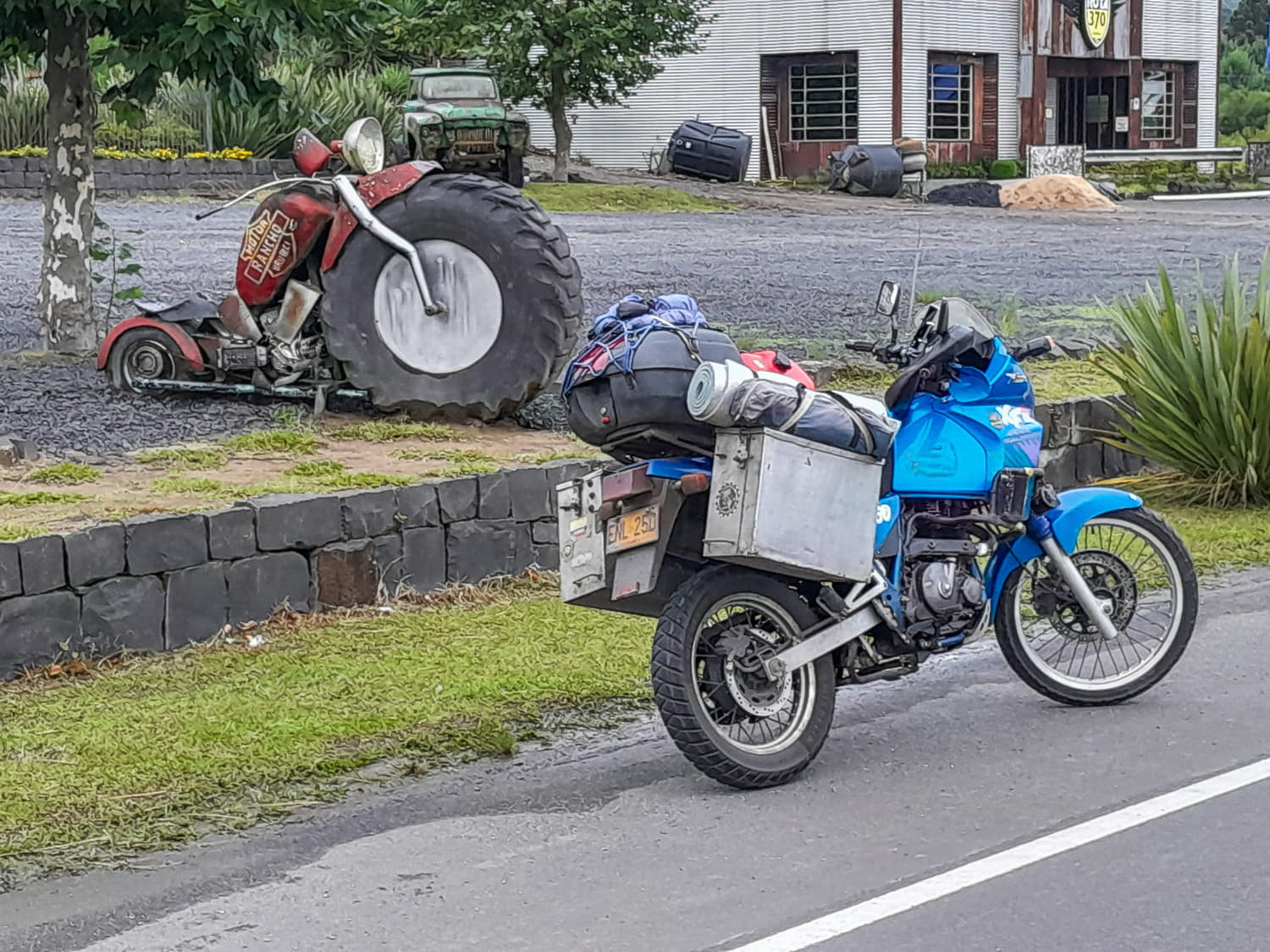
Motorcycle art on road 370.

Descent down road 370.
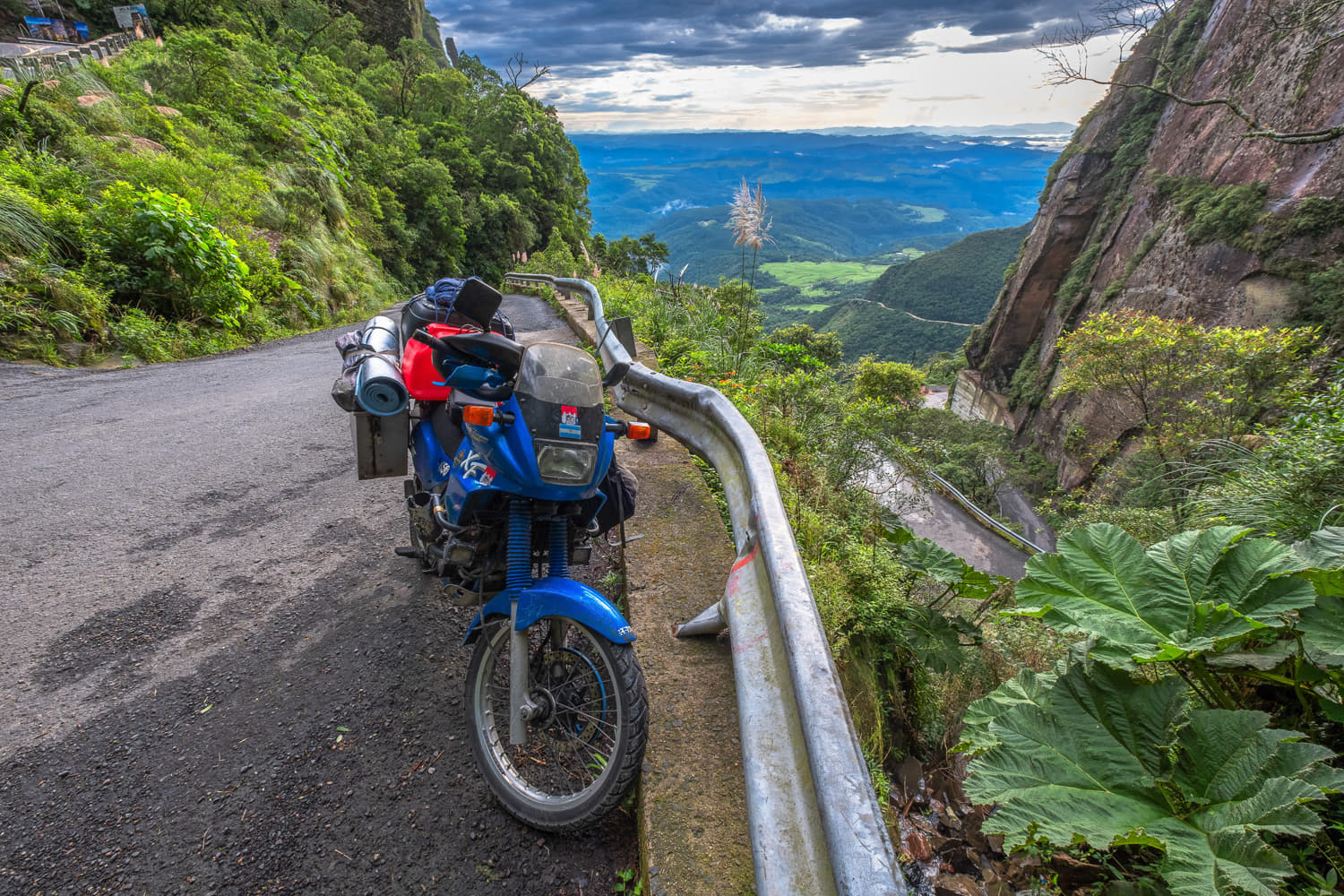
Tight switchbacks on road 370.

Looking back, switchbacks on road 370.
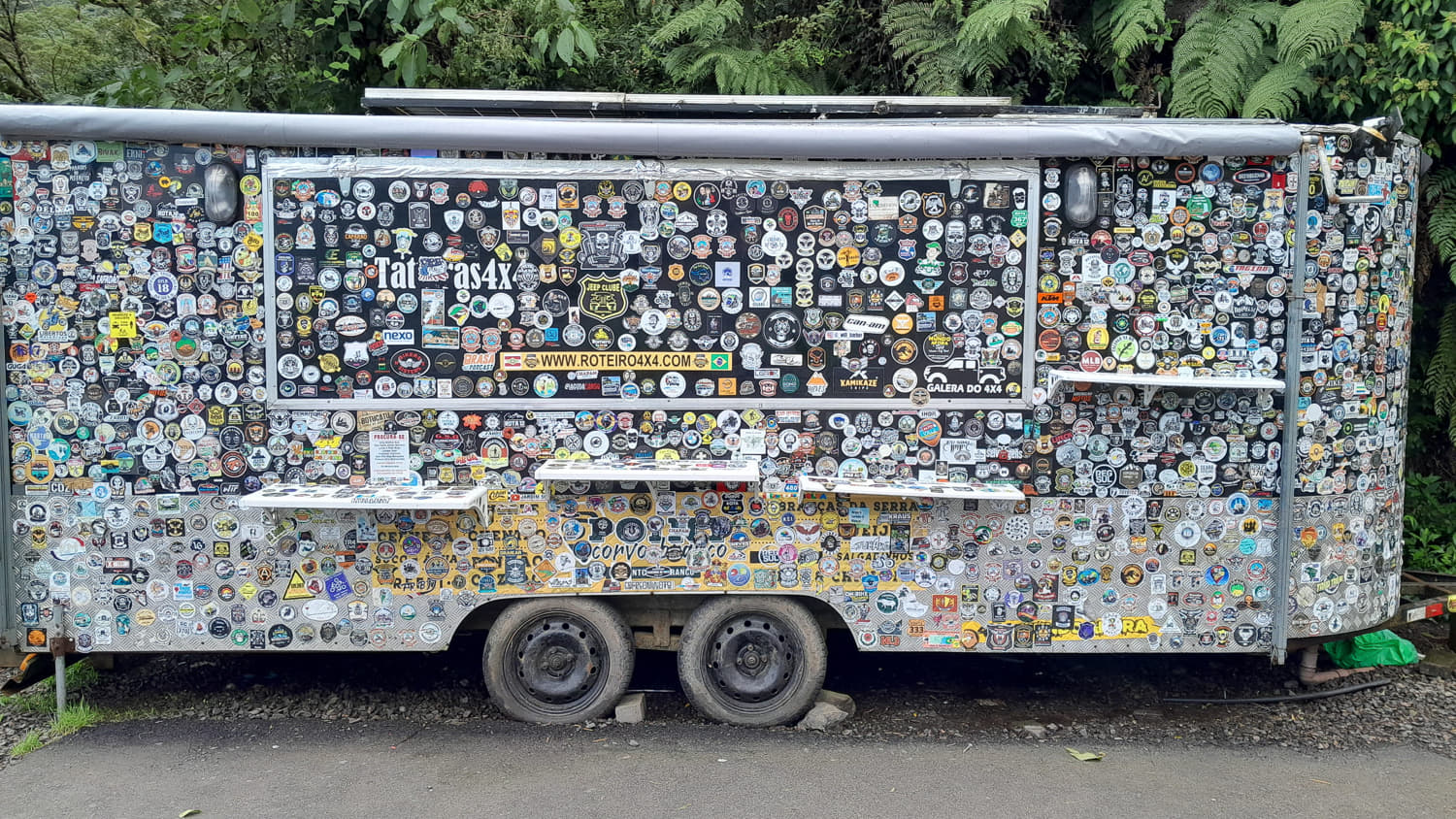
Food trailed atop the pass on road 370. I need to make my own sticker next time I ride in Brasil.

Road 390, Rio do Rastro, Brasil's most famous motorcycling road. There is a beautiful viewpoint atop. Unfortunately, it was engulfed by clouds when I was there. Only half way down could I see below clouds.

As I descended steep switchbacks, I dropped below clouds and I could actually see the beautiful scenery around me. I hope I get a chance to ride this road in sunny weather.

At the bottom, the weather was sunny and hot. More motorcycle art.
Rio Grande do Sul is full of German immigrant towns, so it's a little wonder there is a Romantic route , Brazil's answer to German's Romantische Strasse, another popular riding route.
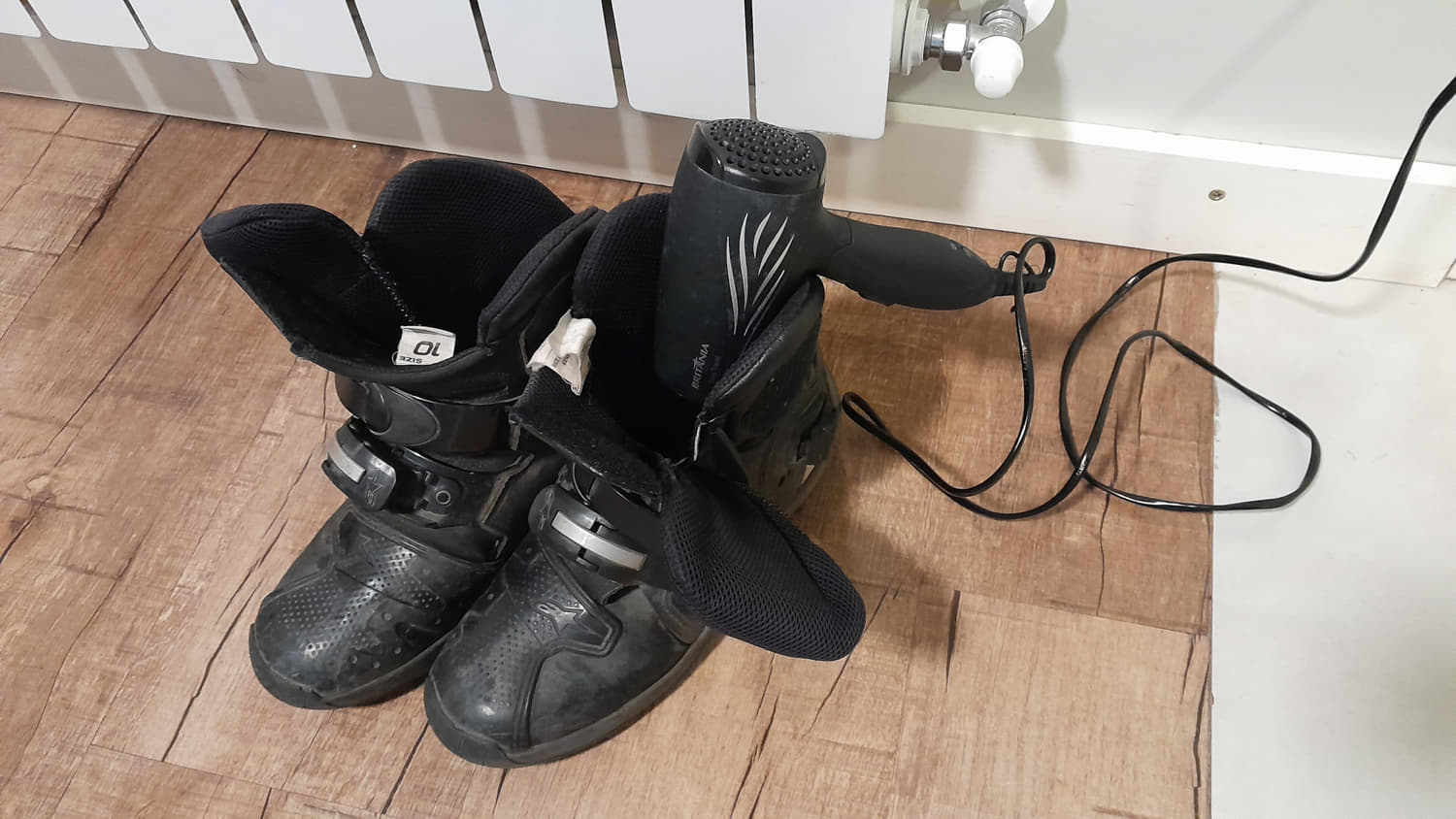
After more rains on the romantic route, hair drier came in handy.

Art in front of one of the wine shops on the romantic route near Gramado.

Gramado downtown.
After a short visit to friends in Porto Alegre, I rushed towards Cassino beach, world's longest beach. One can ride the full length of the beach, over 200km of solitude. Near the northern end, beach is crowded and people venture south some 20-30km. After that, there is hardly a soul.
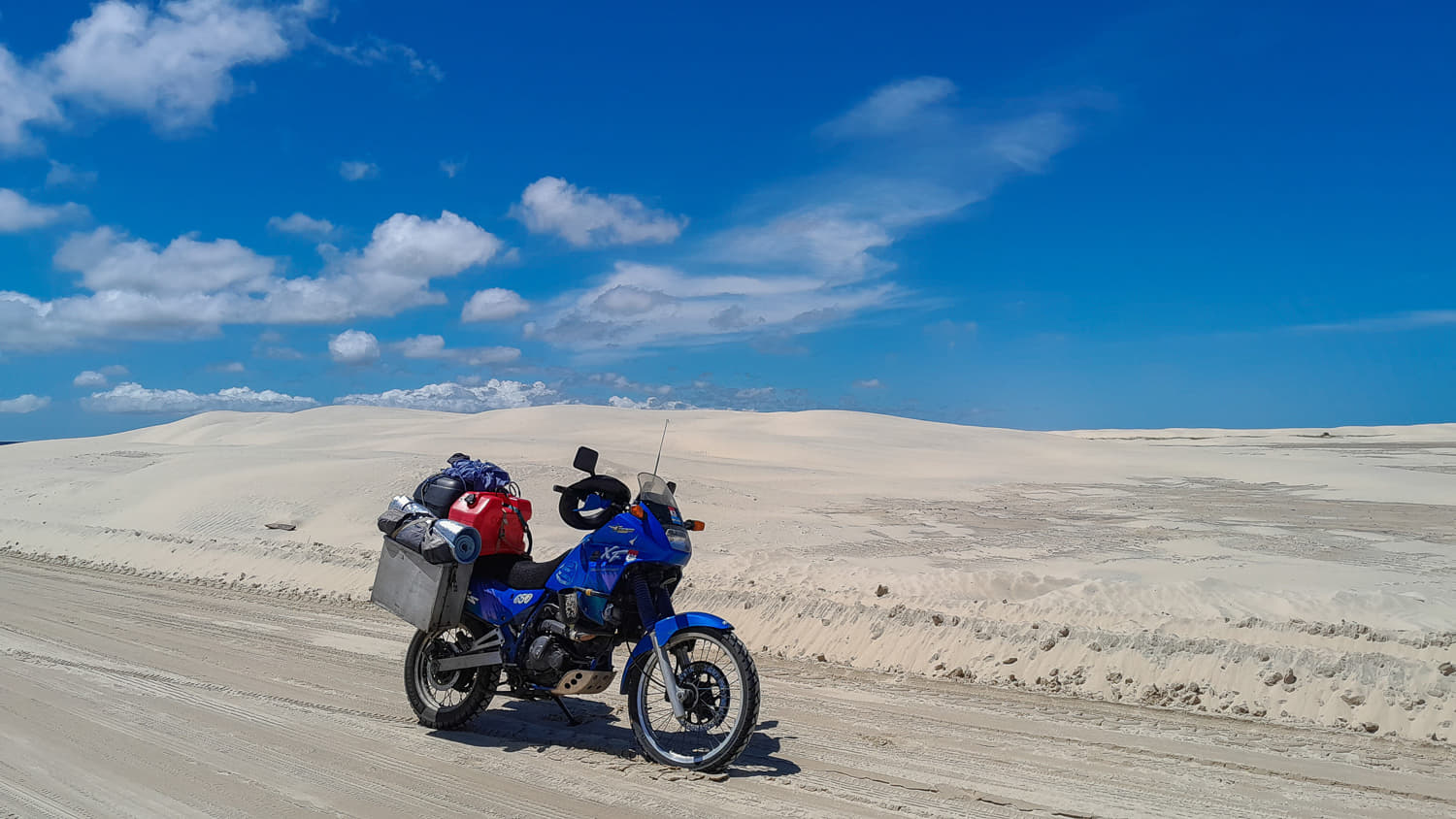
South of Porto Alegre, there are few hundred miles of empty beaches.

Ferry across the bay at Rio Grande.
I was little nervous about sand conditions, tides and if I would be able to make it all the way through. I brought a can of extra fuel as I knew that my fuel consumption would be significantly higher in deep sand.
I had planned to start riding in the afternoon because high tide was lowest at midnight. I wanted to camp in the middle of the ride and hopefully, get out before tide reached high point at noon the following day. Unfortunately, I got to the beach a bit late and started riding only 2 hours before sunset.
About 20 km into the ride, a truck driver stopped to ask me if I needed help. I asked about the conditions further south and he told me that he had driven the full length of the beach the week before and that he had to use 4x4. He explained me that riding/driving conditions vary greatly depending on the wind direction (wind can bring or blow away deep sand). It made me even more nervous, but I hoped to be able to avoid section with deep sand.
I rode even after sunset and stopped just before it got dark. I wanted to find a spot and set up the camp before it got pitch black. Camping with nobody around for miles and miles was the highlight of the ride. Besides crushing surf there was no other noise.

My camp for the night - no people, no lights, just sound of the surf.
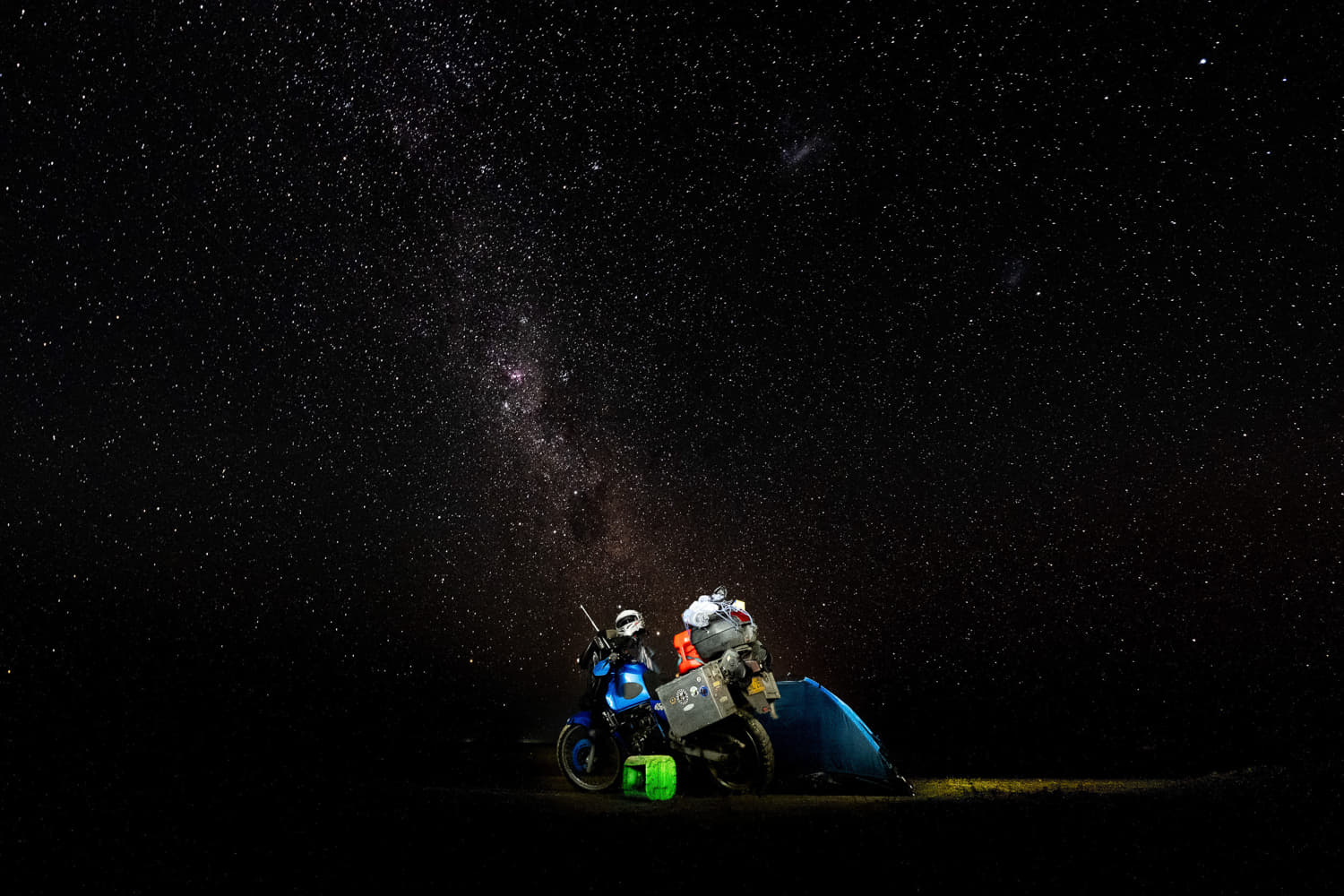
I woke up in the middle of night to listen to the waves and enjoy starry night.

I was already riding when the sun popped up over the horizon.
I got up early and started riding before sunrise to beat the tide. But the going was slow despite me trying to ride as fast as I could or hardly stopping. To make things worse, sand got deeper and I had to resort to riding on sloping sand 1-2 feet from the advancing surf line. Further away from the water edge, the sand was too deep. I tried to find a better line two times and almost got stuck. The last 40 km were quite challenging and I kept on questioning the idea of continuing.
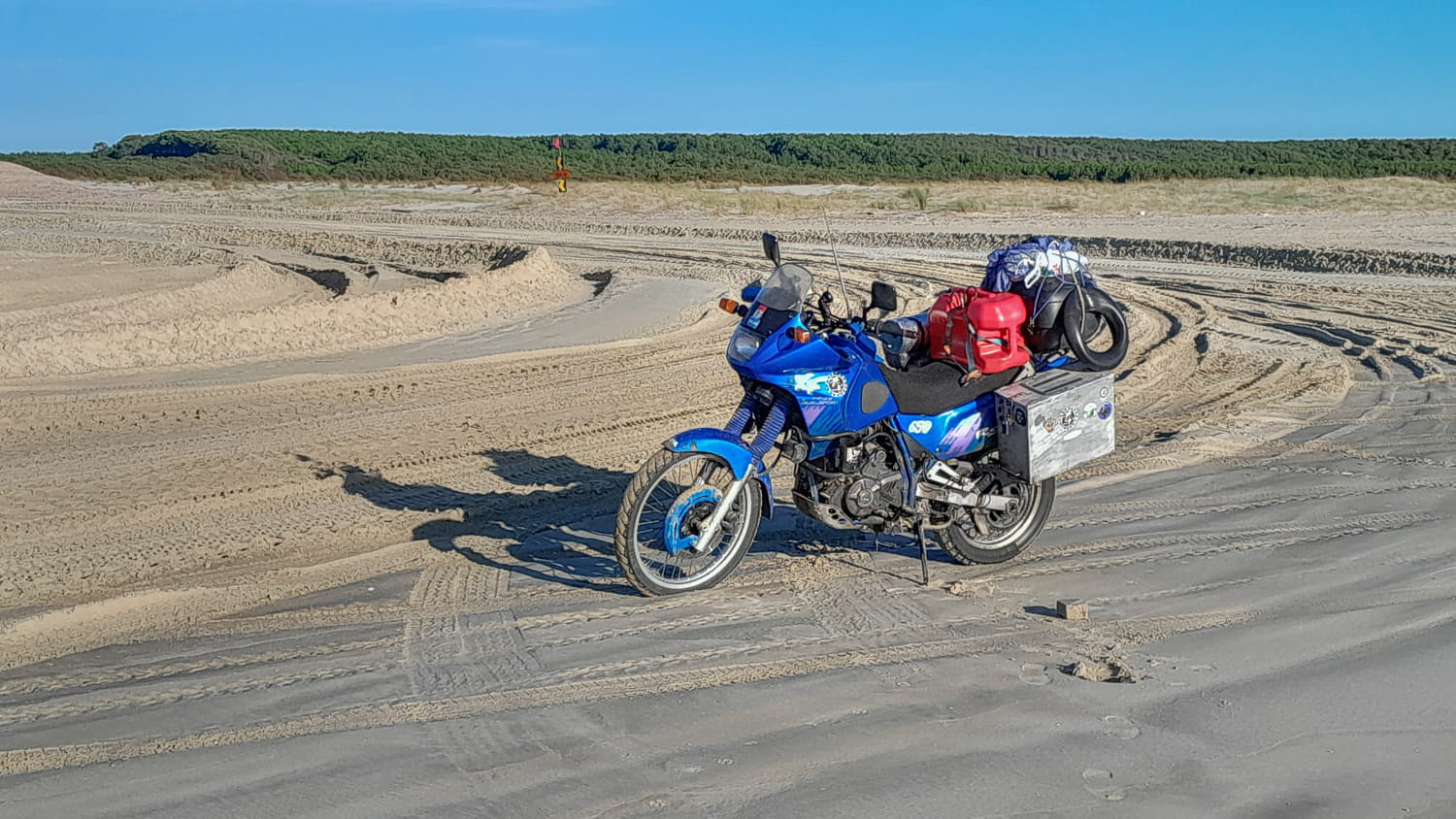
The last "escape" route to the main road. The sand looked deeper than along the water edge.
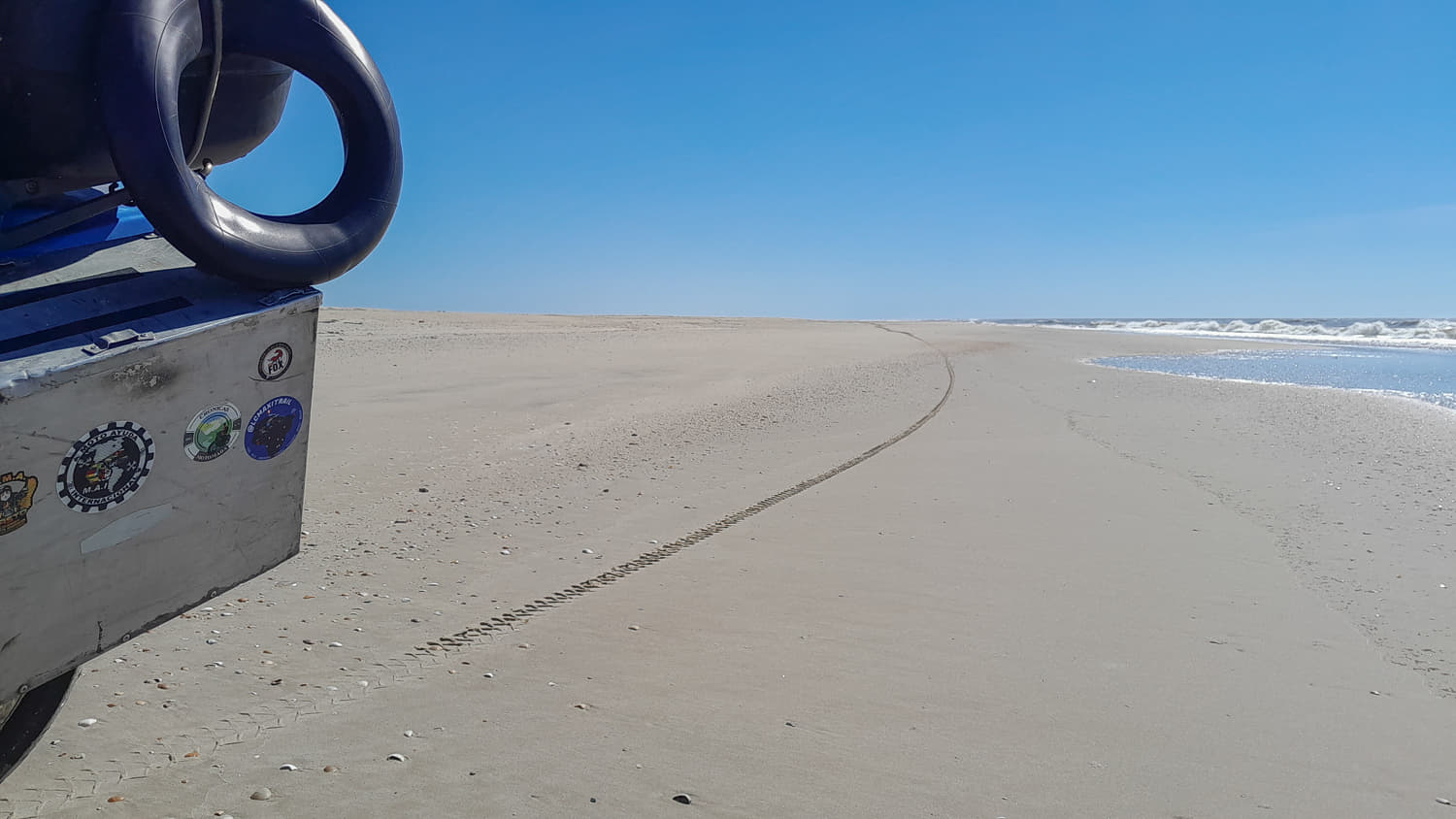
Endless, empty beach.
Finally, I got to the paved road just before 10 am, two hours before the hight tide. I was quite exhausted, mentally and physically, but content that I finished the ride. It was the most challenging ride of the whole trip with all elements of an adventure ride - remoteness, solitude, uncertainty about being able to get through and technical difficulty. It was also one of the four most memorable rides I have ever done.

After I got out, I rushed to a car wash to clean the sand off the bike.
Video of the Cassino Beach ride.
Uruguay was the most expensive country of the trip. Chile was pricey in places as I had expected, but Uruguay's prices were a surprise. However, from what little I saw and learned about the country, I really liked it. Montevideo is a big, vibrant city. But what I liked the most were numerous quaint towns that I passed through - clean, orderly, with neat central plazas and freshly painted houses.

People in Montevideo relaxing by the ocean on a hot summer evening.

The end of a 32,000km long journey around S. America. The bike, with over 200,000km on the clock, is waiting for the owner to continue riding it.

With the friend who is going to take care of the bike in Uruguay.
After storing the bike, I flew to Santiago de Chile before returning to Colombia. Ticket from Montevideo to Colombia is about the same price as two tickets with a stopover in Santiago, so I decided to spend some time exploring Santiago.
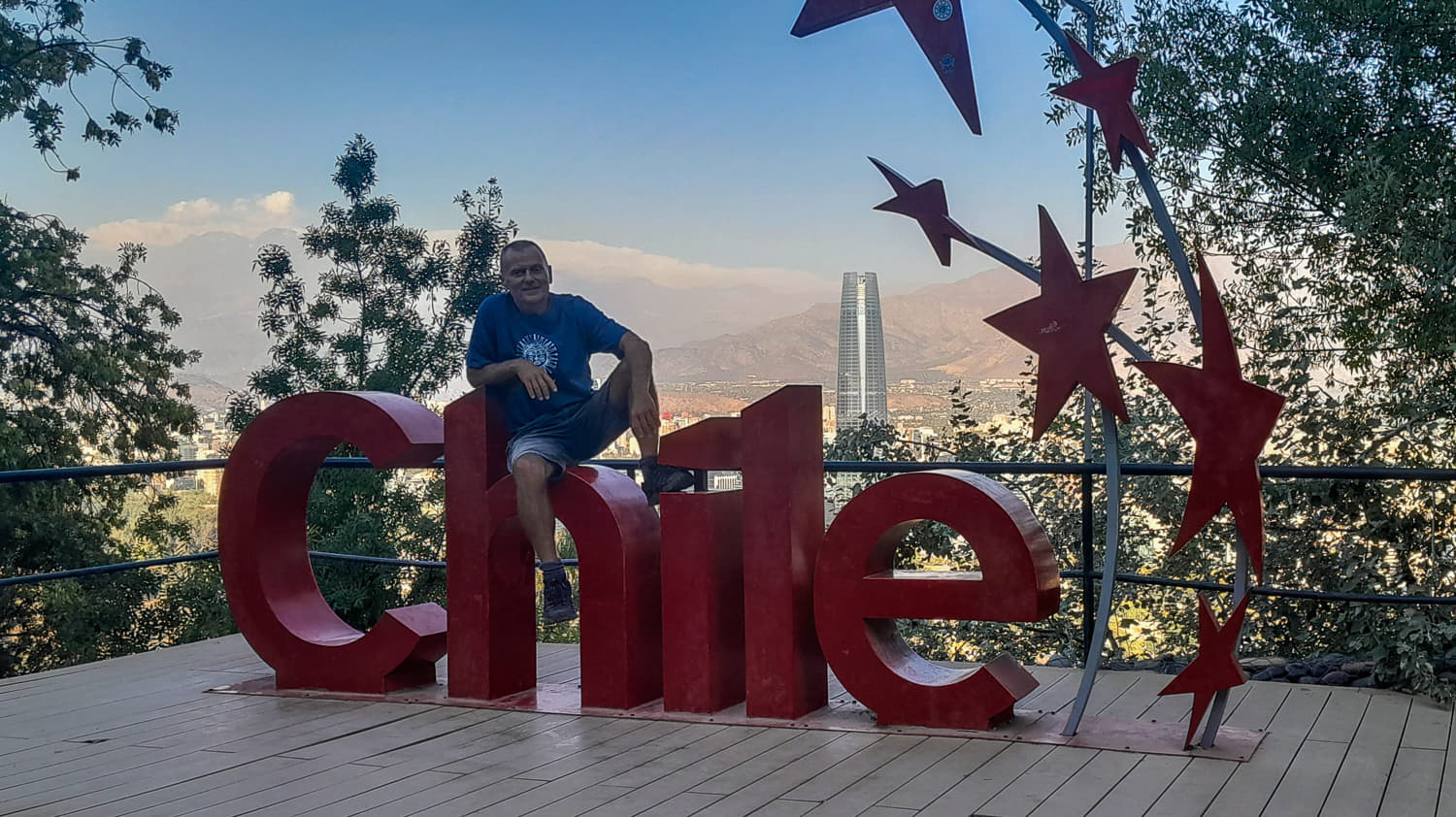
Atop San Cristobal hill, a popular hiking place not far from the center of Santiago.
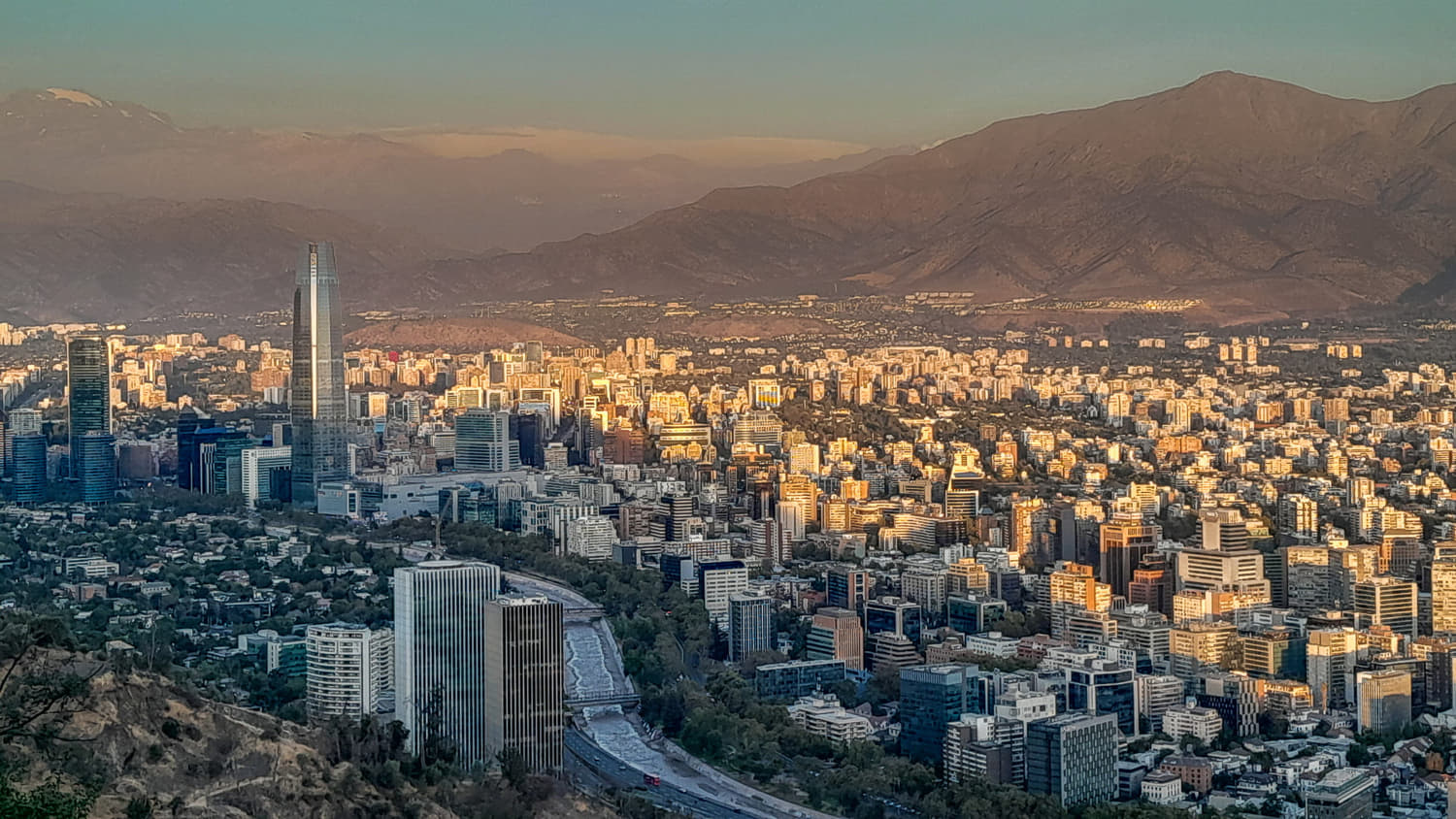
Sunset view from San Cristobal hill. S. America's tallest building - Costanera is in the distance.

Enjoying beautiful view from the top of S America's tallest building.
My friend told me how Chile has changed over the last 8-10 years. She says crime rate has skyrocketed, because of Colombian and Venezuelan immigrants. She herself, is a Colombian immigrant, so I believe her. She took me to Valparaiso for a day of sightseeing.

Valparaiso is famous for steep hills and funiculars.
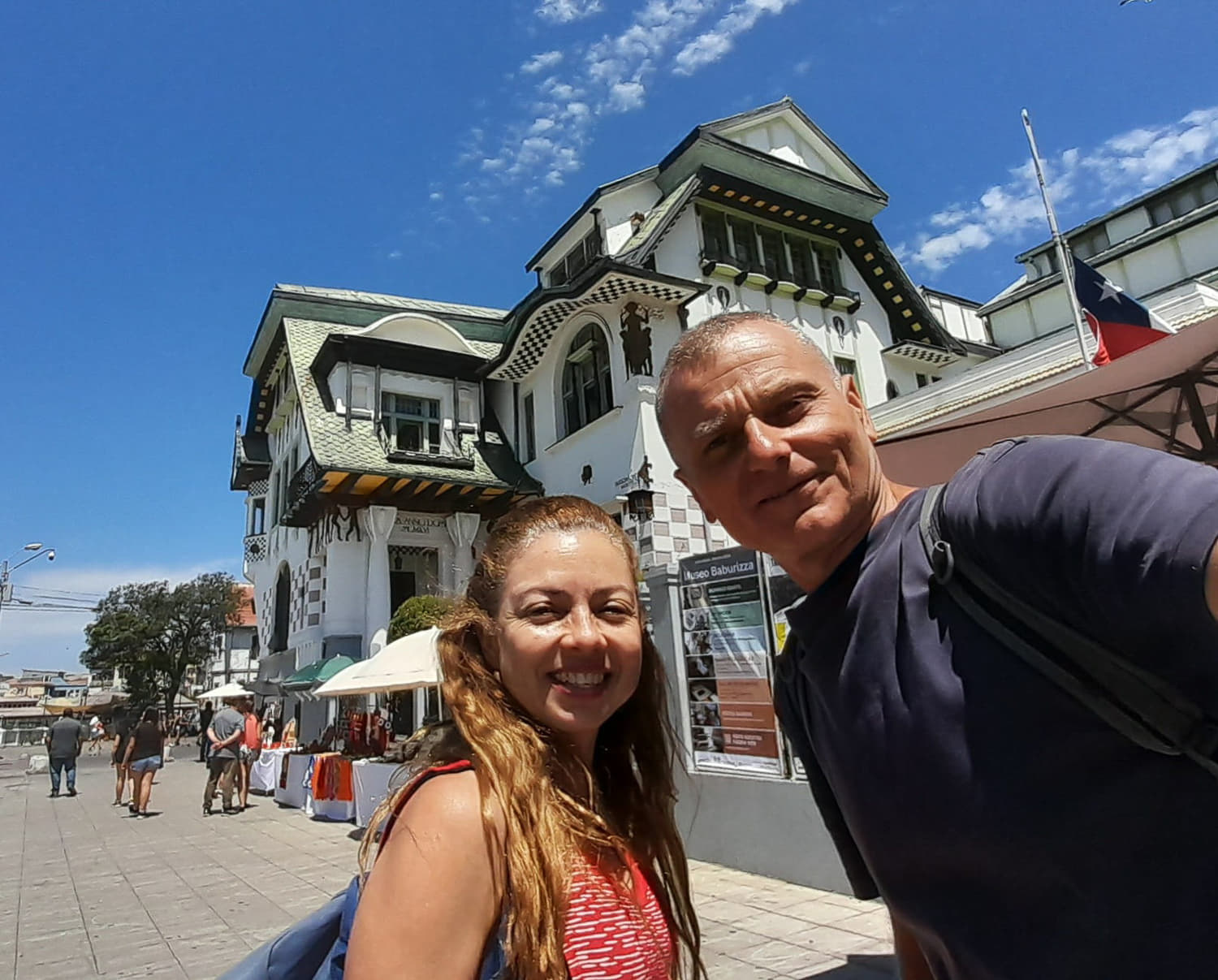
There are many beautifully preserved colonial buildings in Valparaiso.

Famous colorful steps in Valparaiso.

One of many cafes with beautiful city views.

Piano steps.

In a Valparaiso cafe.
After two weeks of hiking, city life and wine tasting in Santiago, it was time to head back to Colombia for more good food, tropical juices and good time with friends.
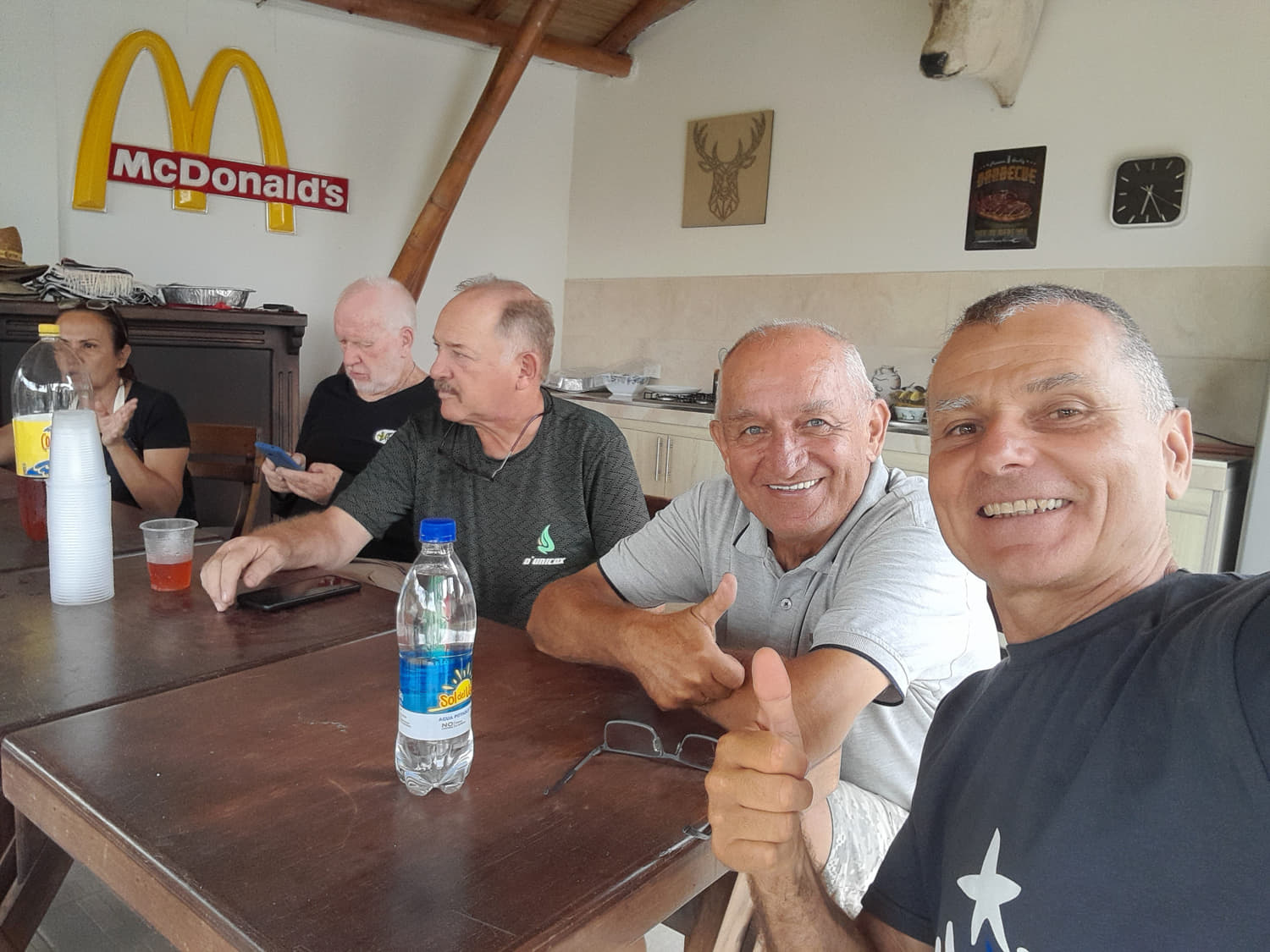
With friends back in Colombia. Next to me is the guy who I have to thank that this trip hapened - the owner of the mighty DR650 with 200,000+ kilometers on the clock. Thanks Wolf!

Hard life with my adopted family in Colombia - perfect weather, abundant fruits and great company.
I had waited for 14 years to ride around S. America again and this trip was exactly what I needed. I got to visit new places, meet new friends, try new foods and learn many new things about countries I visited.
Riding or traveling around S. America hardly qualifies as an adventure these days. There are so many travelers in even the most remote areas of the continent. But it's still a highly rewarding travel destination.
While I can easily find foods that I love in every country I visit, in terms of food, Brasil was my favorite, hands down. I loved the variety of cooked dishes and abundance of vegetables and salads. In addition, all-you-can-eat and per plate buffets were exceptionally good value. I could stuff myself with delicious food for $3-5. Desserts too, were second to none. In N. Brasil there were many tropical fruits for juices, but Colombia is still the tropical juice capital of the world in my book.
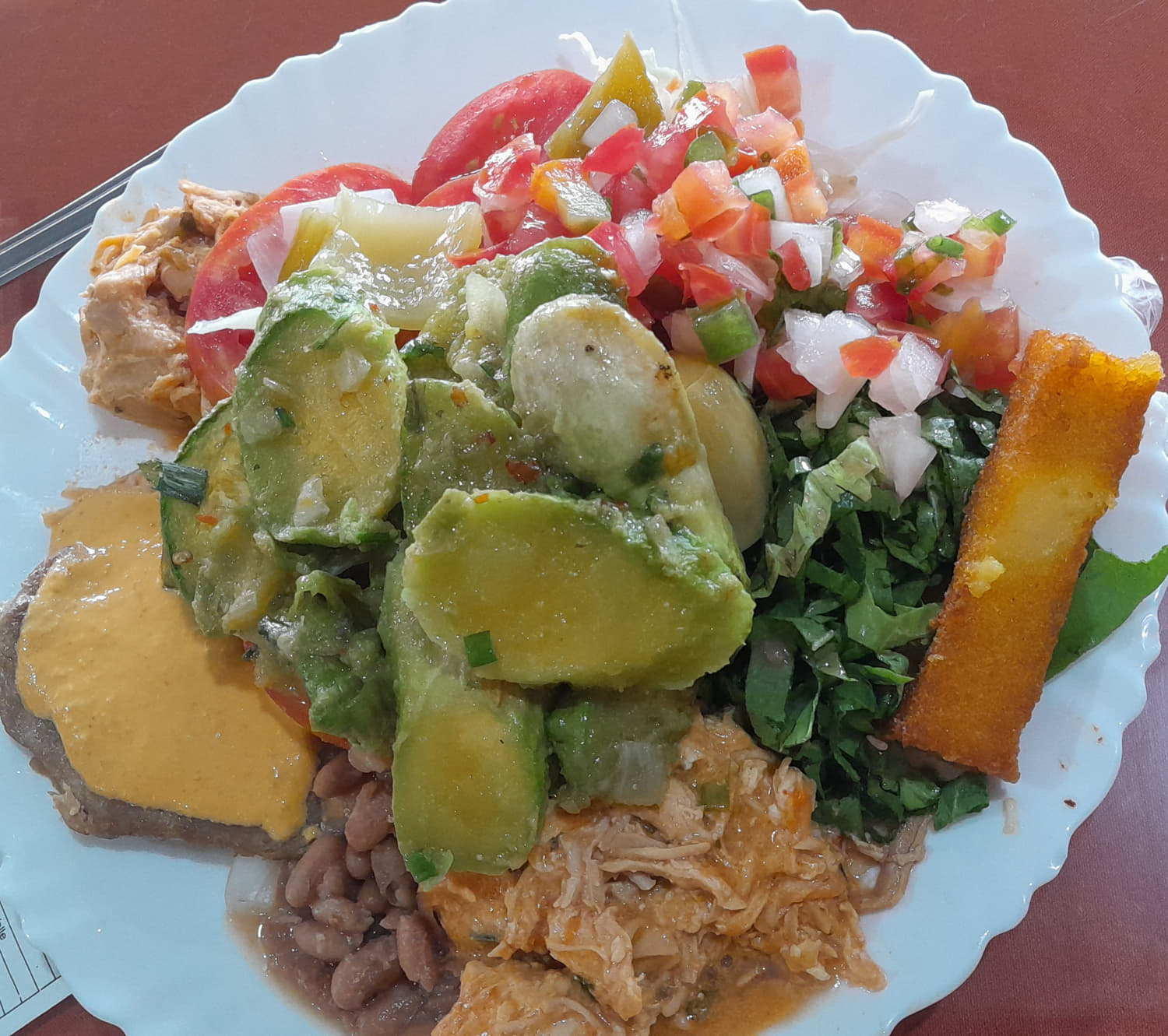
Brasilians are crazy about buffets and they are often times a great value. Buffets where they sell food by kilogram are bad deals, but sold by plate are unbeatable deals. Considering the quality, quantity and variety of foods, I'd say Brasil was the cheapest country to eat.

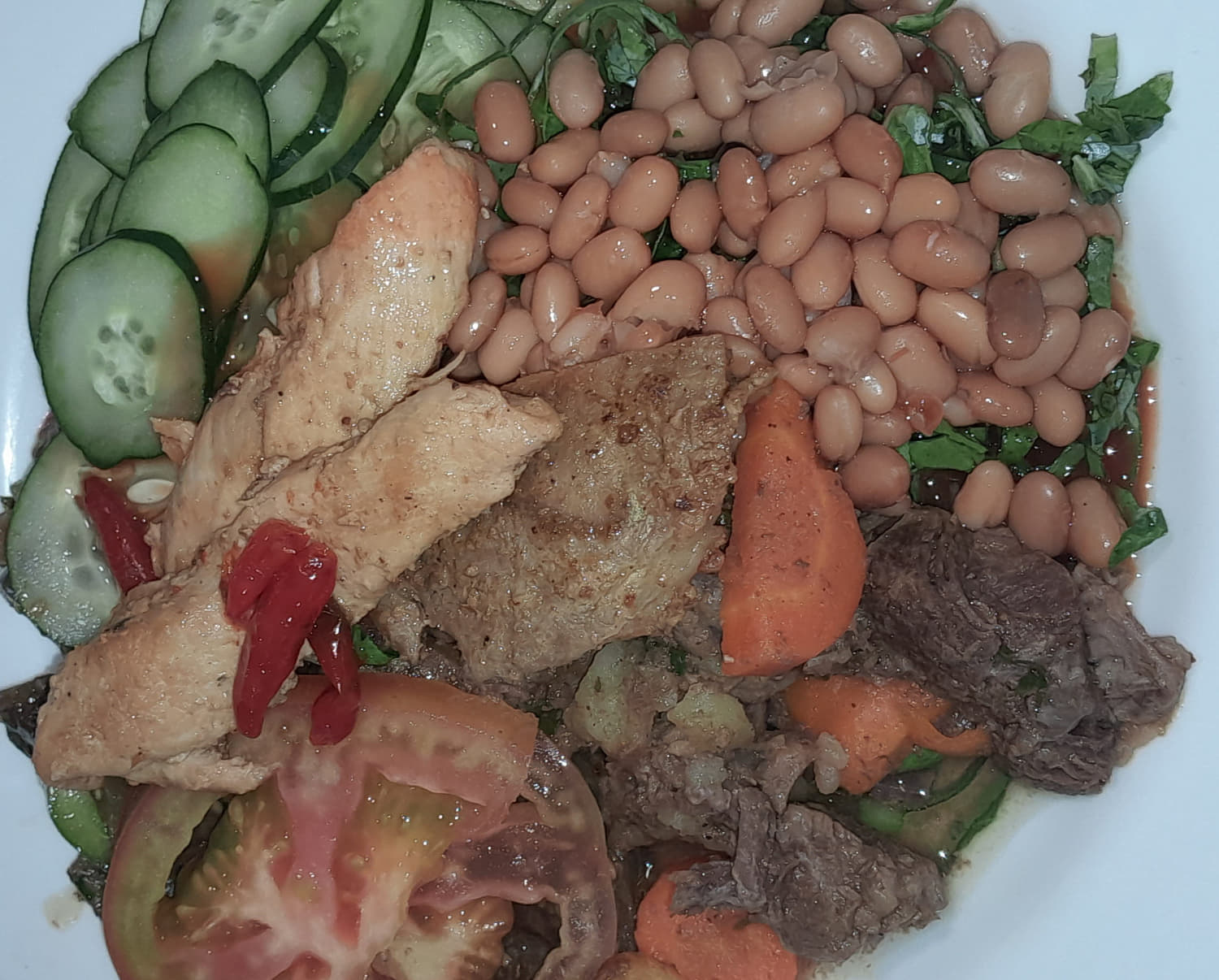

I had been waiting for 14 years to enjoy Passion Fruit Mousse - uniquely Brazilian specialty.

Pink guava in Fortaleza, ripen to perfection.

Mango was falling off the trees all over Brasil - abundant and tasty.
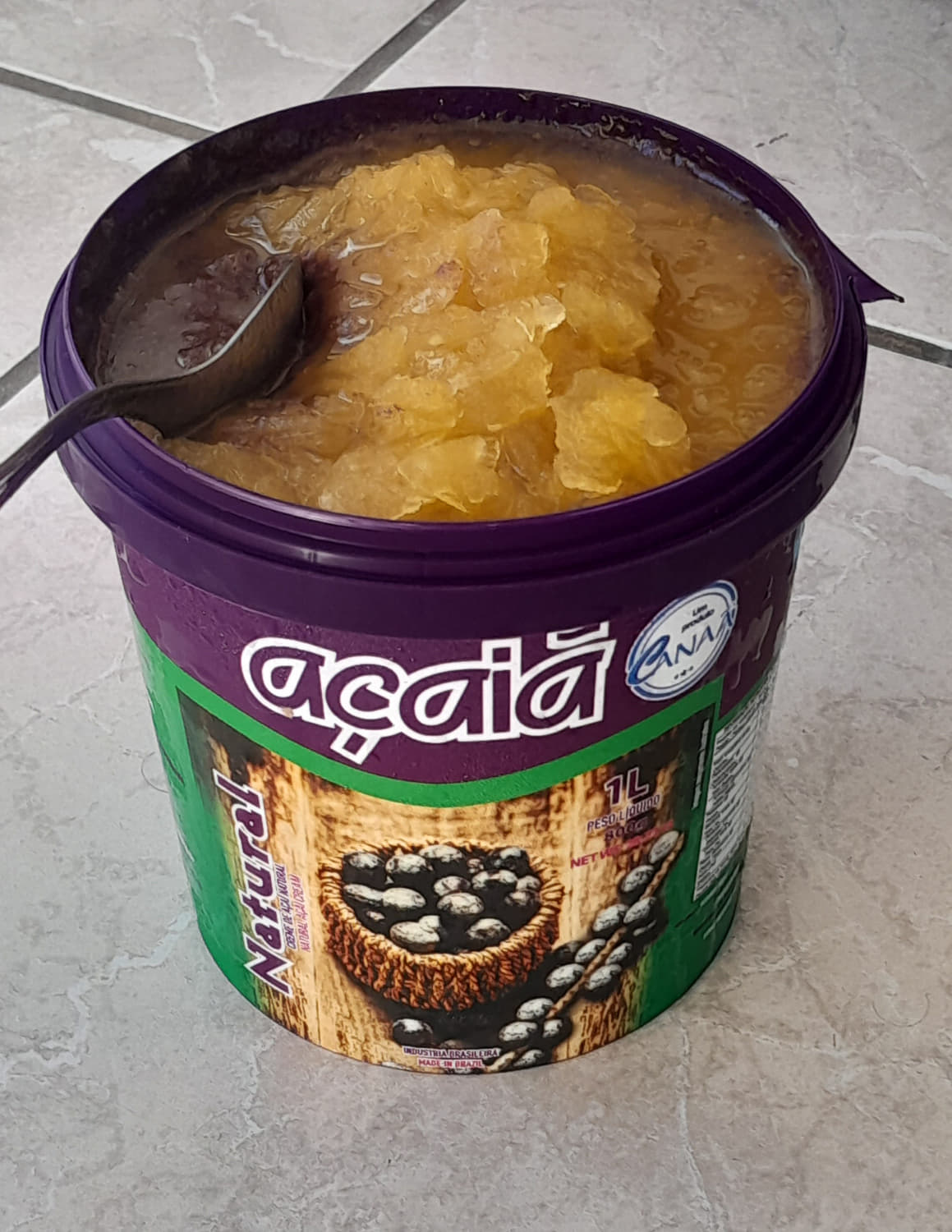
My tropical combo - Acai with Passion Fruit pulp on top.
Tropical juices of Colombia, Lulo and Passion Fruit, in particular, are my favorite. I ate some delicious cooked meals in Colombia too, especially at my host's house.

Lulo, ready to be blended with milk or water, my favorite.

Papaya with lemon or passion fruit.
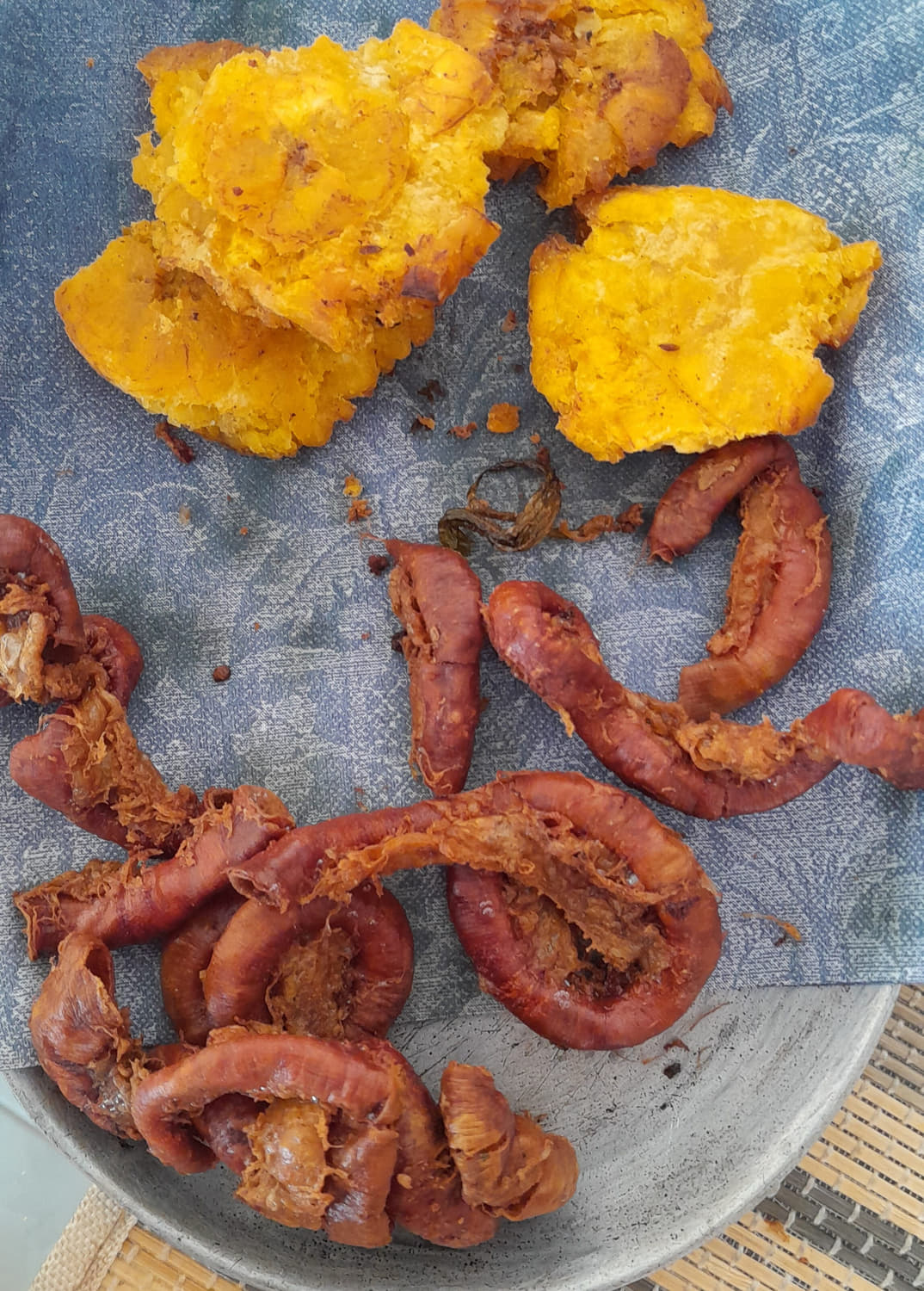
Chunchulo - grilled intestines (my host's secred ingredient was lemon juice .

Colombian grill.
I ate well in Chile, especially in Santiago in February at the peak of fruit season. Fresh, ripen on trees peaches were to die for. There was a great selection of cured meats and cheeses too. But for me, Chile is synonymous with amazing wines. I was looking forward for trying new wine every day while in Chile.

When I asked for a recommendation in a wine shop, a customer said " buy any wine over $4-5 and you won't regret". He was right!

Carmenere - French wine that grows only in S. America now.
While one is not safe from scams anywhere, travelers, especially in a foreign country, are more vulnerable and exposed to whoever wants to take advantage of them. I believe overwhelming majority of people are nice and more than eager to help, but, let's face it, there are bad apples in every family, let alone country.
Over the years I've had so many wonderful experiences with people all around the world. It's only normal to encounter some unpleasant situations and people or governments bent on taking advantage of you. Even though not worthy remembering or paying attention to, these are sour experiences from this trip:
Not to finish on a bad note, with pathetic people, I want to express my endless gratitude to the heroes I encountered on this trip. There were many more pleasant encounters and experiences, but I will list only the most important:
My other adventure rides: